|
Click on the pictures to
enlarge them.

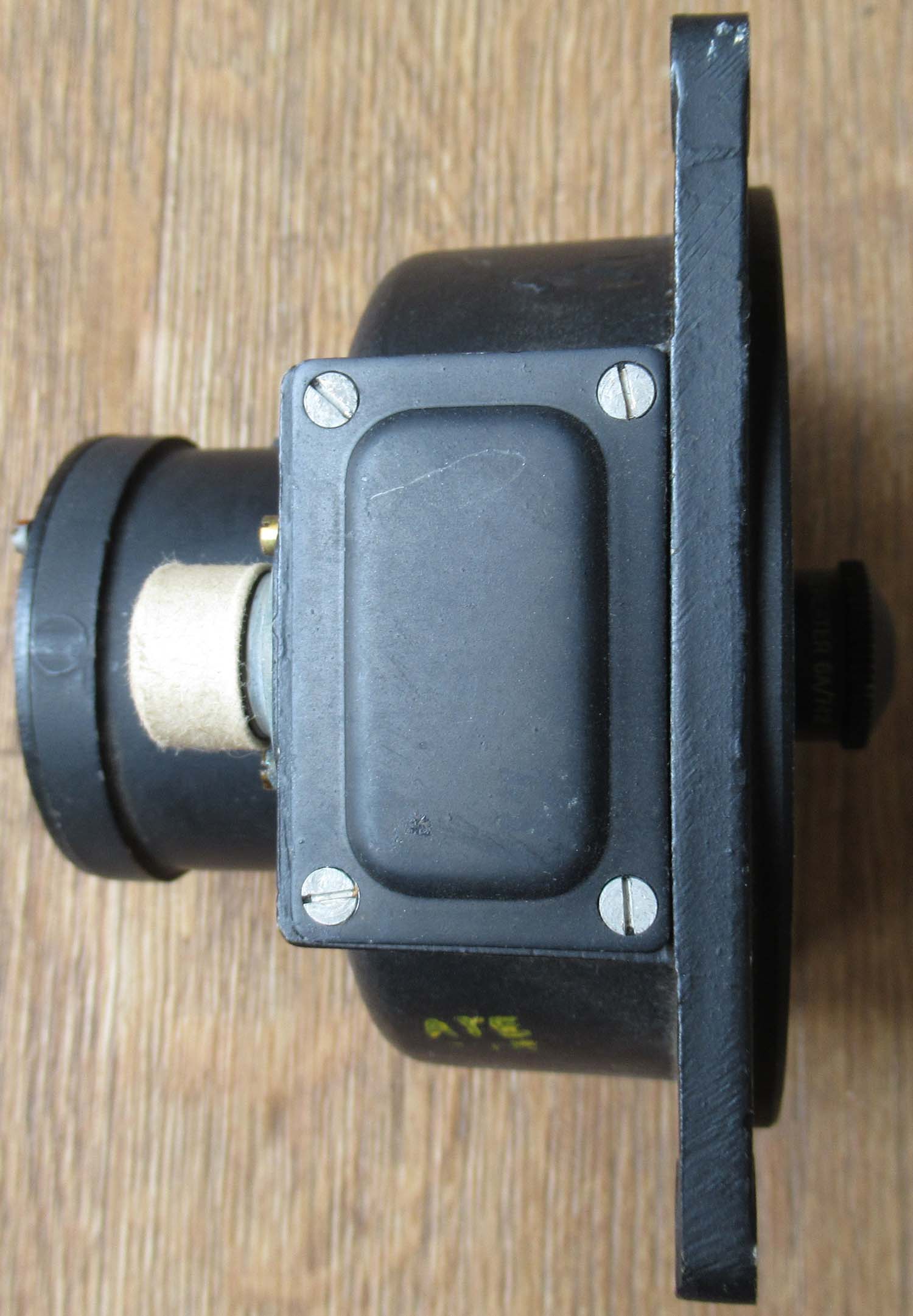
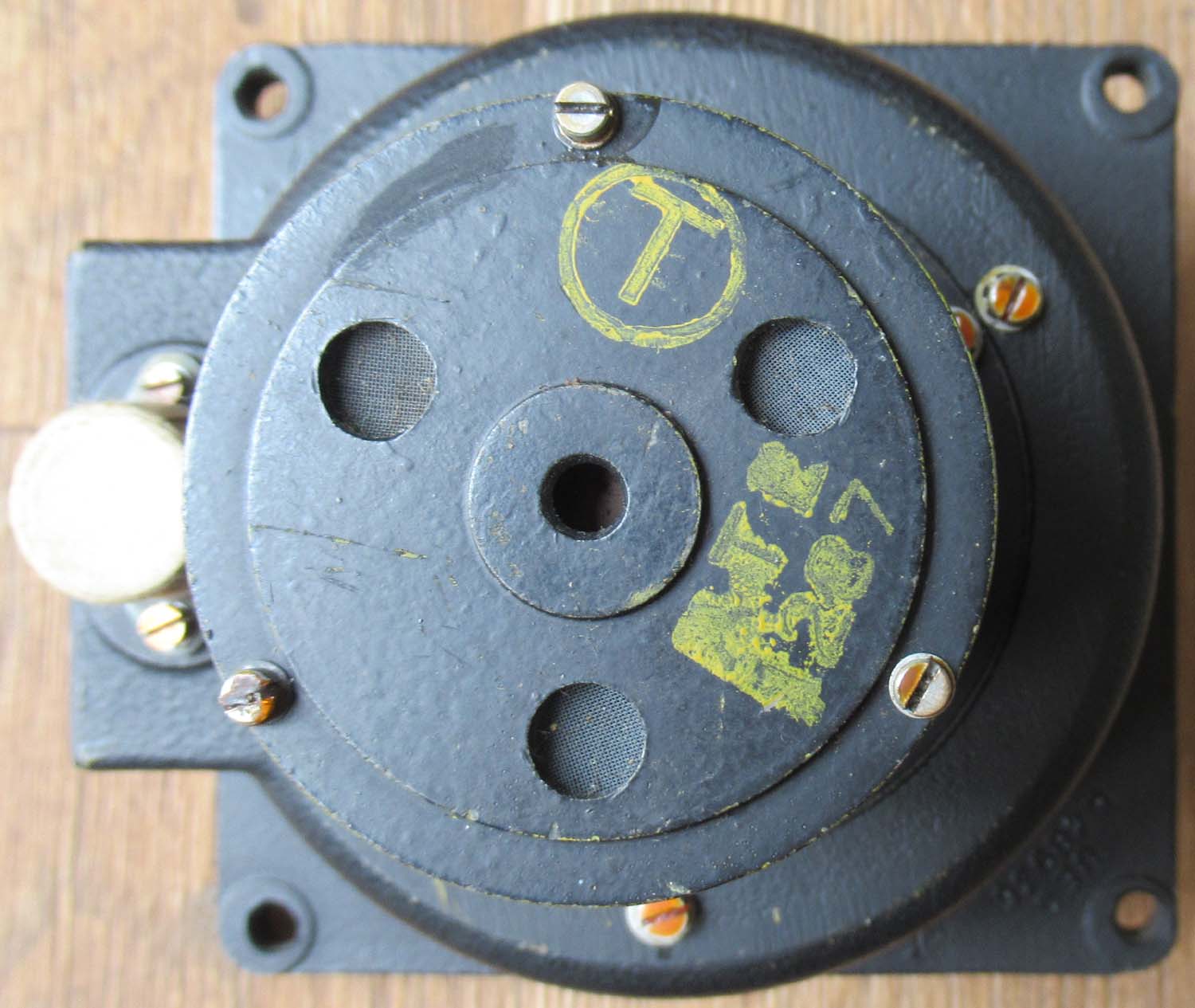 |
Repeater Compass
(Pg 5 Compasses
and Clocks 54A)
Ref:
6A/742 Dated
1944
Seen in situ in
a Lancaster below.

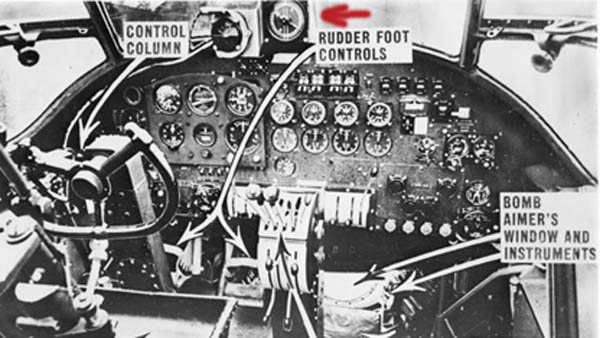 
Here is a
repeater compass in really nice original condition.
Fitted commonly to
Lancaster's although this was used long before Lancaster's
became operational and fitted to other long range aircraft
including the Sunderland, Halifax and Wellington Bomber..
The
Distant Reading Compass was standard equipment in most
multi-engine aircraft in the RAF throughout World War II
until it was replaced by the Sperry ‘Gyrosyn’ compass.
It
consists of a master unit containing both the gyro and
magnetic elements normally stowed in a part of the aircraft
away from large masses of magnetic material which would
distort the Earth’s magnetic field.
This
master unit feeds, through an electrical transmission
system, repeater compass cards on the pilot’s and
navigator’s panels and wherever heading indications are
required. The complete compass system operates from the
aircraft 24 V DC supply.
The
pilot or navigator has control switches for starting and
stopping the master unit and a variation setting corrector
control to adjust the repeaters to read true instead of
magnetic heading. A complete system comprises a master unit,
variation setting corrector, a control switch box and a
number of repeaters.
The
master unit holds the magnetic element, the gyroscope, the
monitoring and follow-up mechanism and the transmitter for
operating the repeaters. The complete assembly is suspended
in gimbals.
The system uses an electric magnetic inductor element fixed
to the aircraft in azimuth which detects the direction of
the Earth’s magnetic field relative to the aircraft and
transmits this information electrically to the gyro element.
£150


|
|
Click on
pictures to enlarge
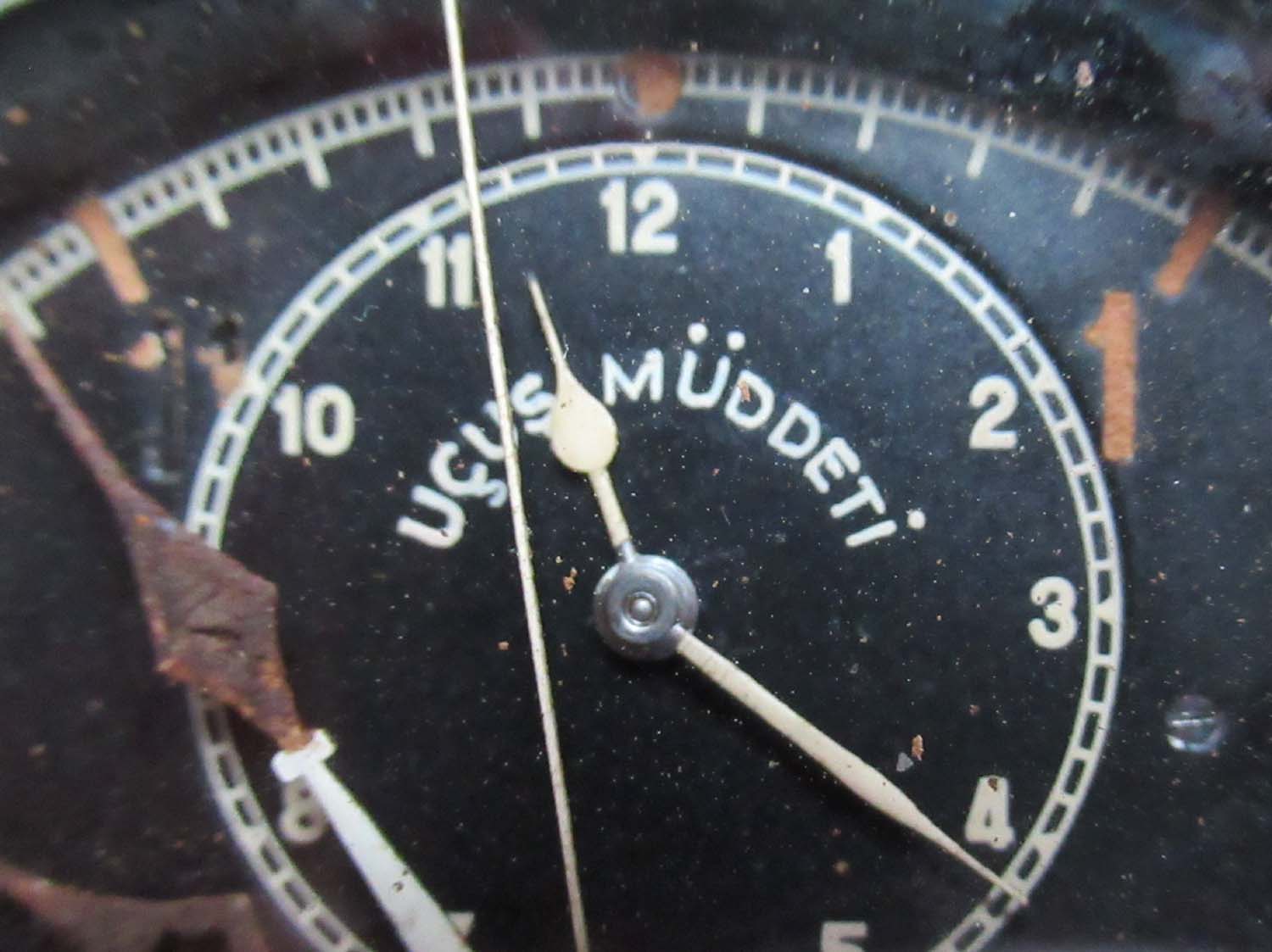
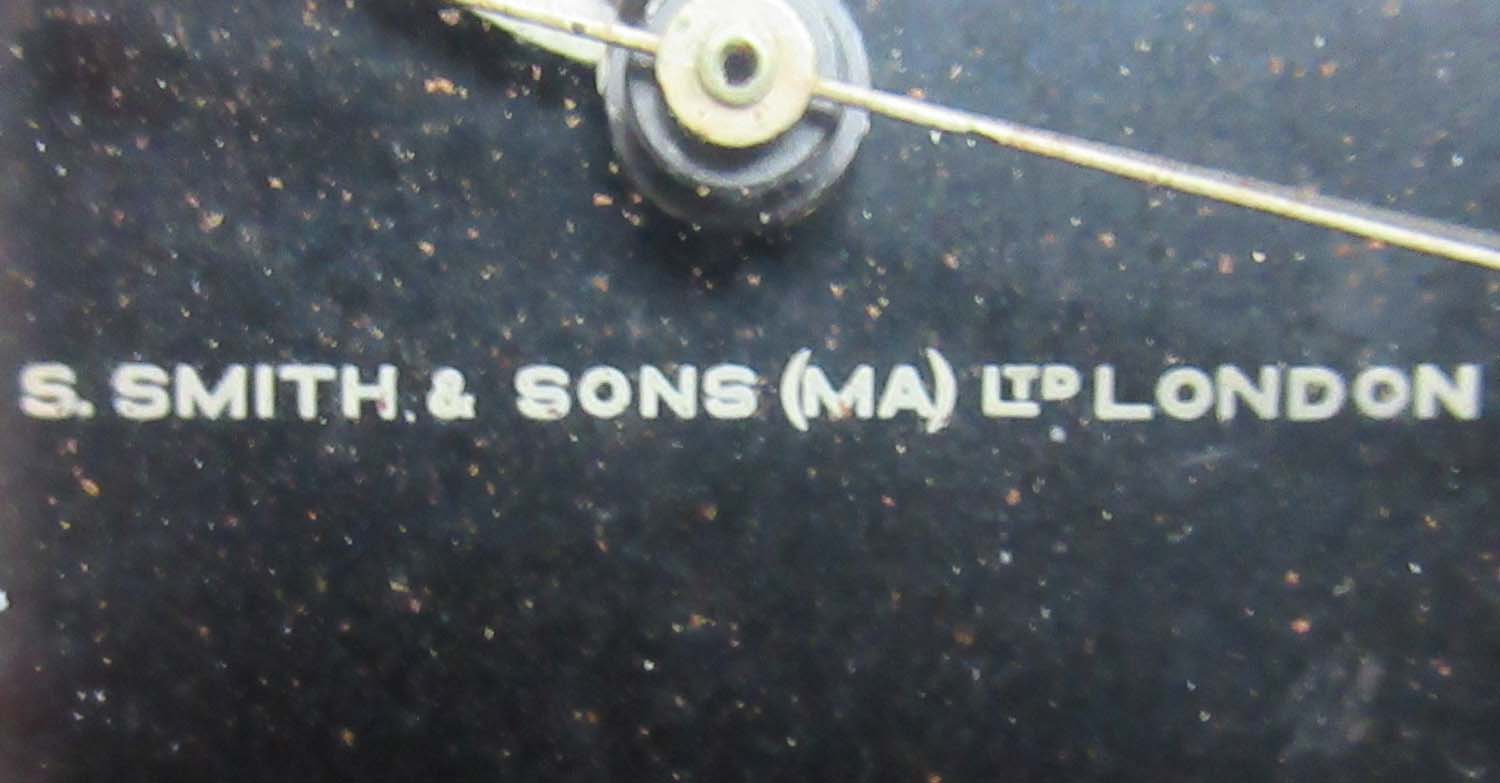
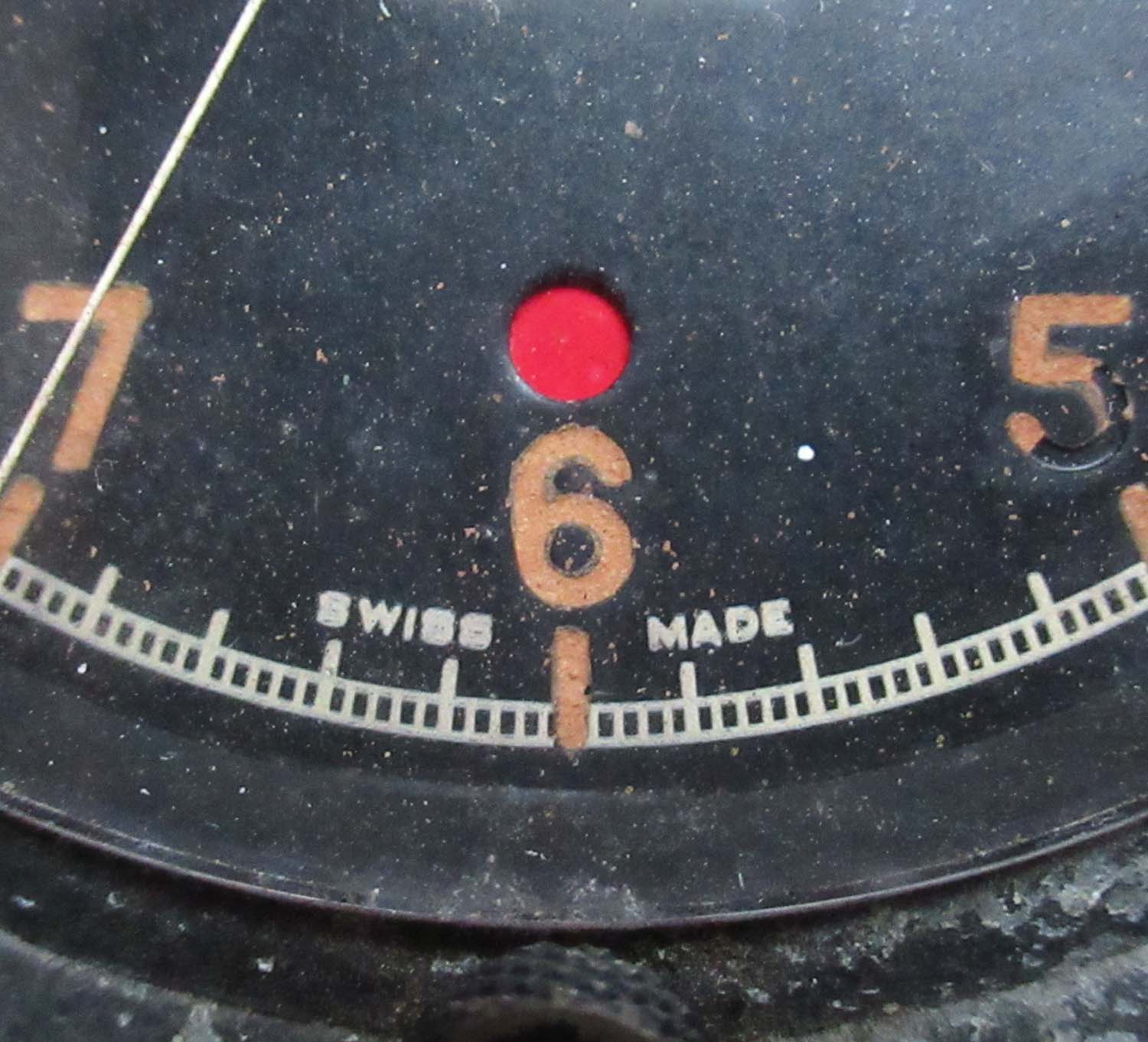
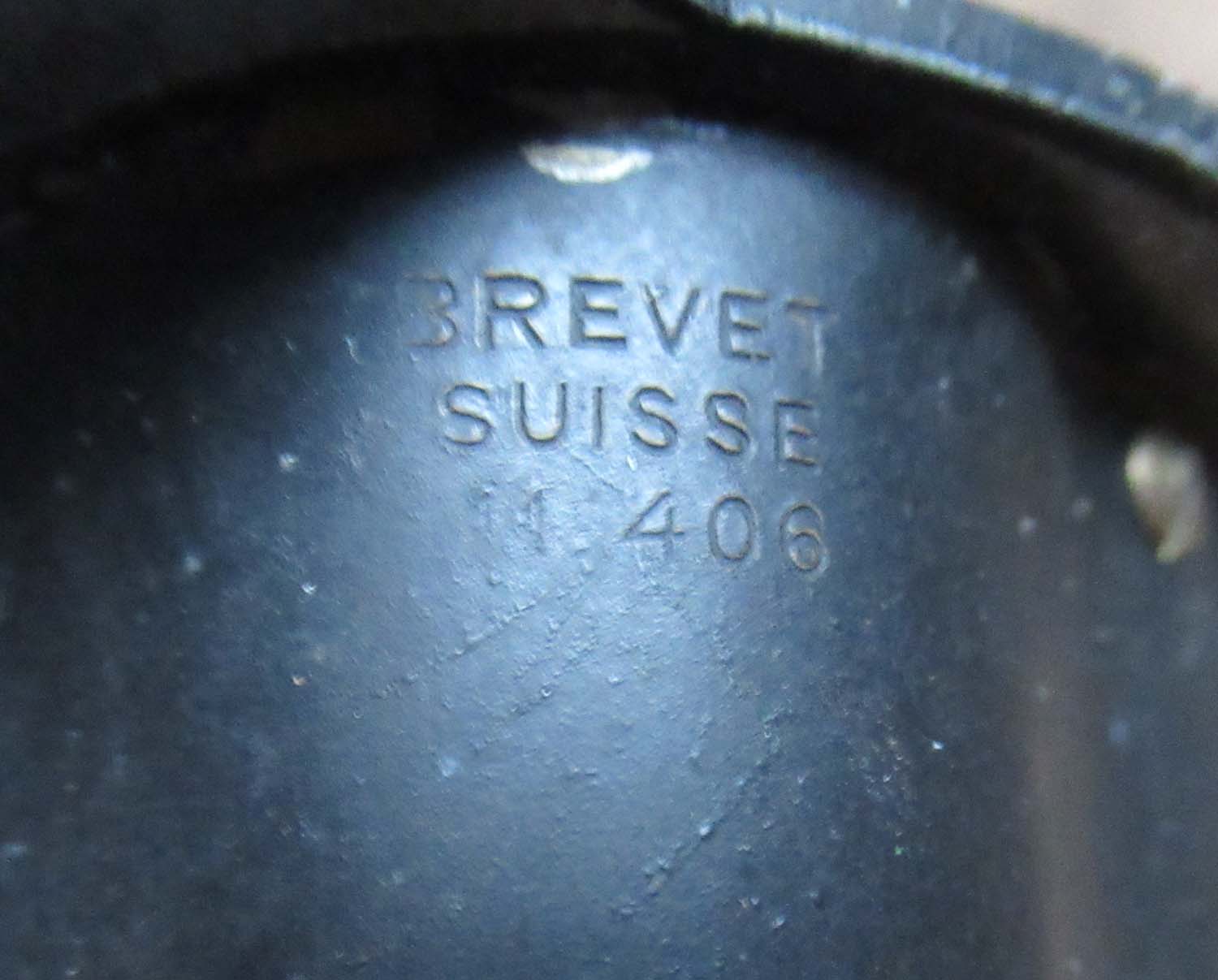
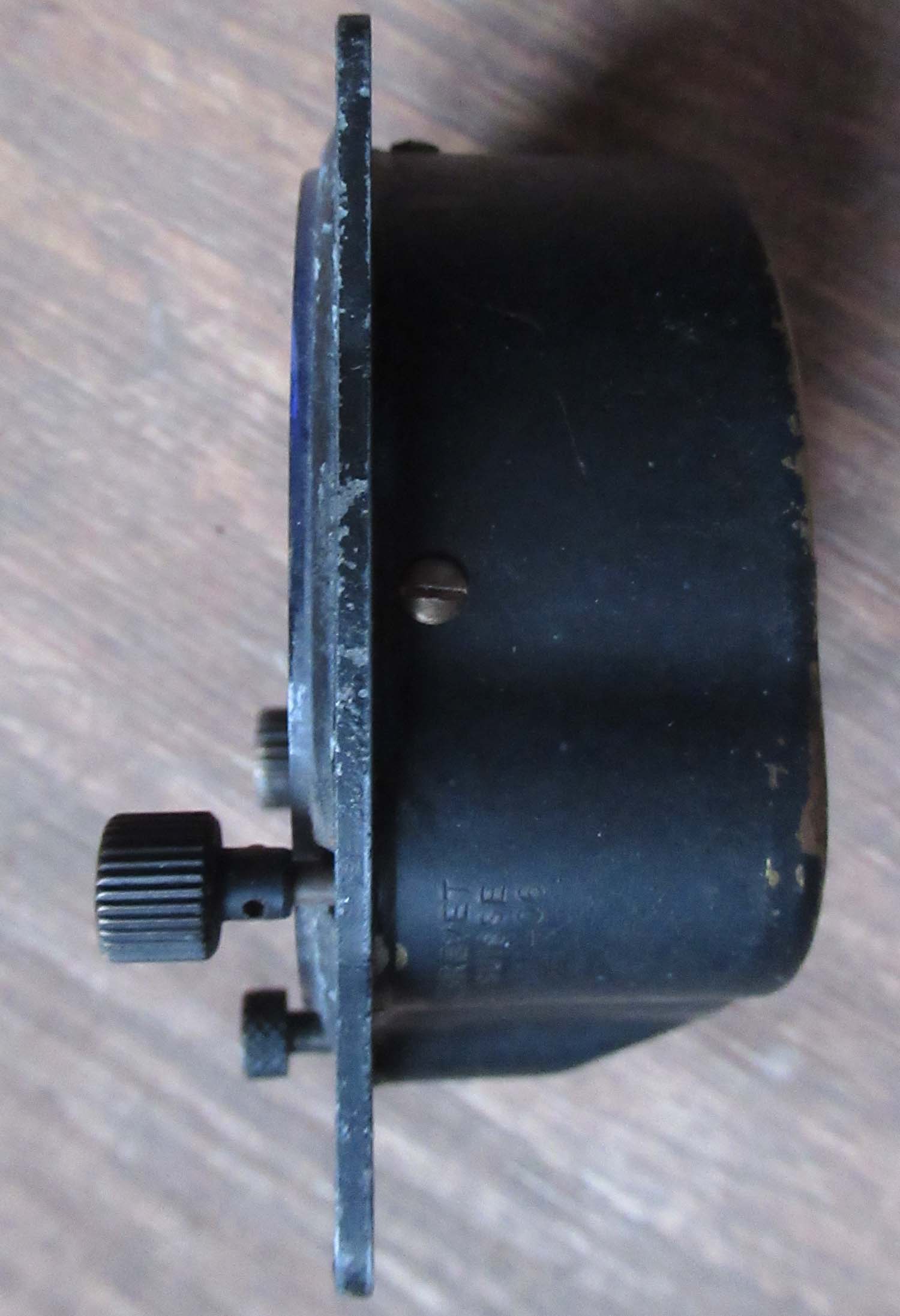
|
MK III Smiths 8 day Clock (Pg 5 Compasses and Clocks
84)
This is the classic
Swiss made 8 day clock by Smith & Sons London. Fitted in early
Spitfire and Hurricanes, along with other wartime and pre war
RAF aircraft.
This clock is in good original condition
and has run for three days without any issues and gained 20 minutes.
Ref No: 108472
Brevet Suisse: 11 406
Click on
pictures to enlarge
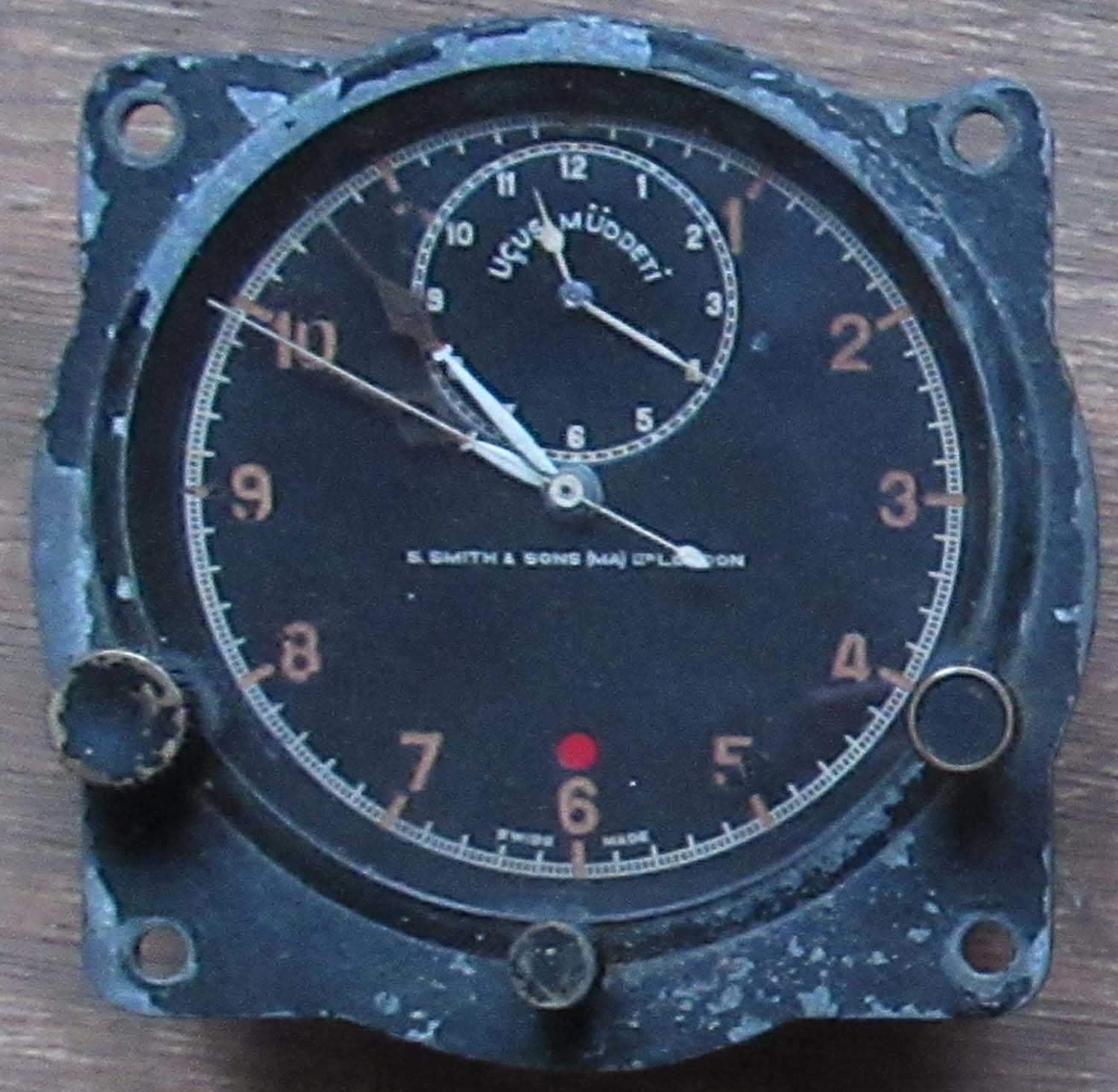
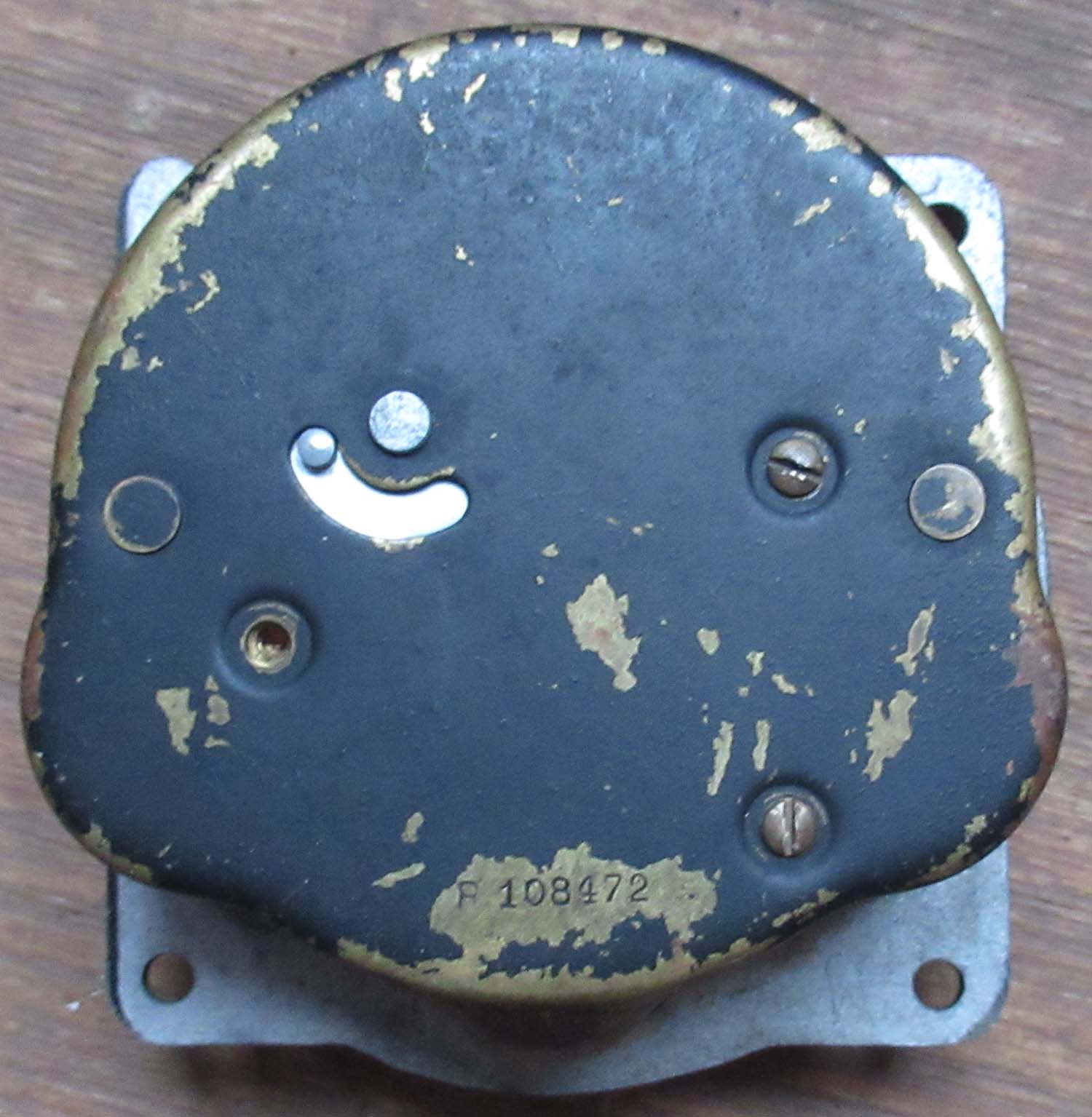
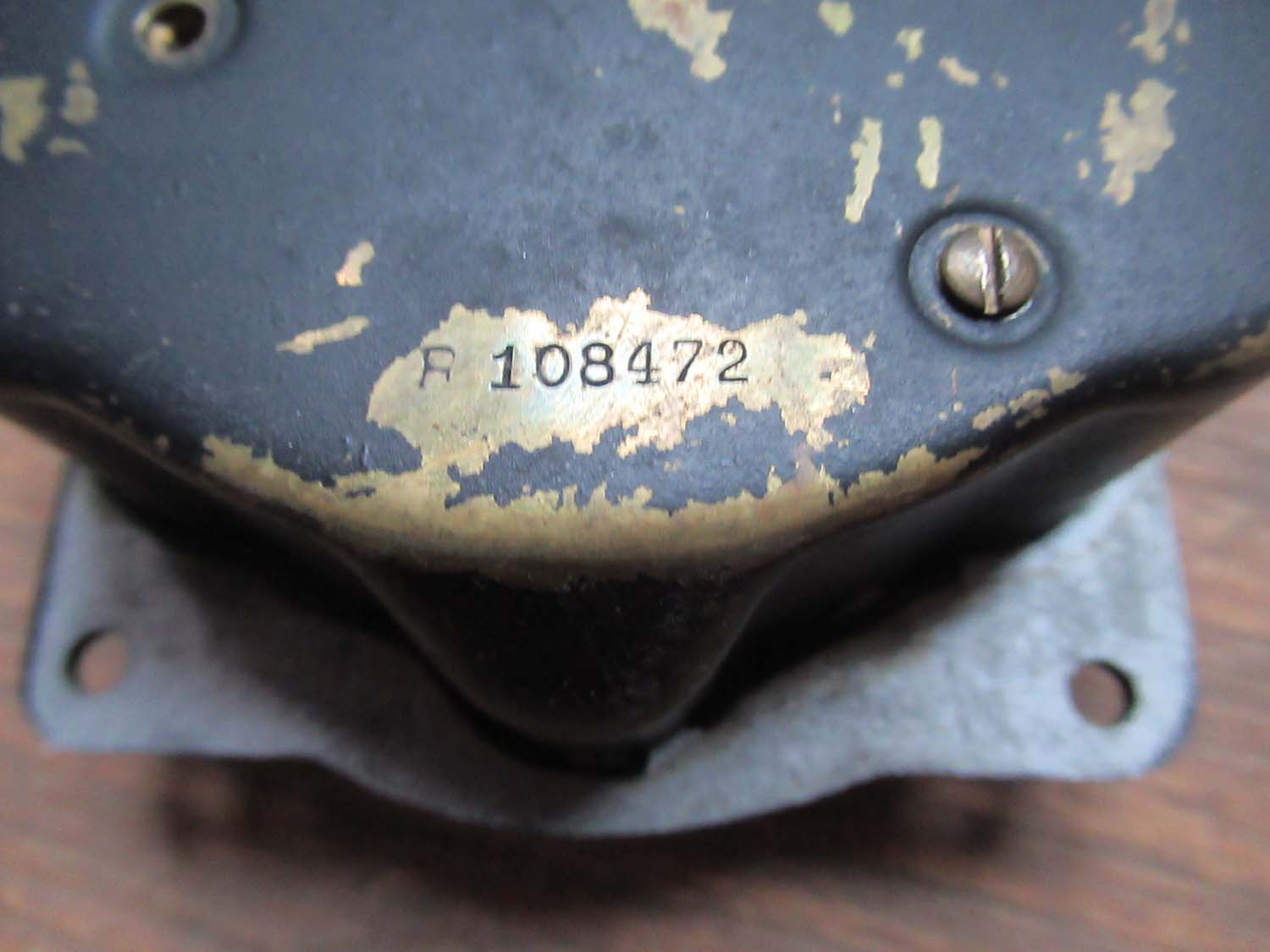
This one is unusual and is not AM marked
it has ucus muddeti on the top dial which translates to flight duration.
The translator is telling me the
language is Azerbaijani.
Many Azerbaijanis also fought as members of the resistance in France, Italy,
Poland, the Netherlands and Yugoslavia.
128 citizens of Azerbaijan were conferred on title of Hero of the Soviet Union
for their valour during the war.
Azerbaijan
was part of the old Soviet Union,
looking at cockpit pictures of Russian aircraft they used a
variety of this kind of clock
so I think its highly likely this could of been fitted to a Russian aircraft
or one of the Hurricanes imported from the UK, the Russians
also operated small numbers of Spitfires.
Amazingly
and something I did not know about before researching this piece is that
Azerbaijan had female combat aircrew which as far as I am
aware were the only Women to fly in combat in WWII.
One particular Pilot Zuleykha Seyidmammadova
in World War II, was the regimental navigator of the 586th Fighter Aviation
Regiment, one of the three women's military aviation regiments founded by Marina
Raskova.
Throughout the war, she fought in over 40 aerial battles and carried out over
500 missions.
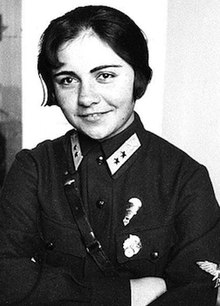
Zuleykha Seyidmammadova
£895


|
|
Click on
pictures to enlarge


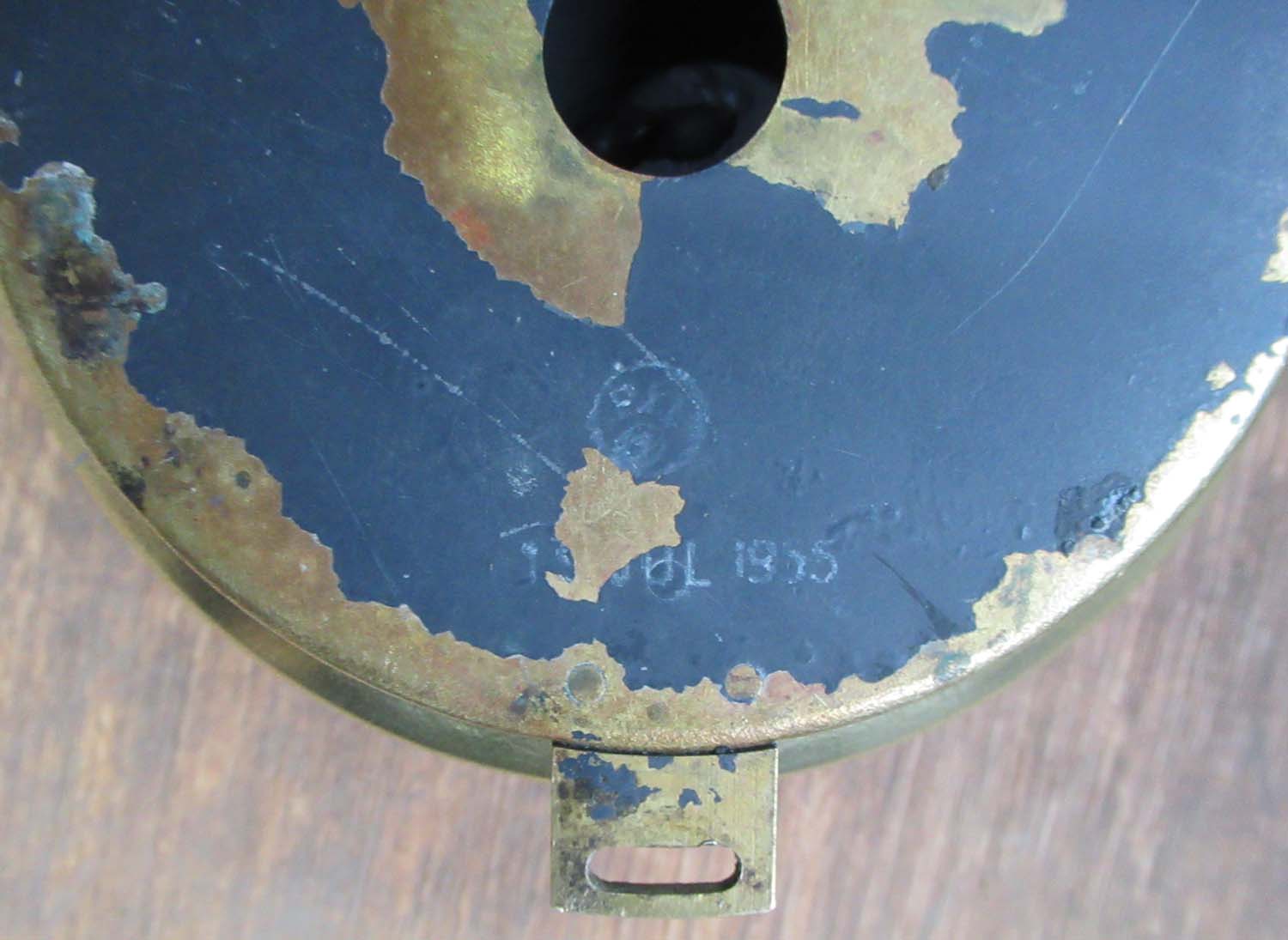 |
Type P8 Spitfire Compass
(Pg 5 Compasses and Clocks 83)
Here we have a Type P8
compass used mostly in the Spitfire this one has been
stripped back to its brass and polished in good original
condition and still contains its fluid. A really nice
example of the wartime compass fitted to all Marks of
Spitfire. It cannot be under estimated how much work it is
to strip and polish this but certainly many hours of work.
6A/1672
Click on
pictures to enlarge



Out of
stock more wanted please
contact me |
|
Click on
pictures to enlarge


 |
Type P10 Compass
(Pg 5 Compasses and Clocks 82)
Here we have a type P10
compass used in the Lancaster and Halifax heavy bombers. The
top is missing some bolts and is loose.
No: 2680T
6B/1671
Click on
pictures to enlarge


£125


|
|
Click on
pictures to enlarge
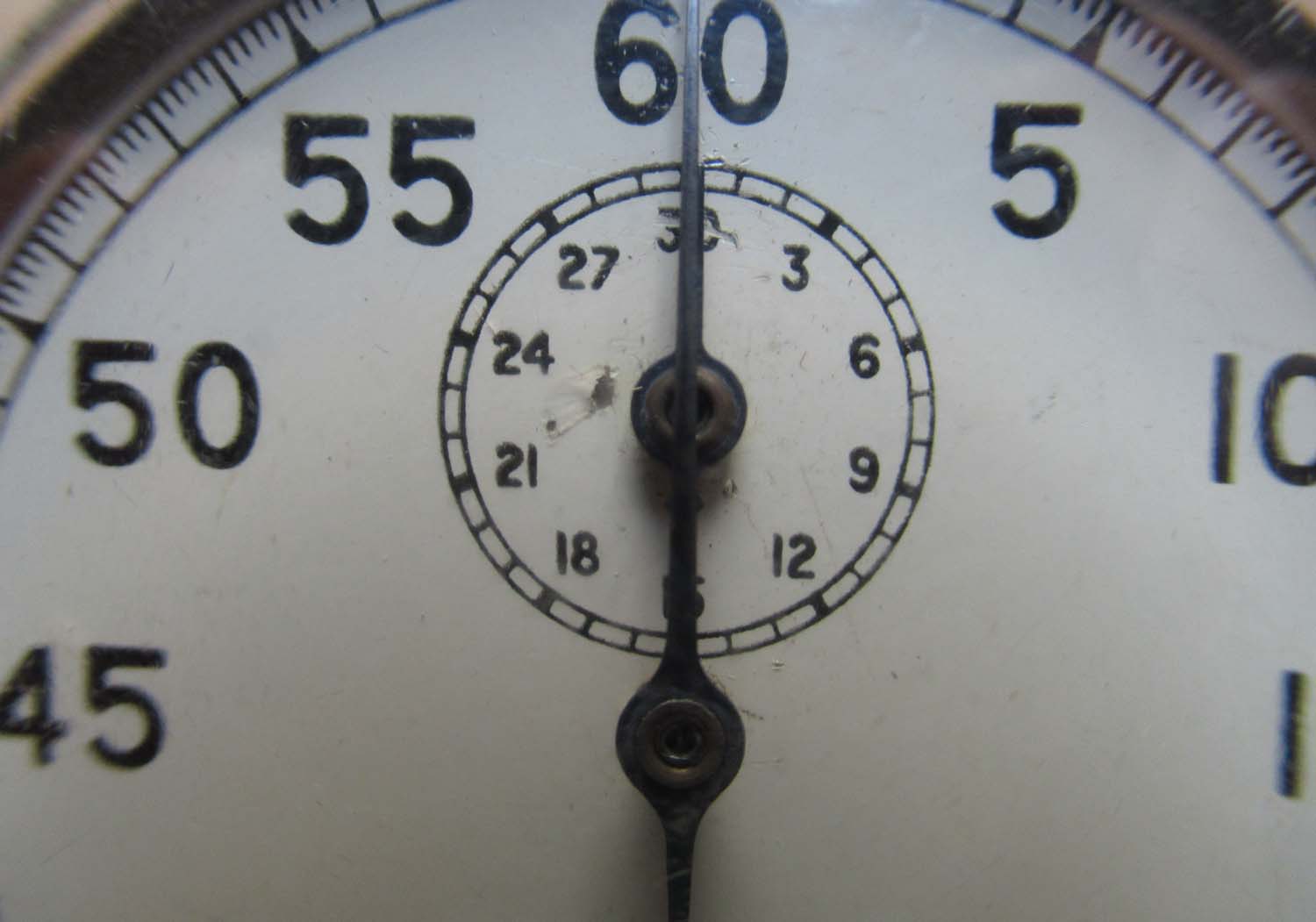
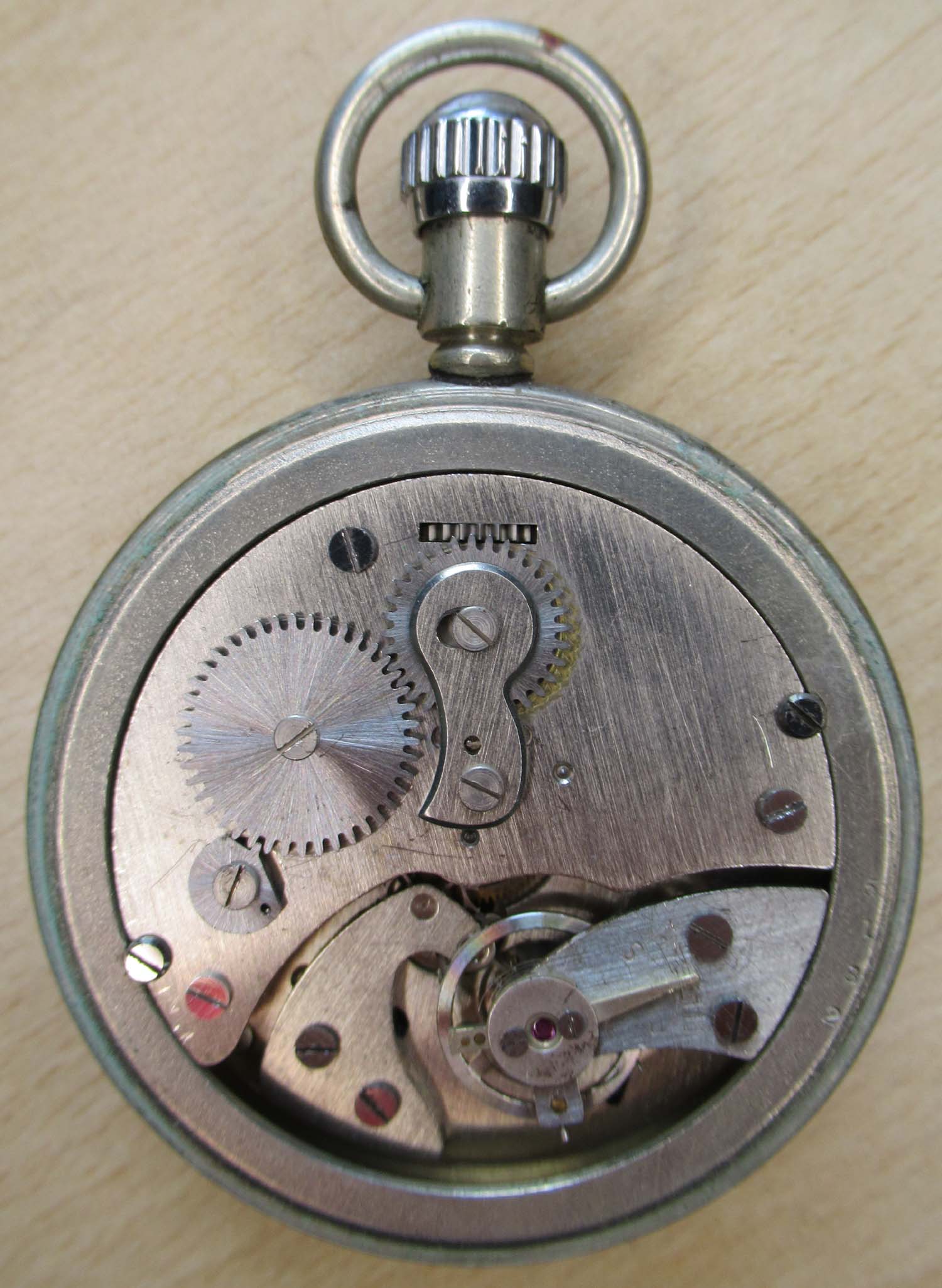
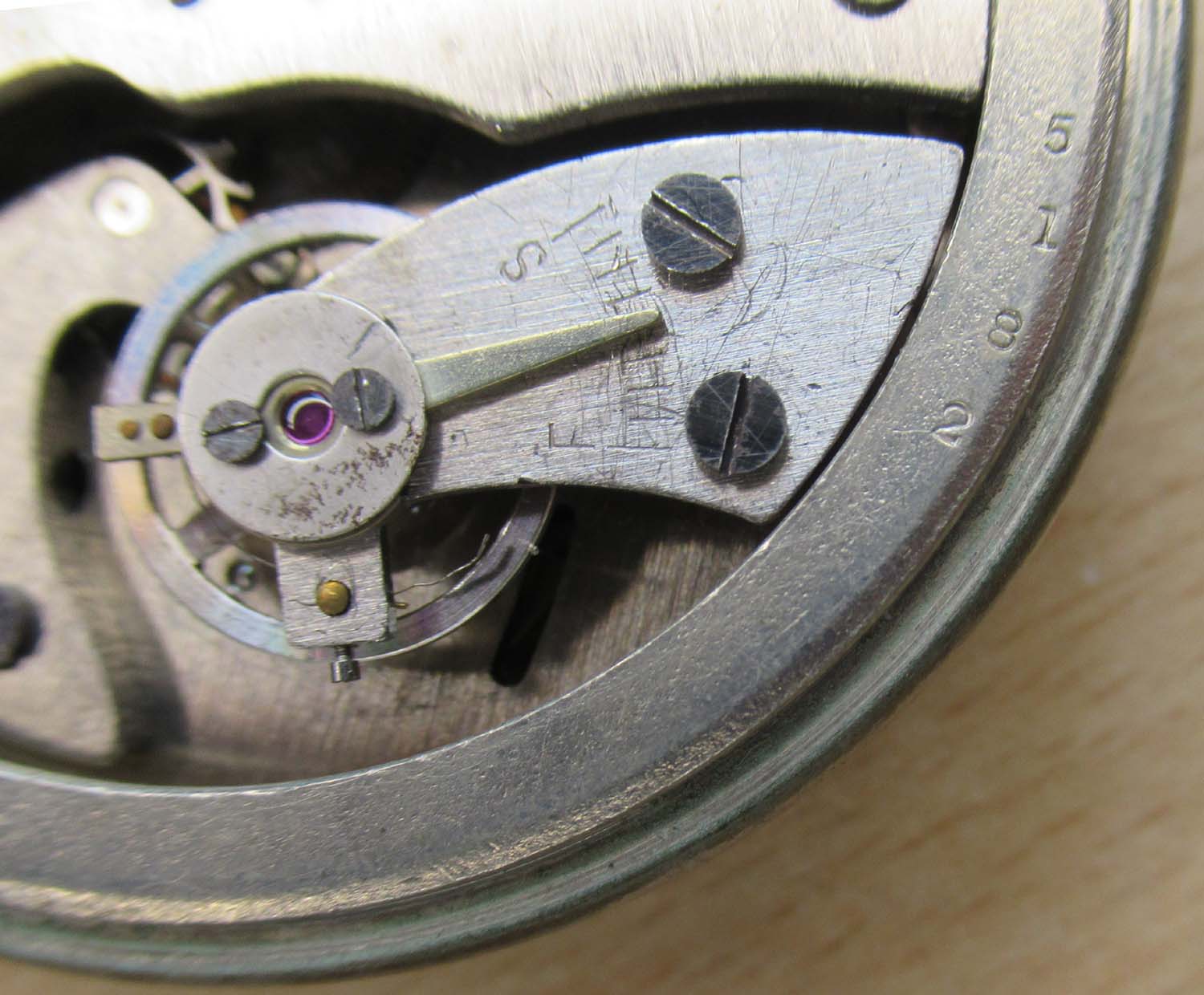 |
RAF Navigators
stop watch
(Pg 5 Compasses and Clocks 81)
Here we have a nice
example of a stop watch issued to RAF navigators. In good
working order. Used by navigators to time course changes .
Dated 1944
6B/117
6B= Aircraft
navigation equipment.
Click on
pictures to enlarge
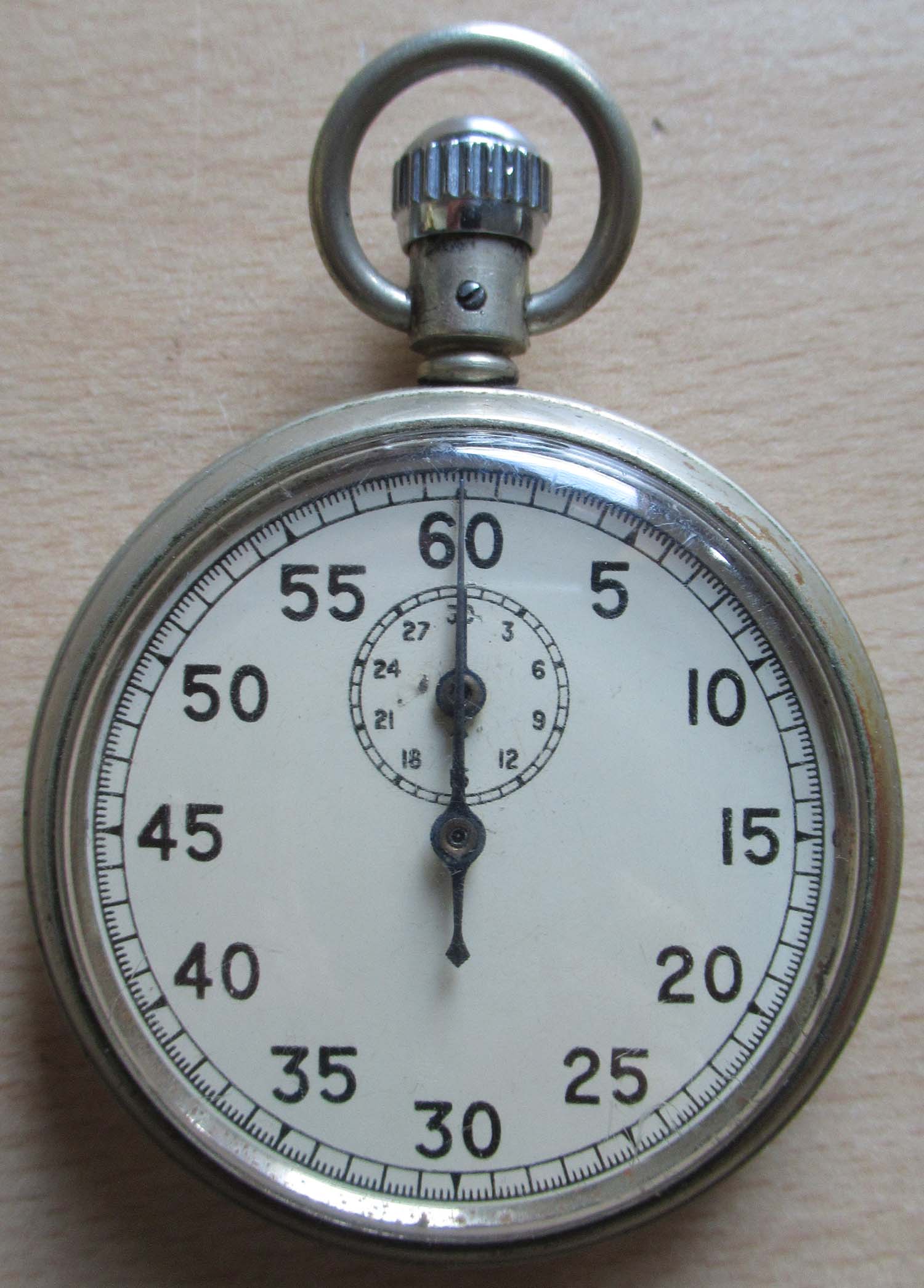

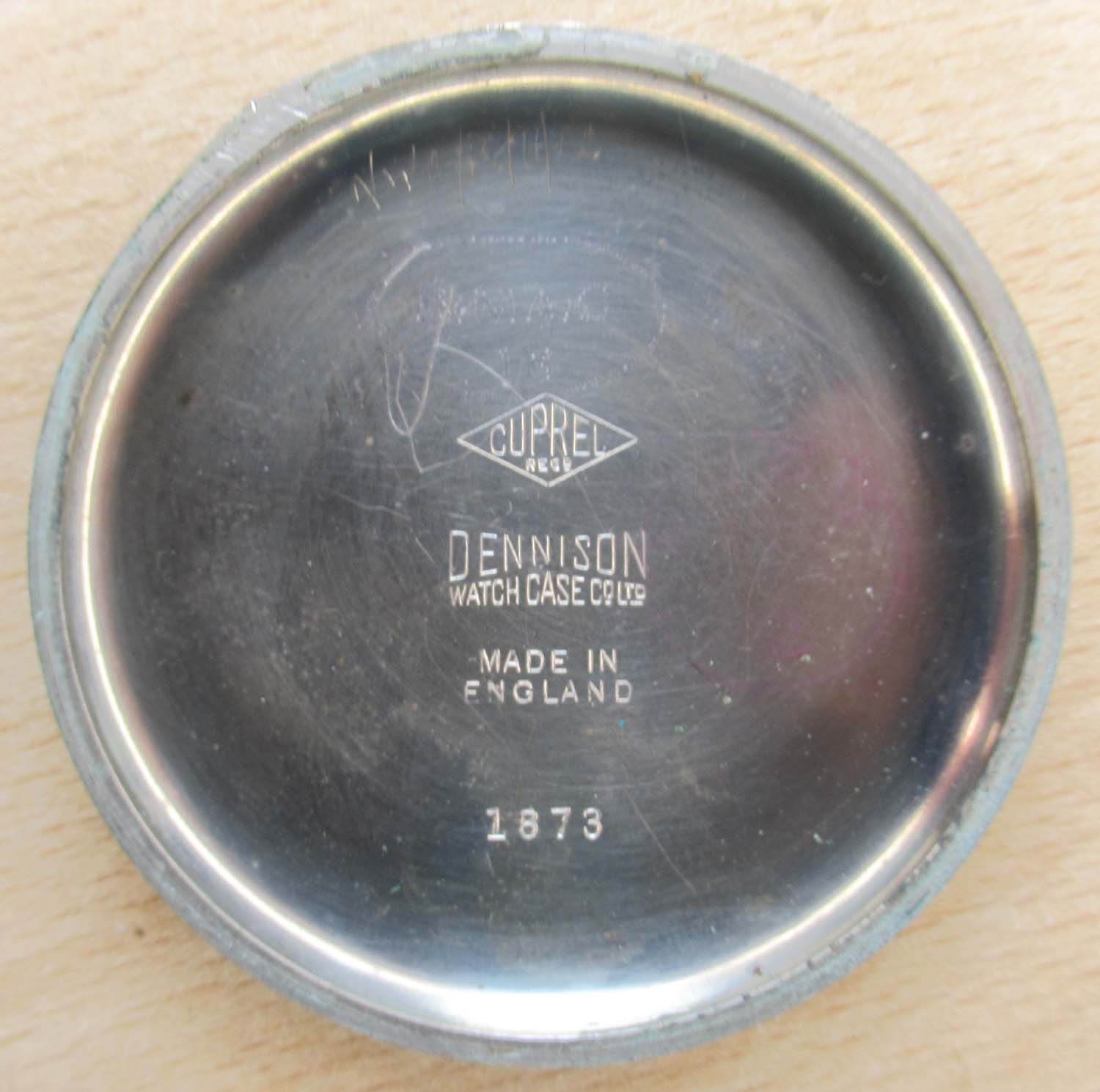
Out of
stock more wanted please
contact me |
|
Click on
pictures to enlarge


 |
Type P8 Compass
(Pg 5 Compasses and Clocks 80)
Here we have a Type P8
M
Compass. Used in fighters, most commonly found in the
Spitfire.
The compass has had some
heavy use and has some paint loss and no fluid. It is also
missing one lug and a wire. The bezzel is cracked, as shown
in photo.
6A/726
Click on
pictures to enlarge



£155


|
|
Click on
pictures to enlarge



|
Rare German
Airforce Wrist Compass (pg
5 Clocks and compasses 79)
This is a rare peace from WWII.
A first model pilots or observers compass that could be worn on the leg or
arm. It is complete with its original strap. It also retains its original fluid.
Manufactured by Kadlec Instrumenten Fabrik Parc.
ID No: 48292
FL 23235
Click on
pictures to enlarge


Out of
stock more wanted please
contact me |
|
Click on
pictures to enlarge



 |
STOWA German WWII Pilot Watch F1
23883 (Pg 5
Compasses and Clocks 78)
Here we have a rare 20 jewel, WWII Stowa
Luftwaffe pilot watch.
Stowa watches that began in 1927. This watch was
made in Pforzheim, Germany.
In working condition.
The back can be popped off.
These watches are oversized and known for their
incredible built quality and reliability despite spending the last 40 years in a
drawer it still works.
6378
F1 23883
H1177B
D344
HB94650
Click on
pictures to enlarge


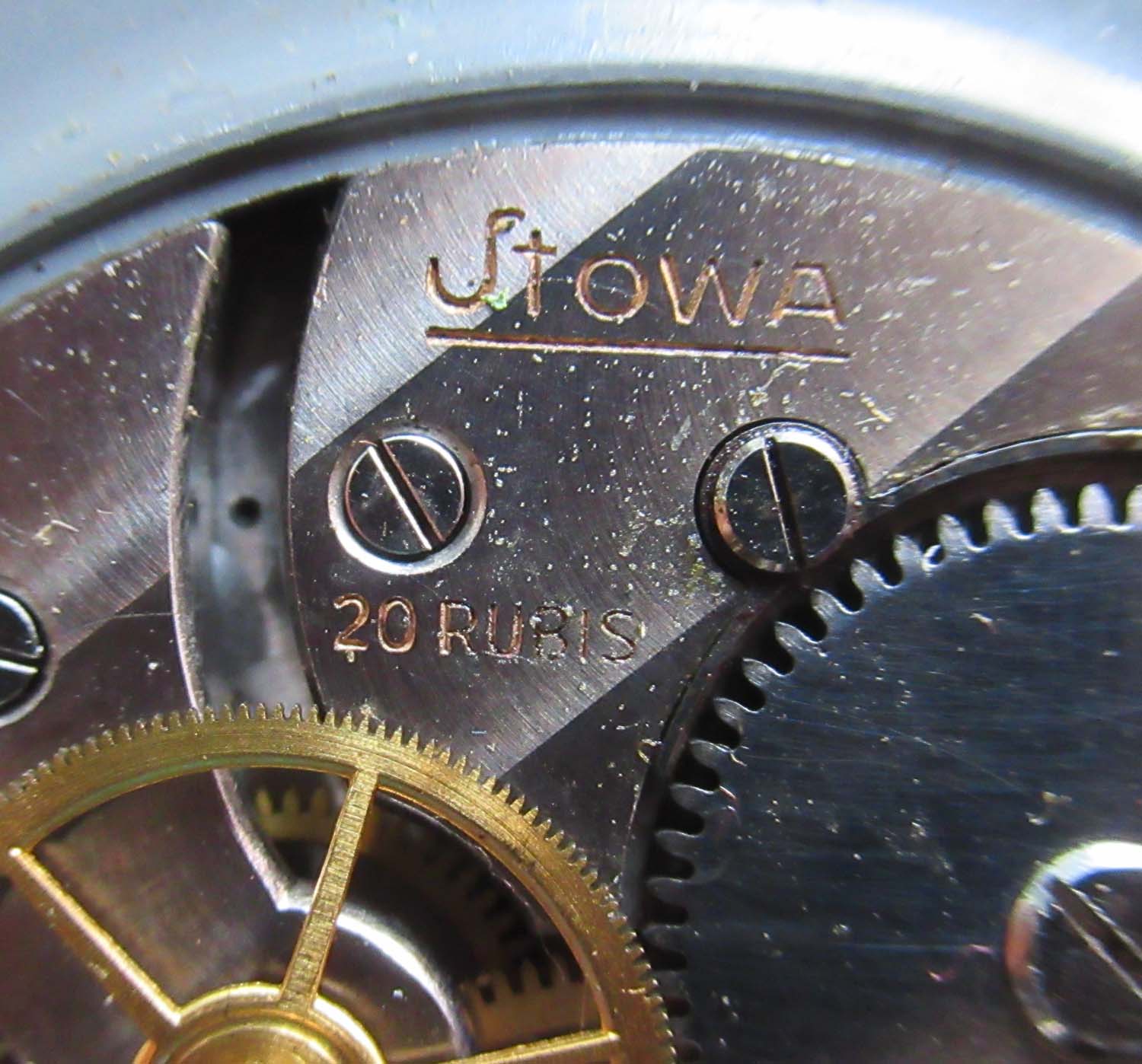
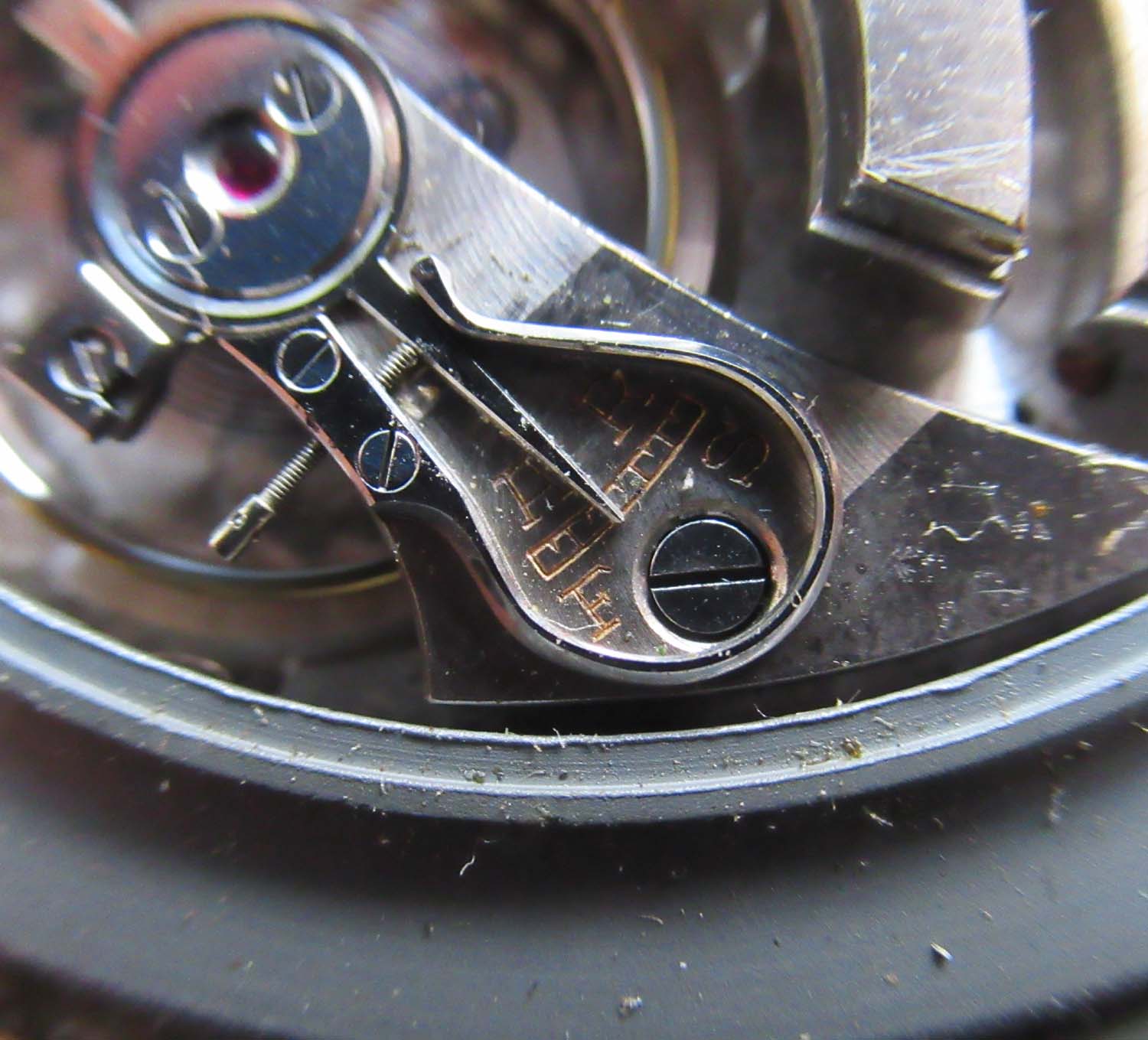
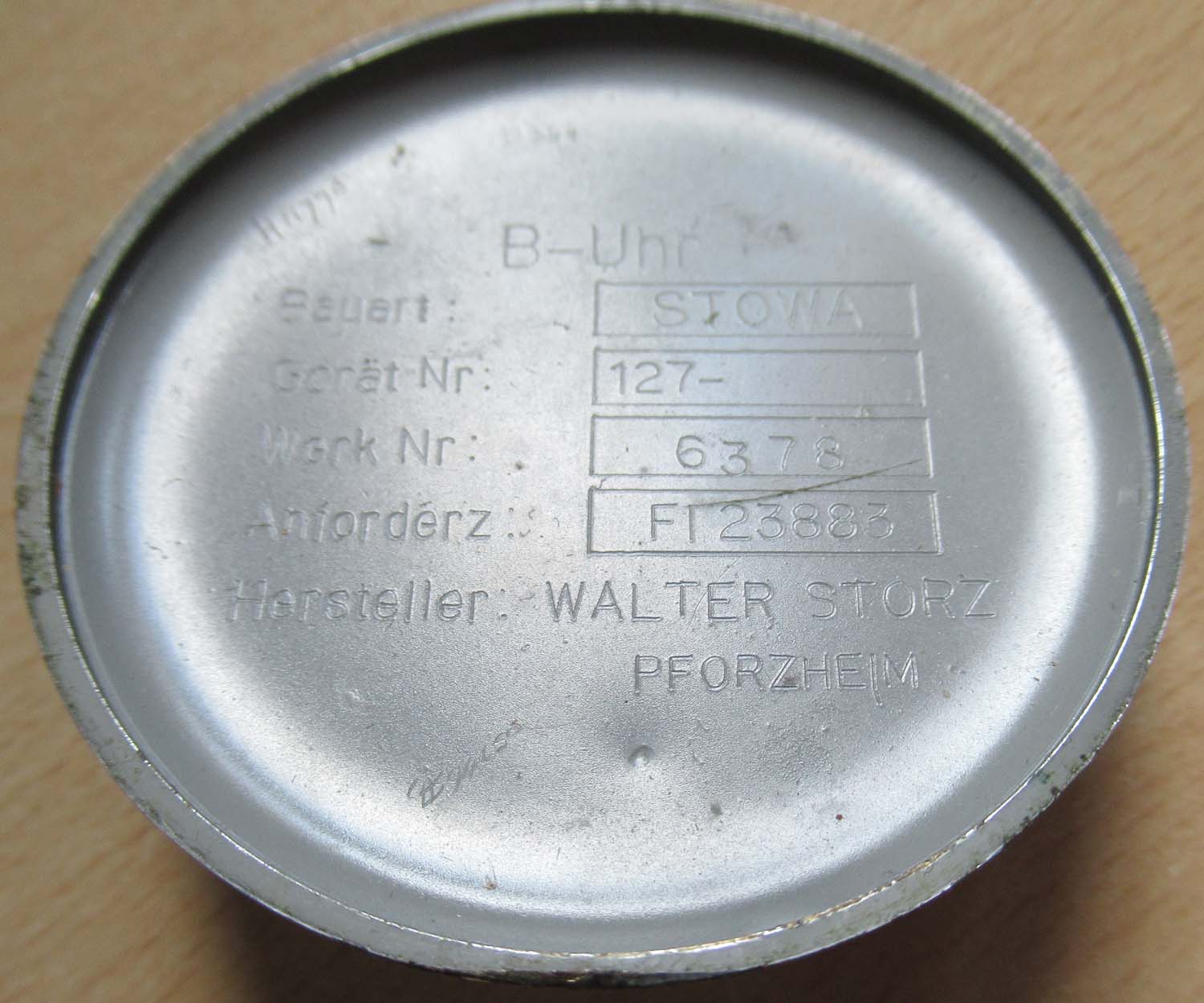
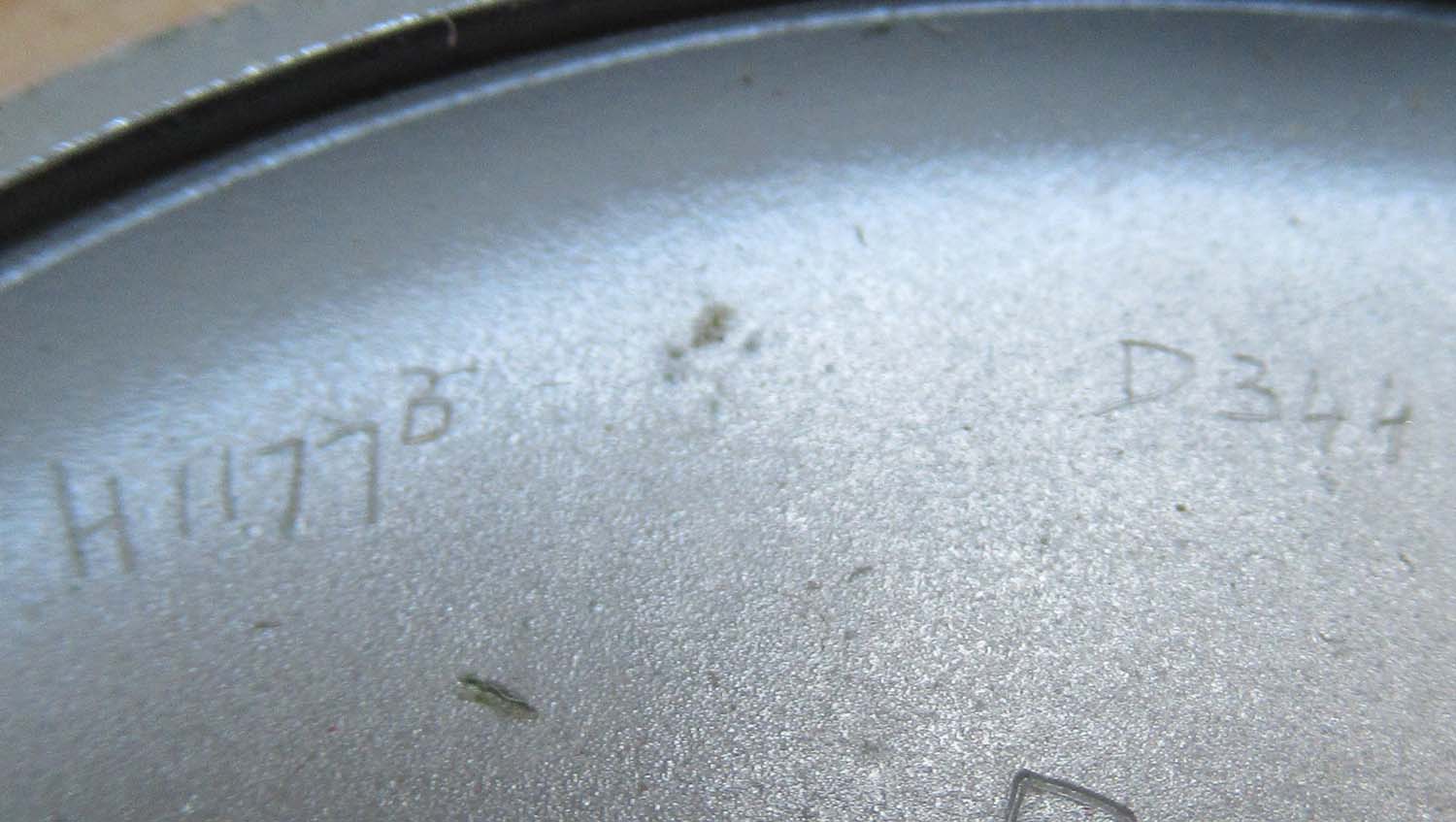
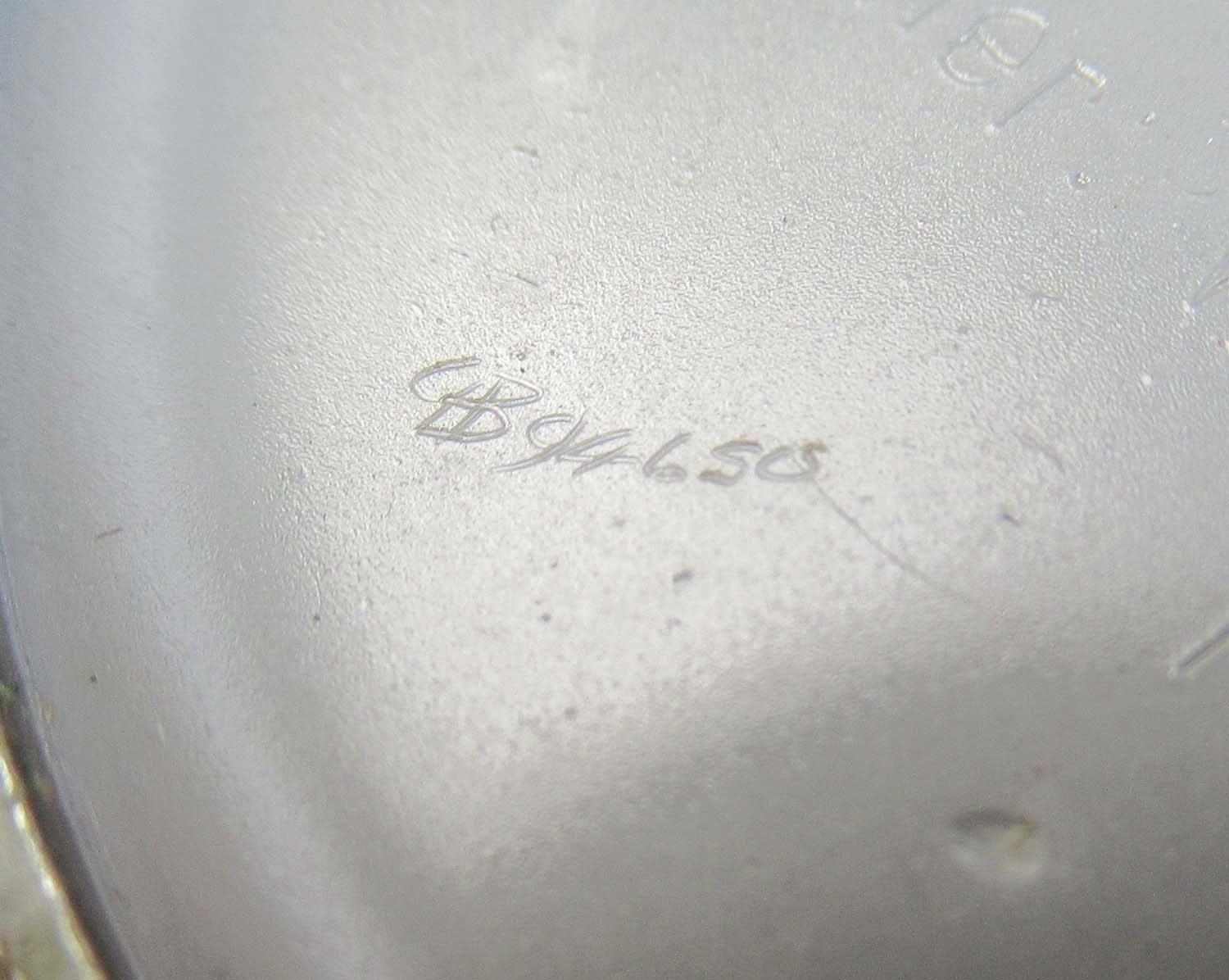
Out of
stock more wanted please contact me |
|
Click on
pictures to enlarge


 |
8 Day Clock Dated 1941 (Pg 5
Compasses and Clocks 77)
Here we have an 8 day clock.
It is in working condition, but has lost 3 hours
in 48 hours running so far.
Air Ministry marked
We can just make out the numbers
on the face:
31814/41
Click on
pictures to enlarge


£295


|
|
Click on
pictures to enlarge
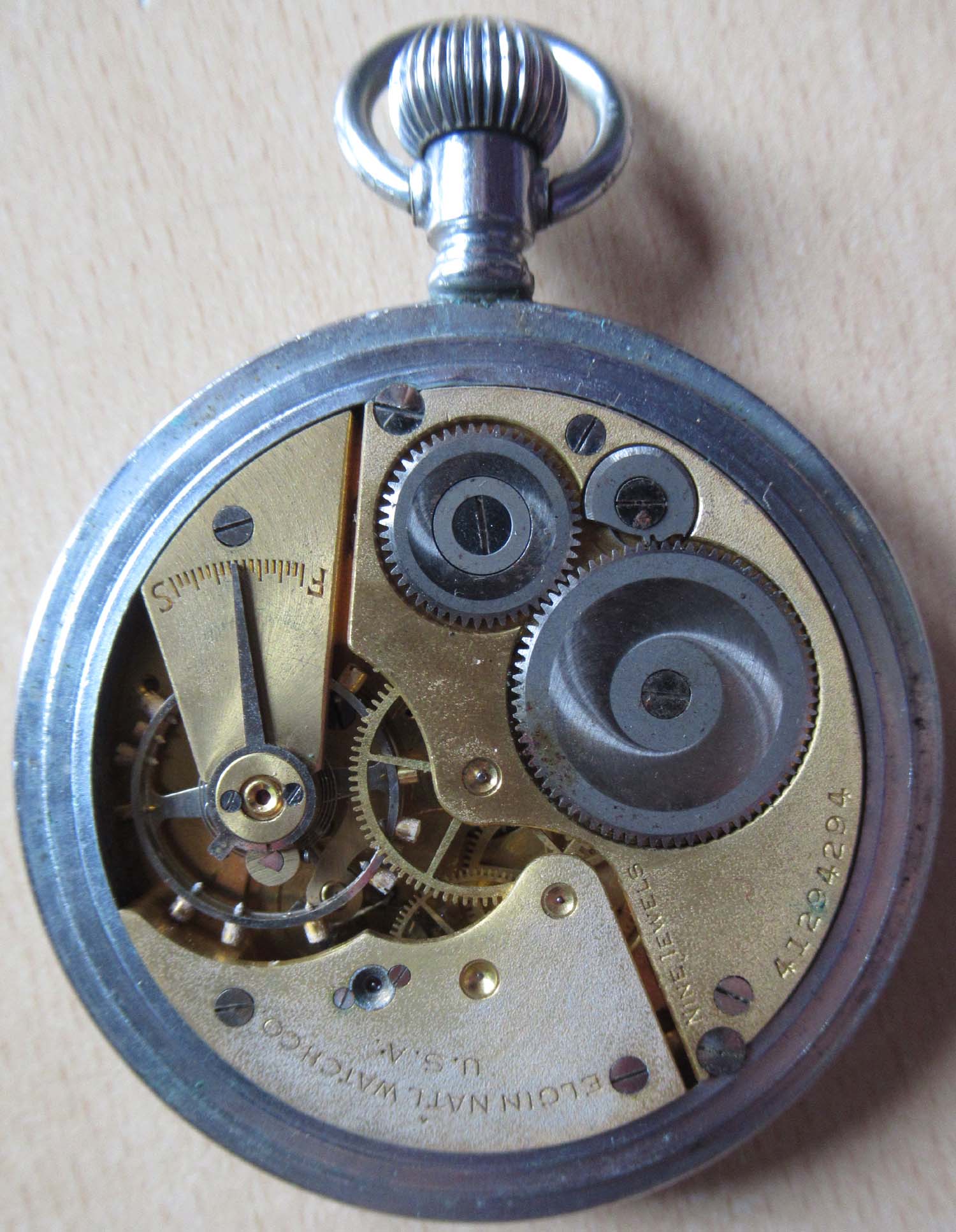
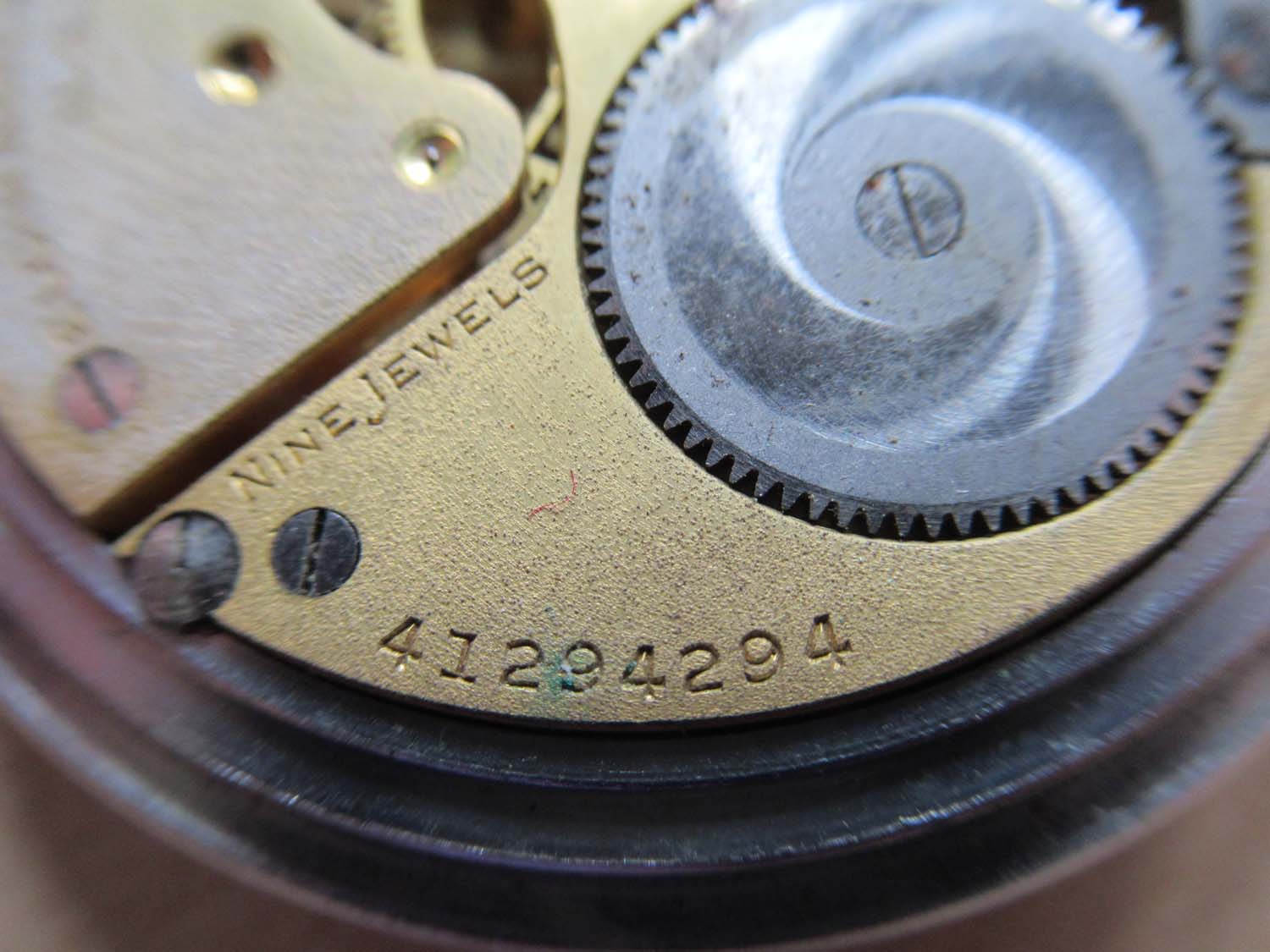
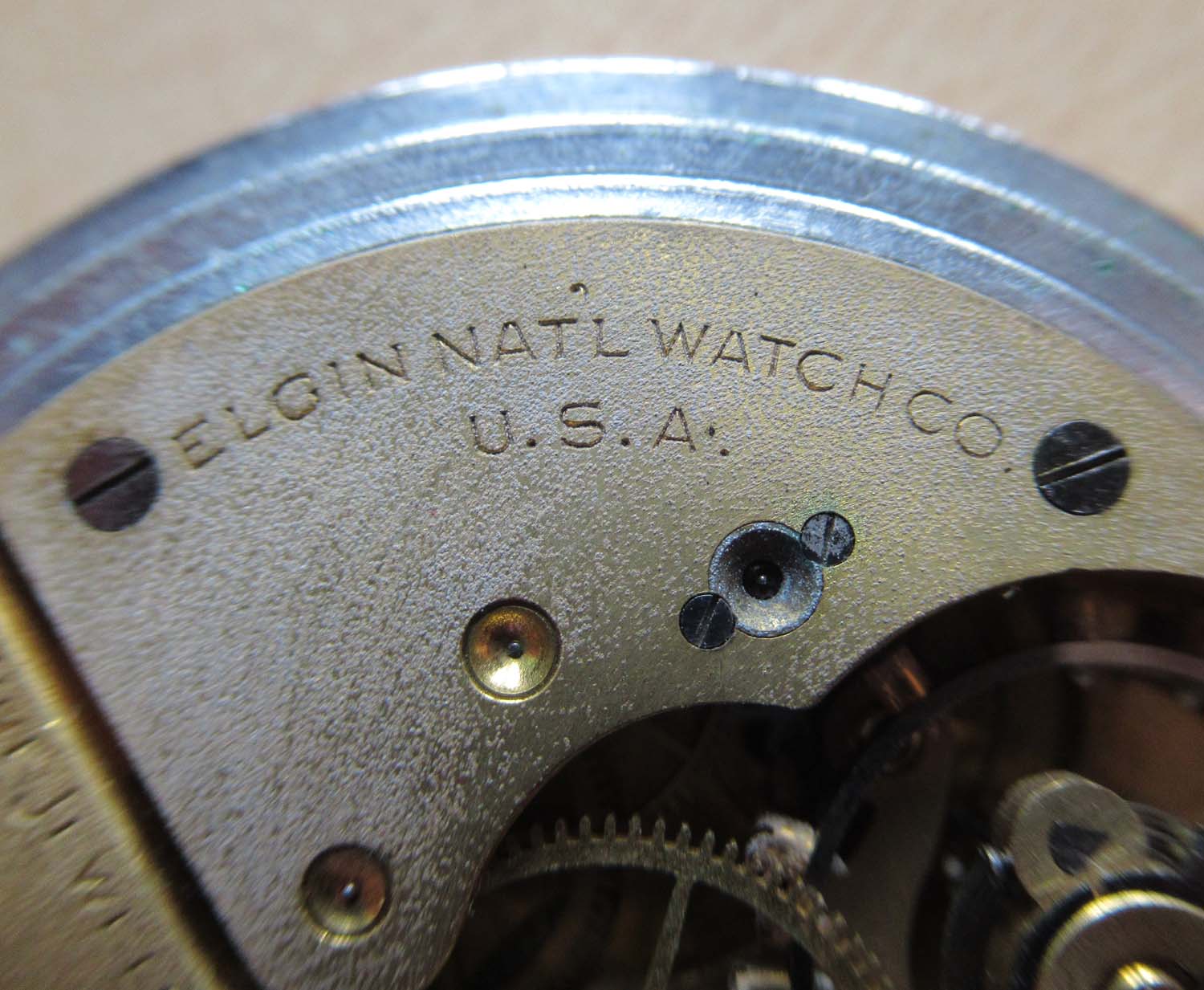
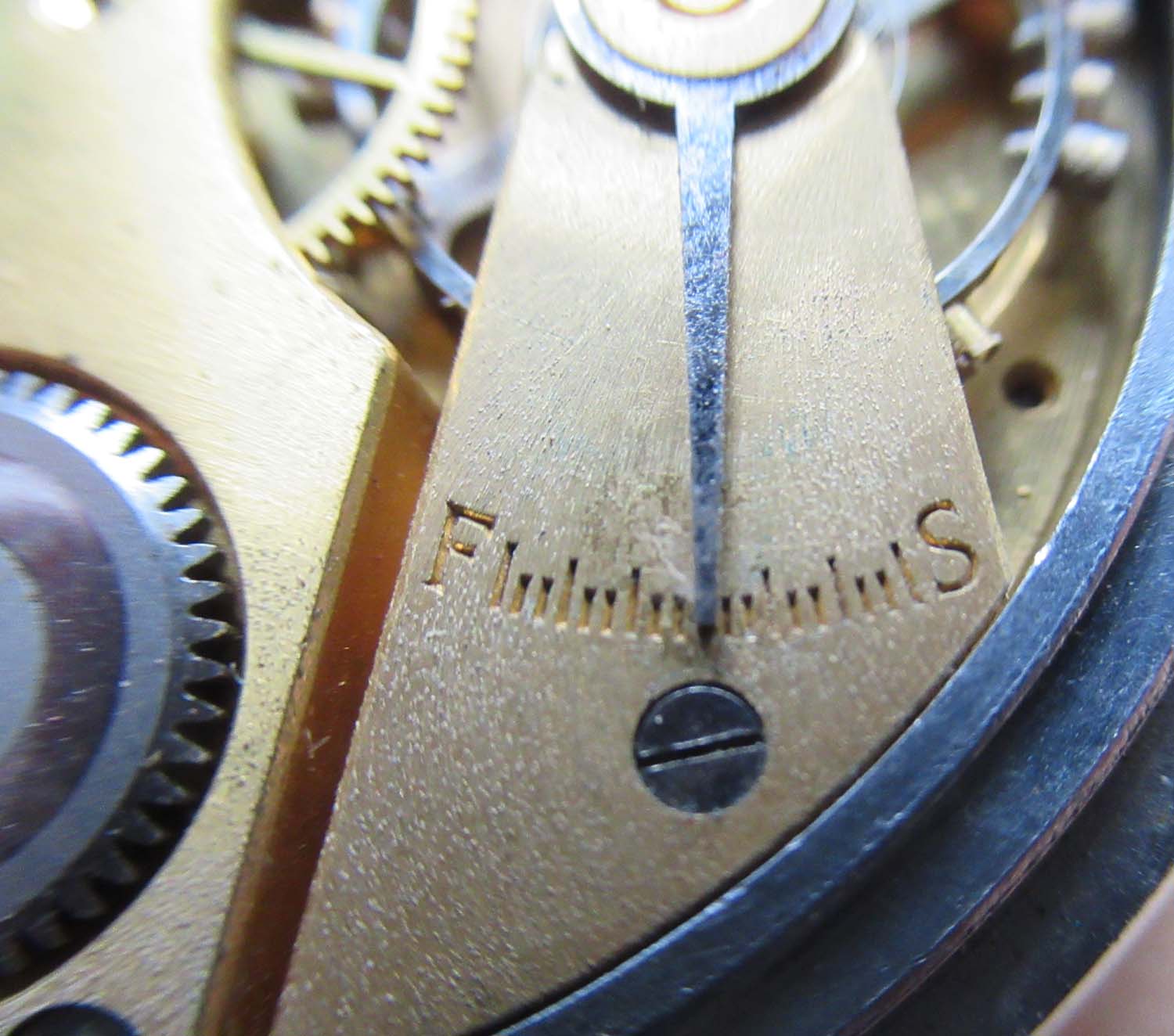 |
Elgin Pocket Watch 1943 (Pg 5
Compasses and Clocks 76)
Here we have a size 16s, model no. 7, nine jewel,
grade 594, Elgin pocket watch by the Elgin National Watch Company USA, dated 1943.
Not in working condition.
Both the front and the back screw off. It as 3/4
plate and a going barrel.
Its movement configuration is open face,
setting is wind and set, and it had a matte nickel finish.
CW 380
A 96561
Serial No: 41294294
58239
Click on
pictures to enlarge
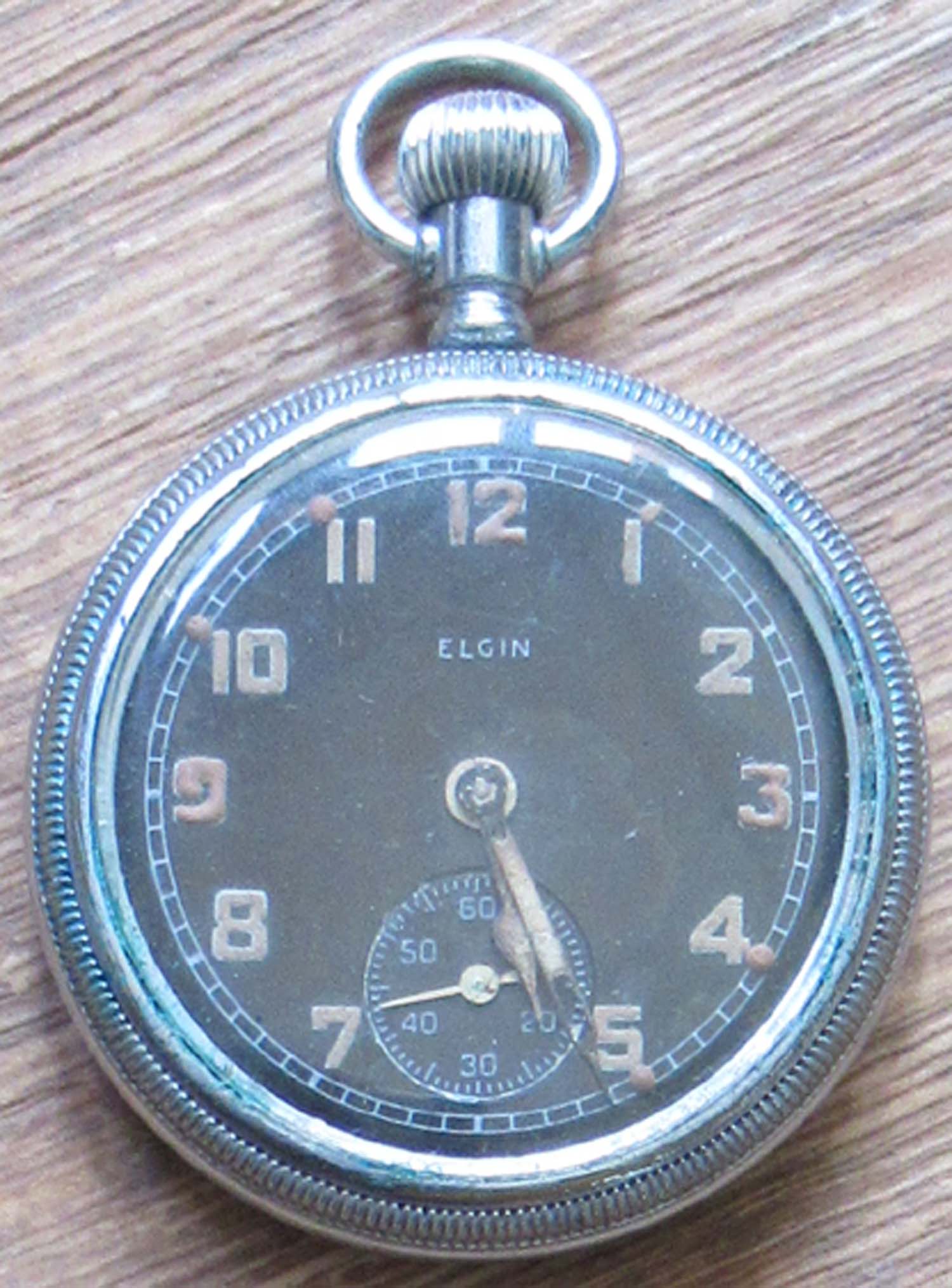
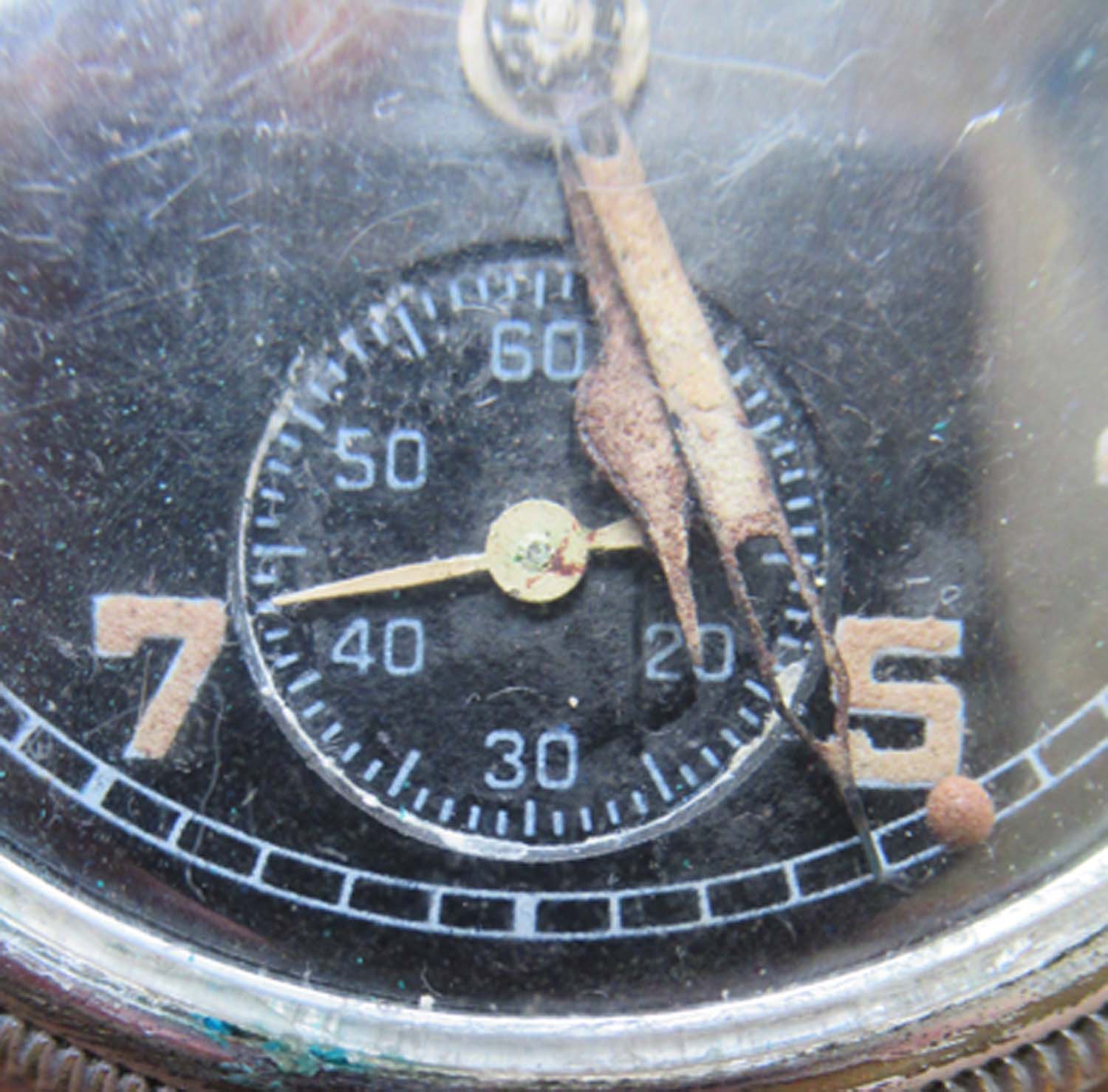
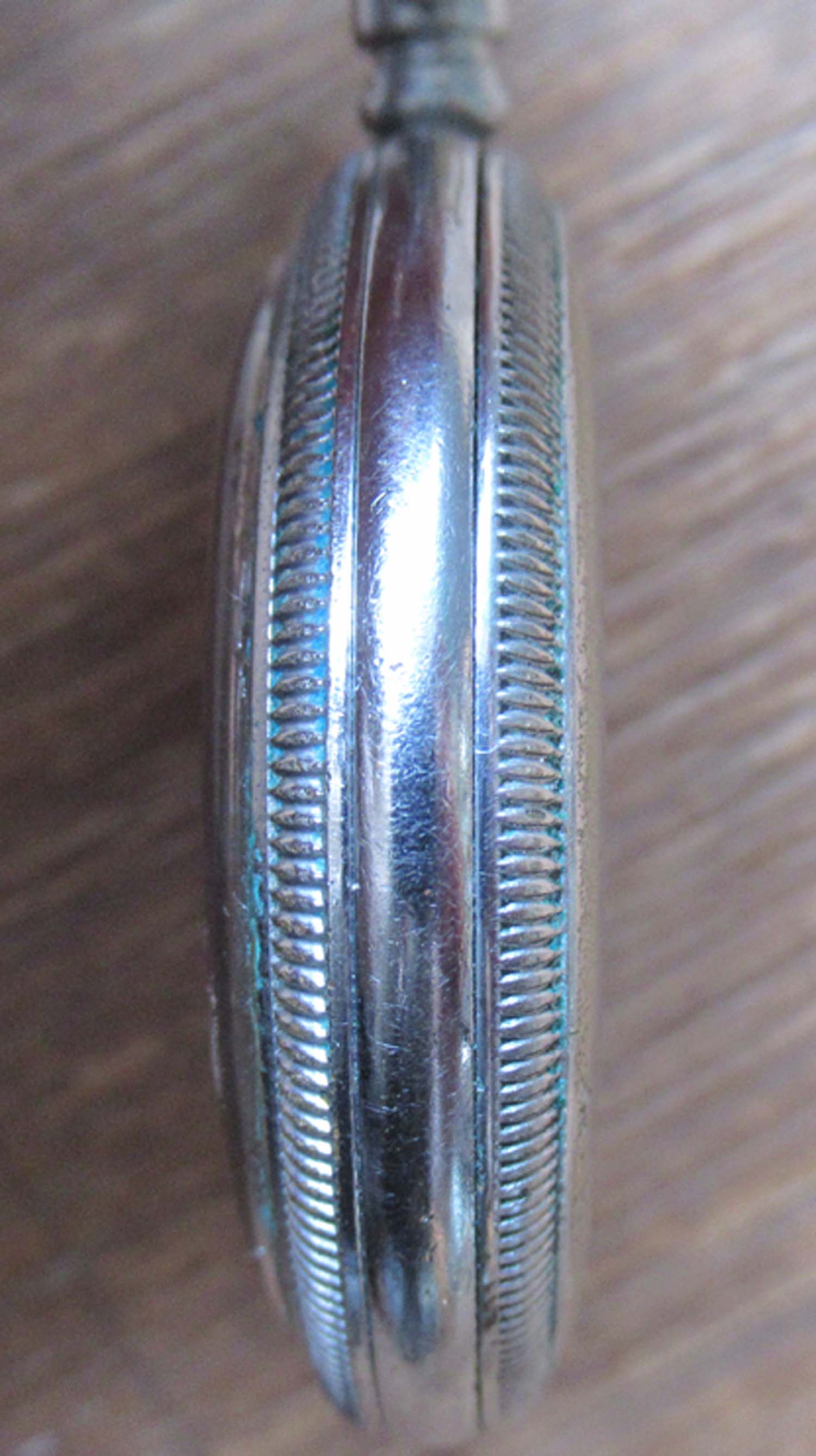
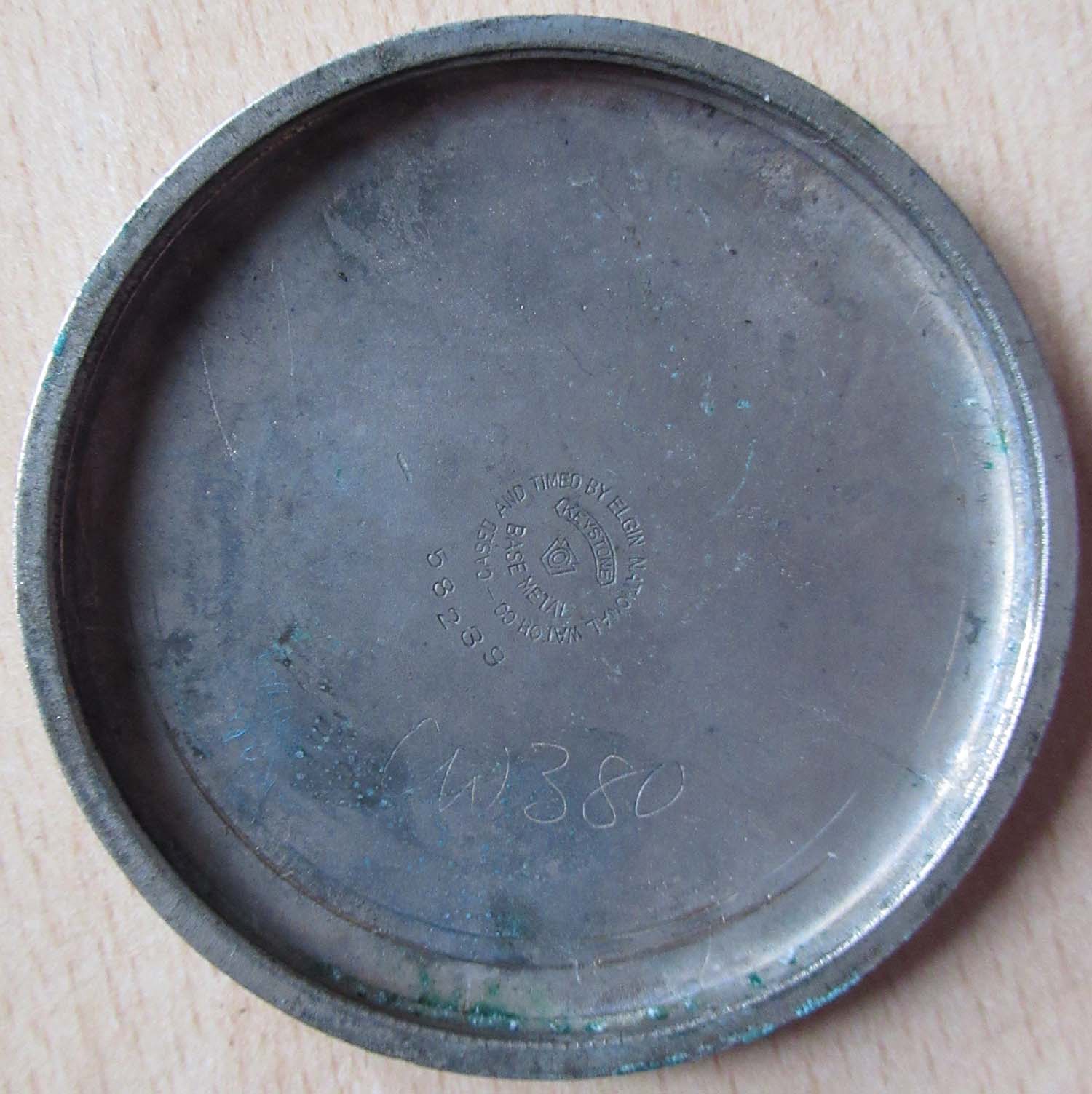
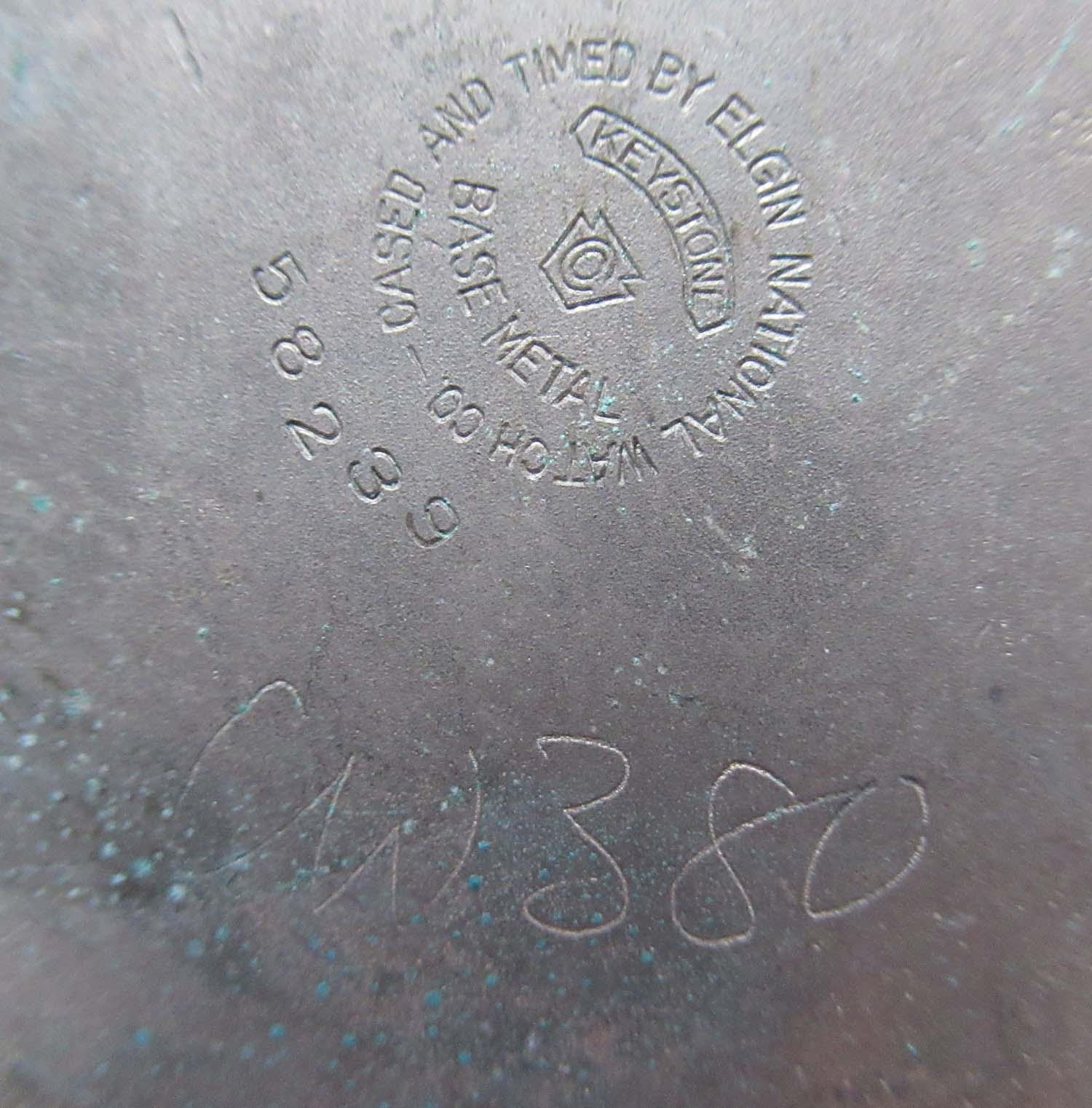
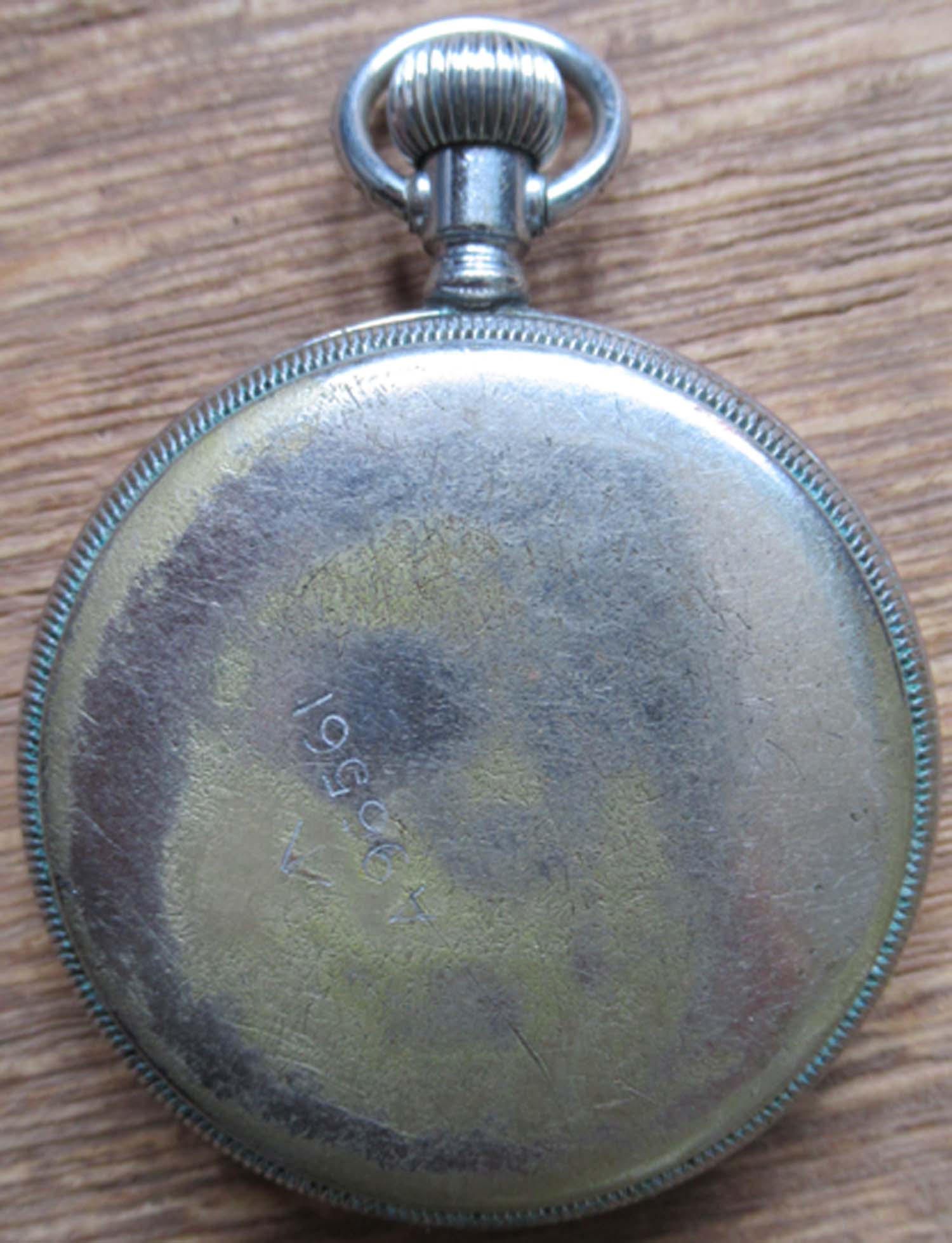
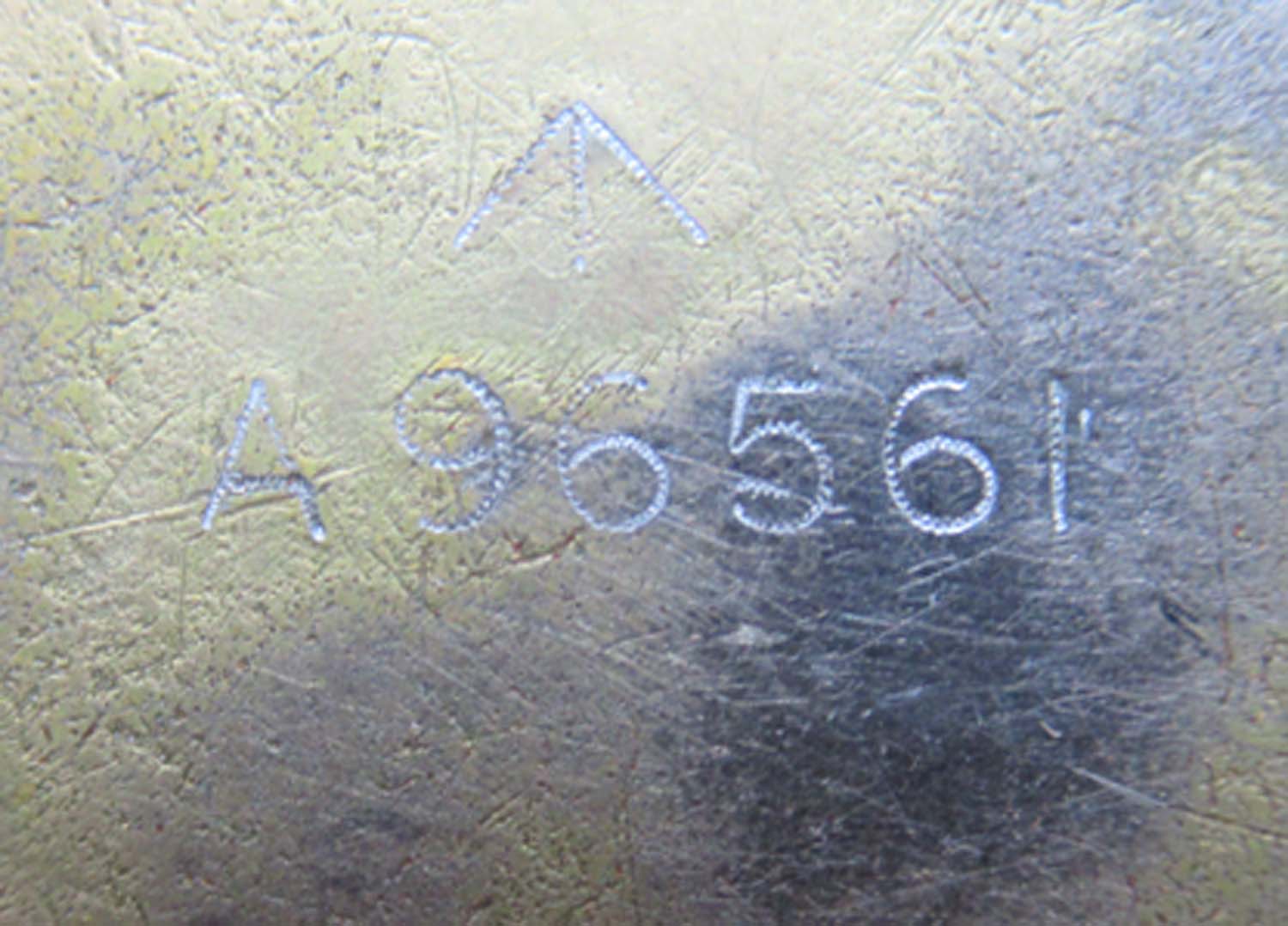
£100


|
|
Click on
pictures to enlarge


 |
Type P11 Compass (Pg 5
Compasses and Clocks 75)
Here we have a beautiful, boxed P11 compass used
mainly in the Hawker Hurricane
6B/1672
Ref No: 59085
HBS/P/7/50
Click on
pictures to enlarge




Out of
stock more wanted
contact me |
|
Click on the
pictures to enlarge.



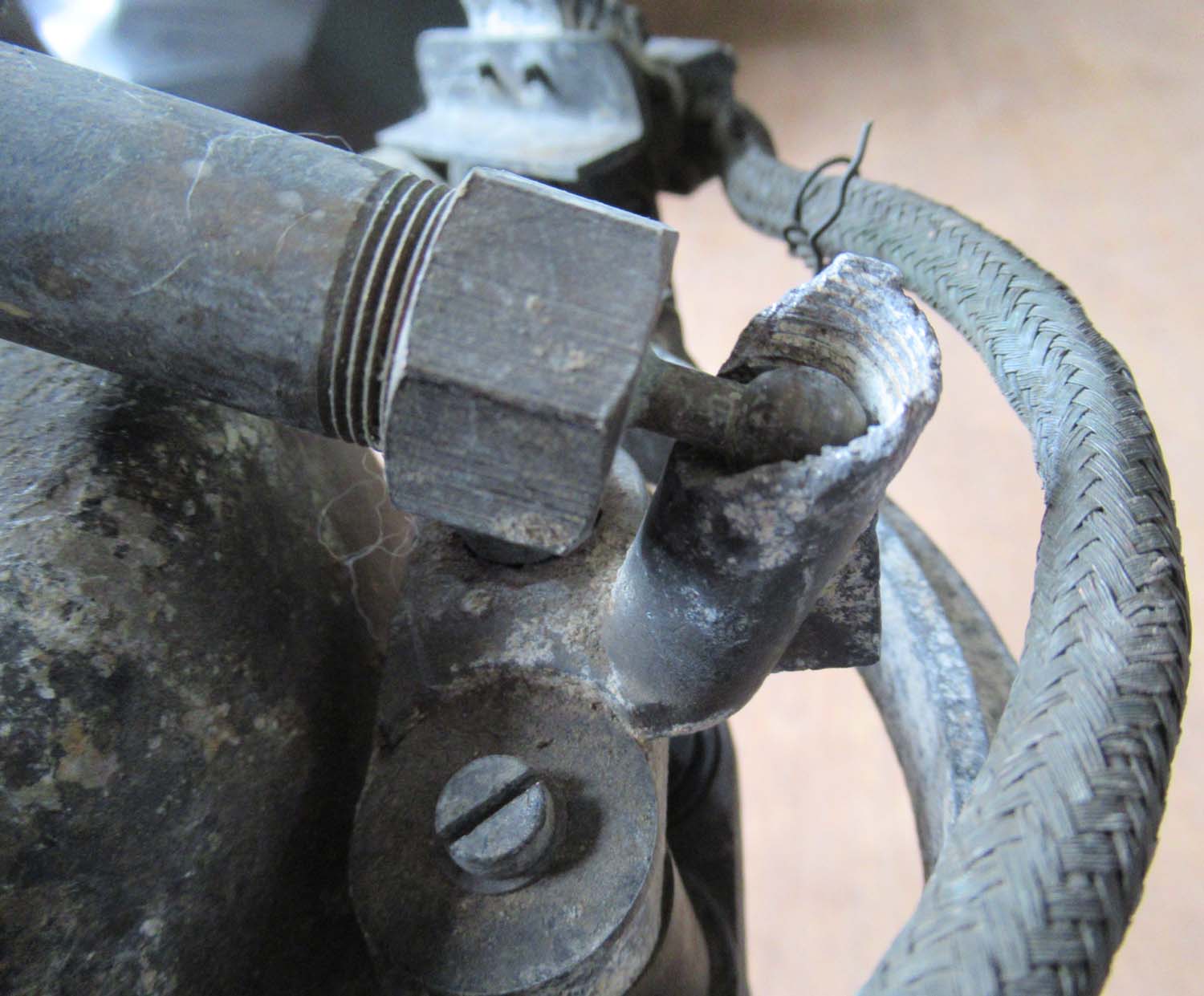 |
Lancaster Master Compass (pg
5 Clocks and compasses 74)
Here is master compass from a Lancaster
probably also used in the Halifax and other large wartime
RAF aircraft.. It has some paint loss but is complete with
its internals and mounting bracket.
The master compass holds the magnetic
element, the gyroscope, the monitoring and follow-up
mechanism and the transmitter for operating the repeaters.
The complete assembly is suspended in gimbals.
The system uses an electric magnetic inductor
element fixed to the aircraft in azimuth which detects the
direction of the Earth’s magnetic field relative to the
aircraft and transmits this information electrically to the
gyro element.
The D.R. Compass was developed by the
Automatic Telephone and Electric Company and the Royal
Aircraft Establishment from a model originally produced by
the Air Ministry and S.G. Brown Ltd in 1934.
Some 30,000 of these instruments were made at
the A.T.& E. Strowger Works in Liverpool during the WWII
years.
One part
of one of the gimbals is broken, please see photograph
bottom left.
Dated
1943 6A/741
Click on the
pictures to enlarge.

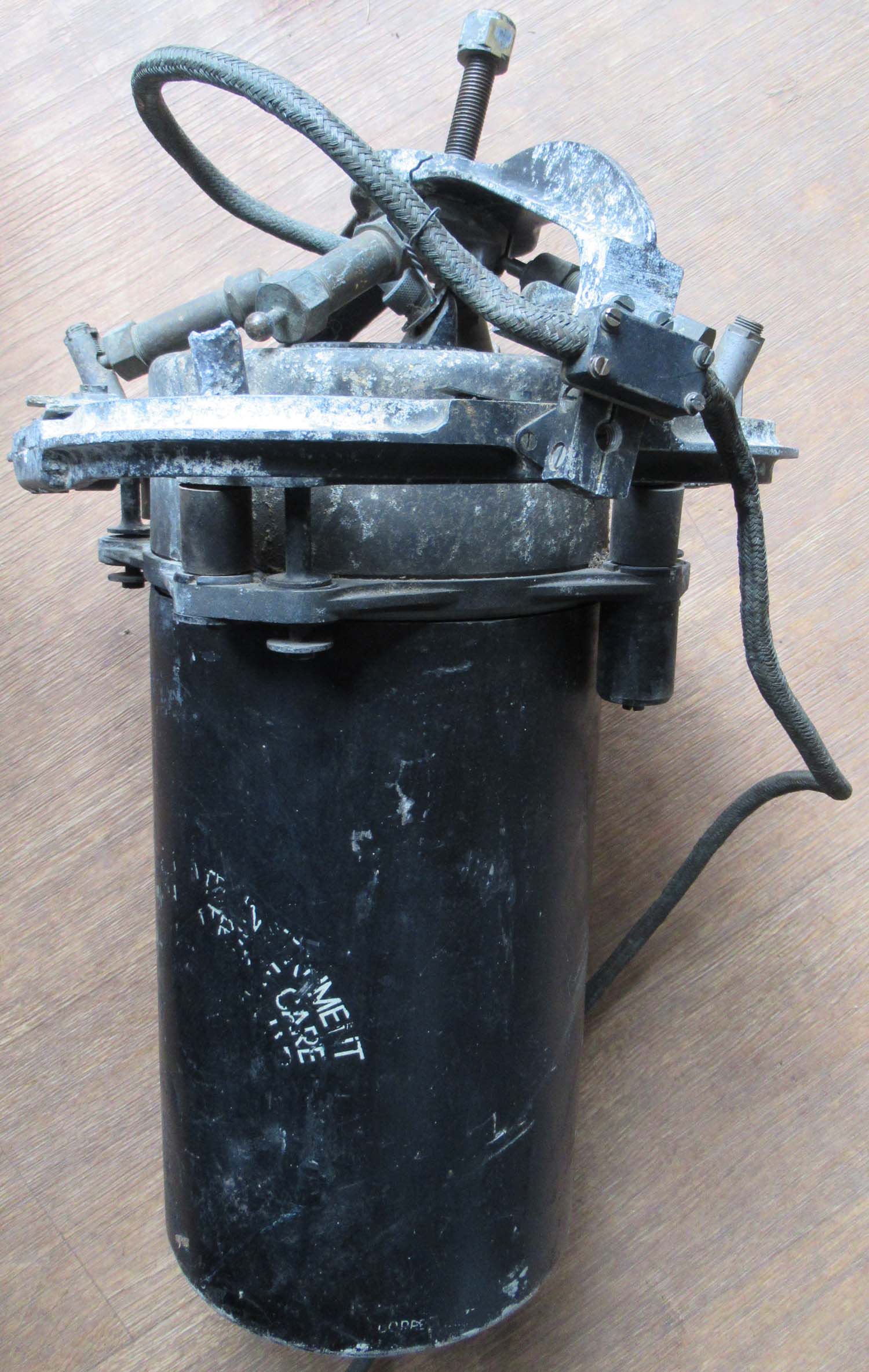
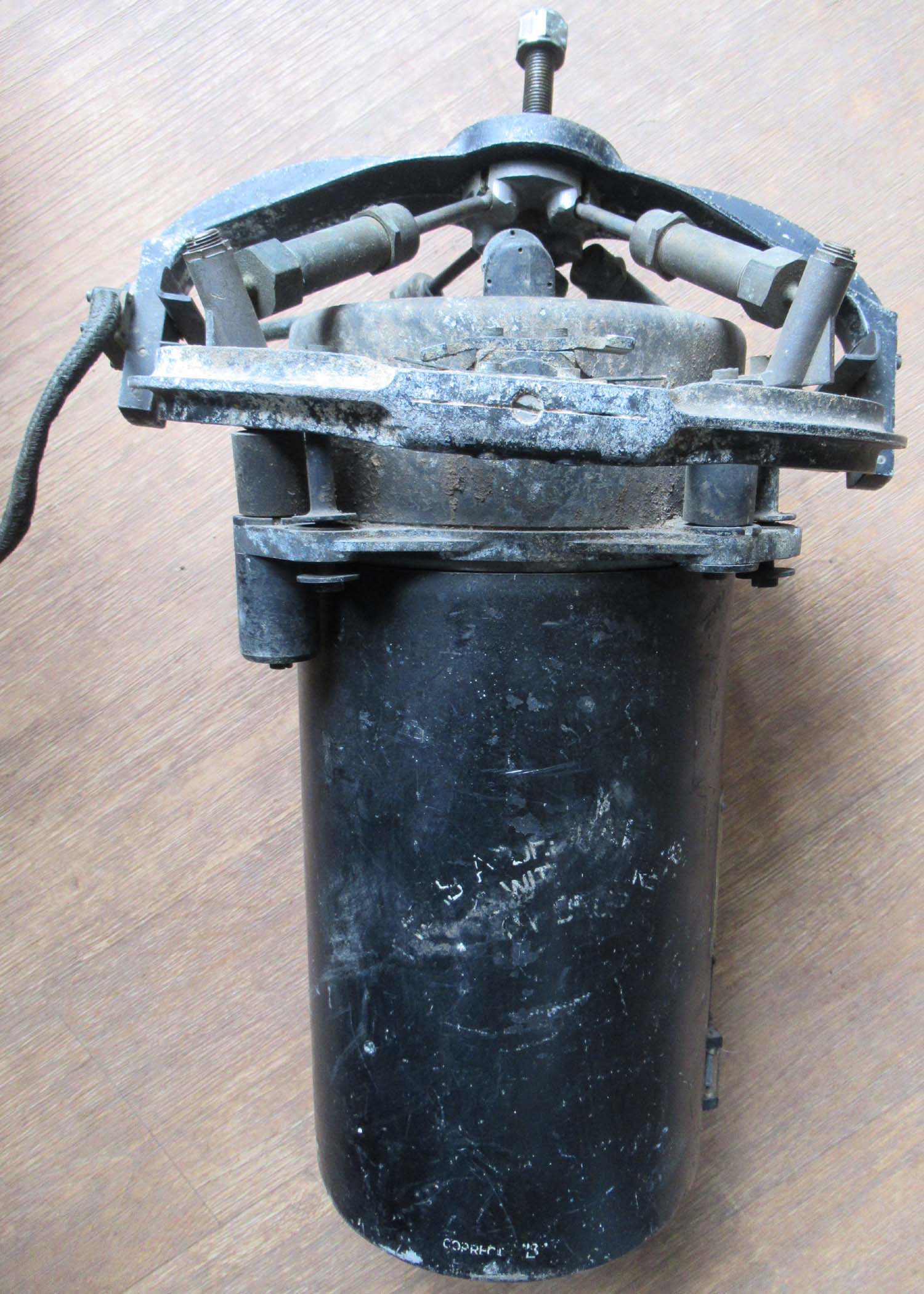


£895


This
piece is big and heavy. Overseas buyers please
contact me for a shipping
quote.
|
|
Click on the
pictures to enlarge.
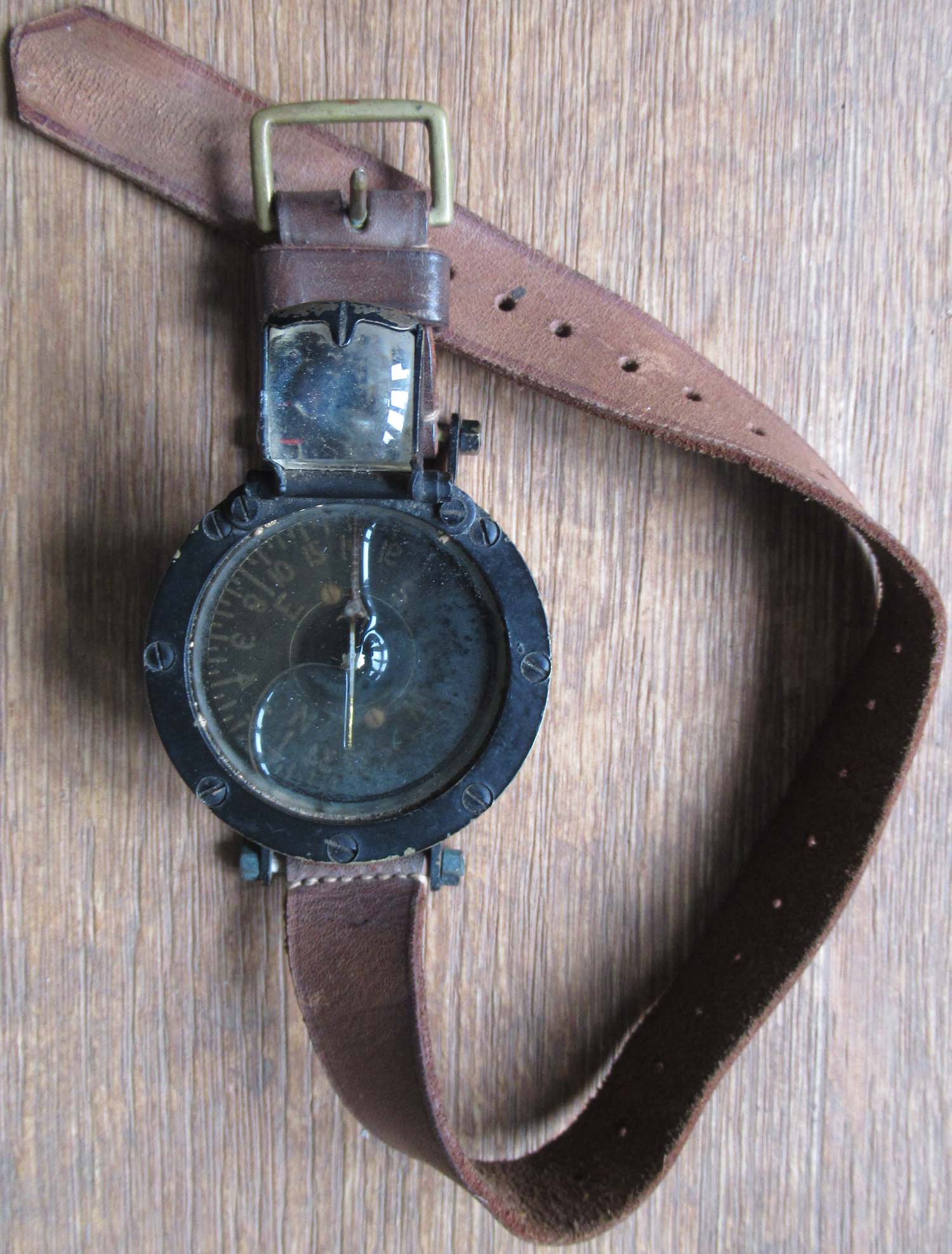
Out of stock
more wanted please
contact me |
RFC Leg Compass (pg
5 Clocks and compasses 73)
This is a super
rare peace from WWI and the infancy of Military aircraft a
Pilots or observers compass that could be worn on the leg or
arm it is complete with its original strap and magnifying
prism. It retains its original fluid and works as it should.
used by the RFC (Royal Flying Corp) and the RNAS (Royal
Naval air service)
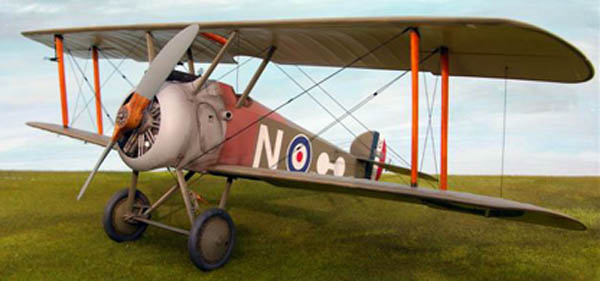
Shown above the Sopwith Camel
this aircraft
was highly manoeuvrable and popular with its pilots although
the combination of the short-coupled aircraft and the rotary
engine produced some handling quirks that could catch out
inexperienced pilots. The Sopwith Camel proved to be very
successful in dogfights and achieved more victories in
combat than any other aircraft during the First World War.
Click on the
pictures to enlarge.
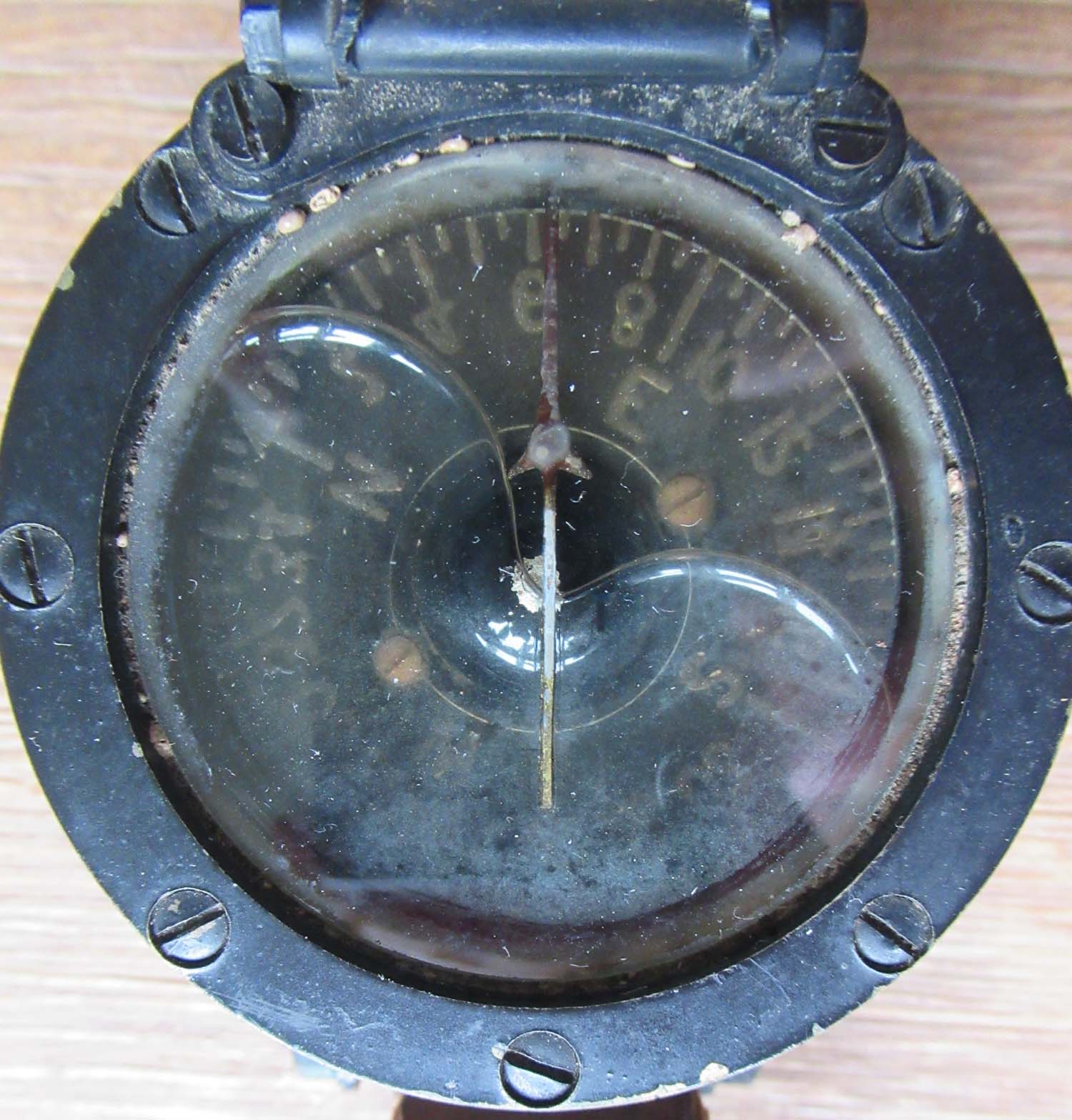
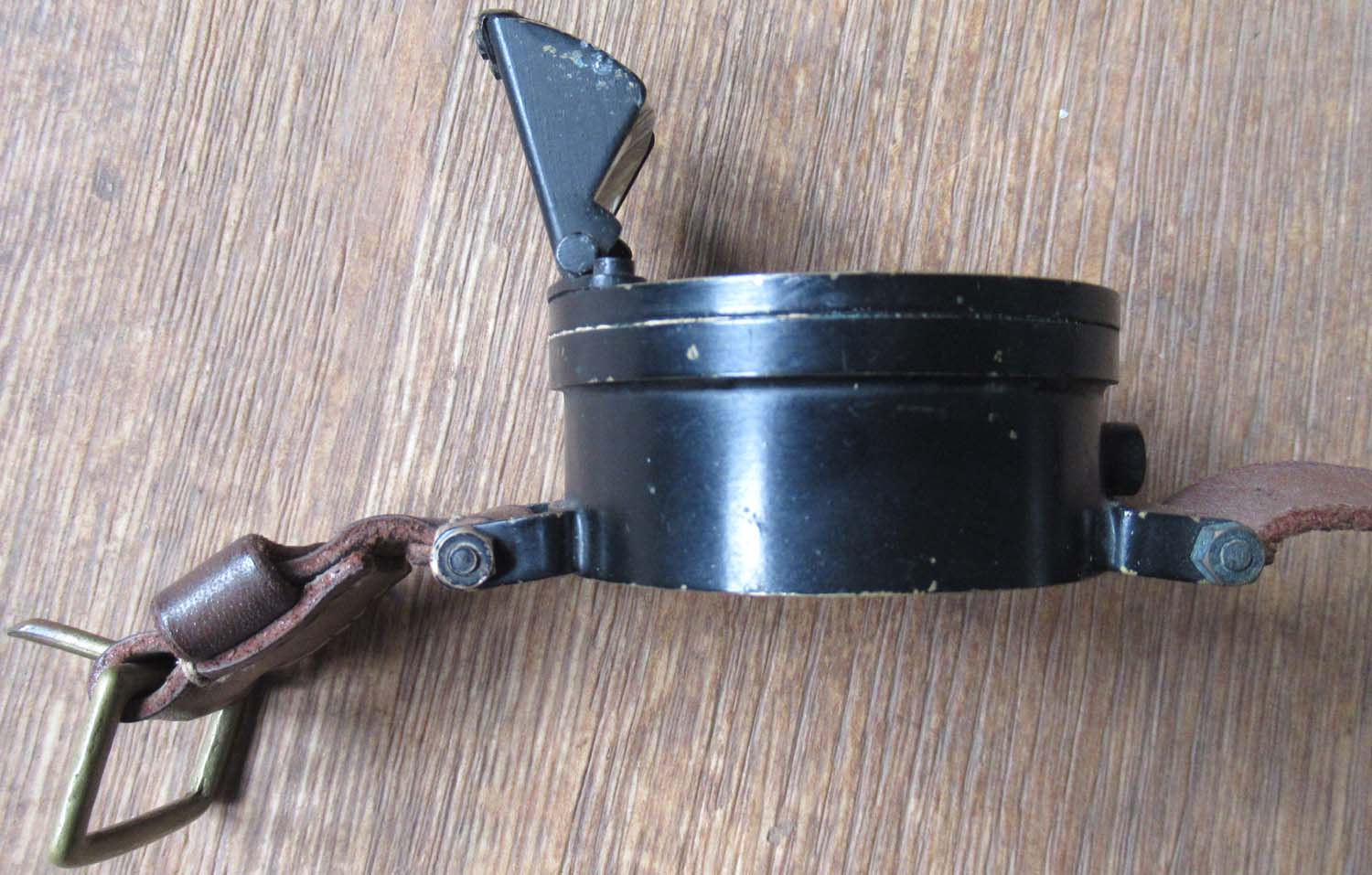
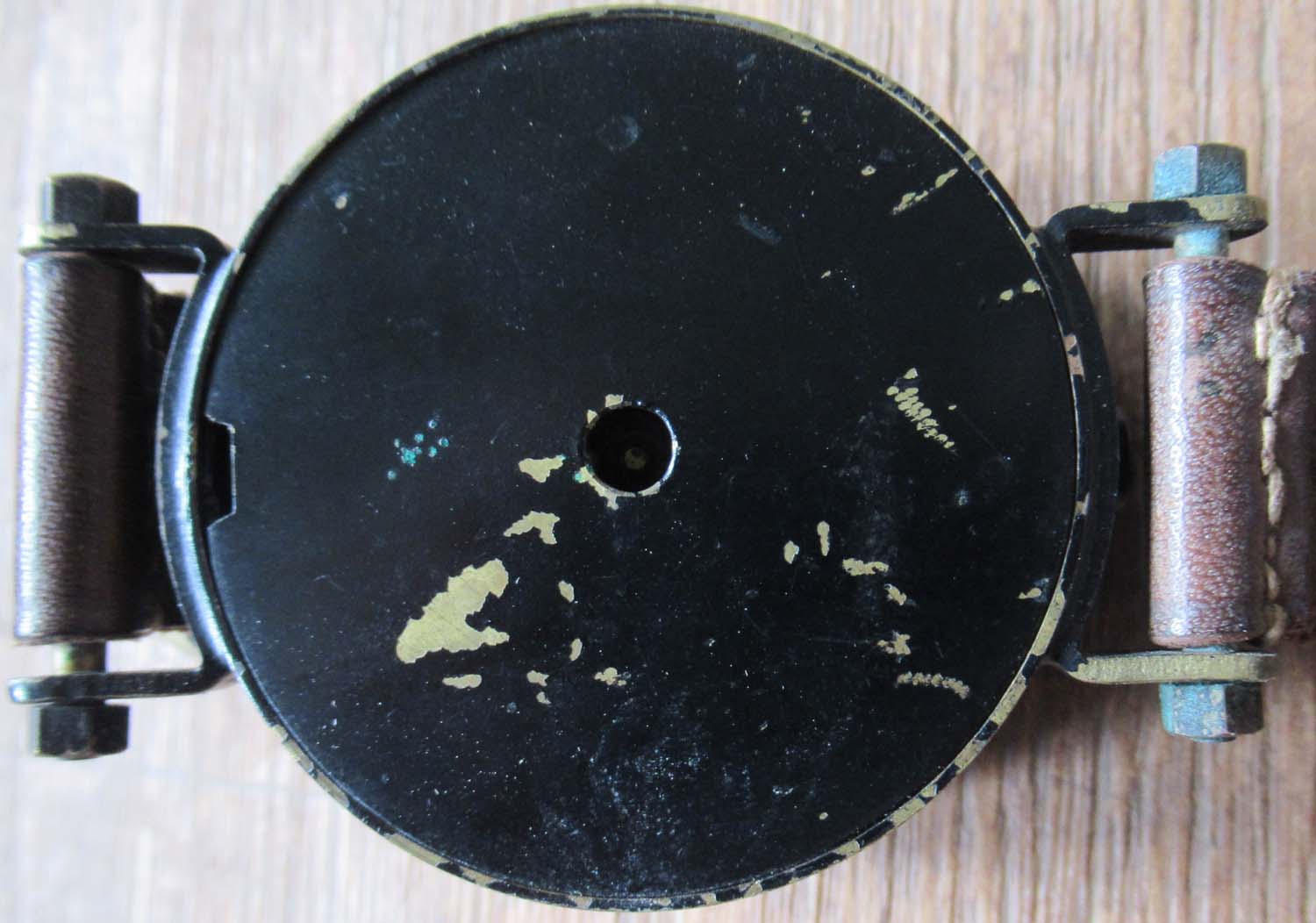
|
|
Click on the
pictures to enlarge.


£275


|
USAAF Type
DE -12 Compass (pg
5 Clocks and compasses 72)
This is a Type D -12 USAAF compass used in a variety of
Wartime aircraft including Heavy Bombers B17, B 24, B
29, Medium Bombers B25, B26 and transport
aircraft including the C 46, C 47, and the C 54. In nice
original condition.

Seen above the
iconic B17 Bomber
Click on the
pictures to enlarge.


 |
|
Click on the
pictures to enlarge.

 |
Luftwaffe
Master compass FL 23331 (pg
5 Clocks and compasses 71)
This type of compass was used on practically all German aircraft, such
as the BF109, FW190, Me262, Ju88, Ju87, Me-110, and others.
This was the main master compass used by German
aircraft.
It was usually positioned in the rear fuselage of the
aircraft, and sent a signal to the smaller, "Fuhrertochterkompass",
which was located on the pilot's control panel.
These two instruments would work together to indicate the
aircraft's heading to the pilot. It was used on almost all
Fighters, Bombers, and Jets.
Please enlarge the pictures for condition most likely this
was recovered from a crashed aircraft there is a small crack
in one of the brackets and it has that feel to it..
Click on the
pictures to enlarge.
£795


|
|
Click on the
pictures to enlarge.
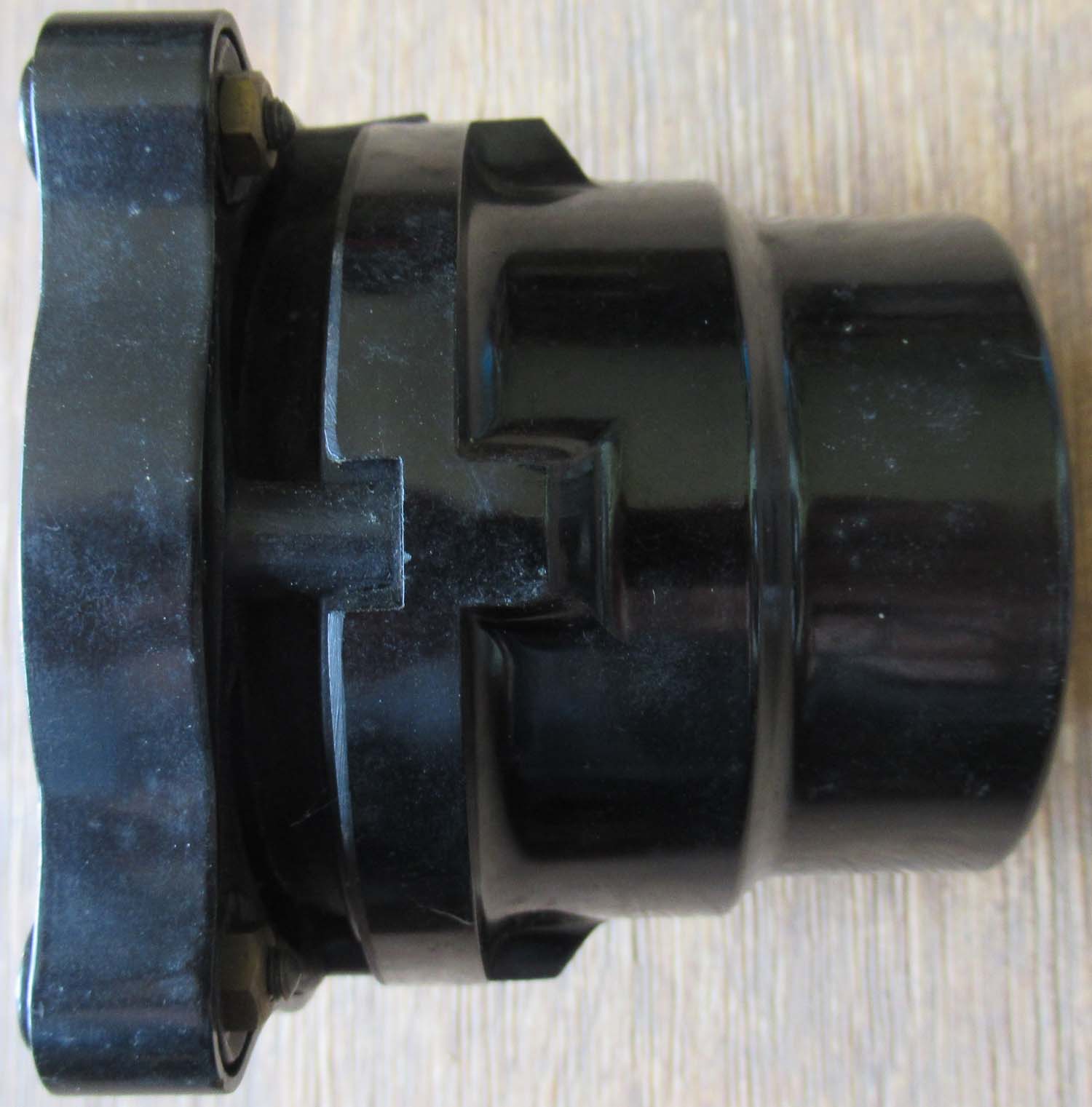
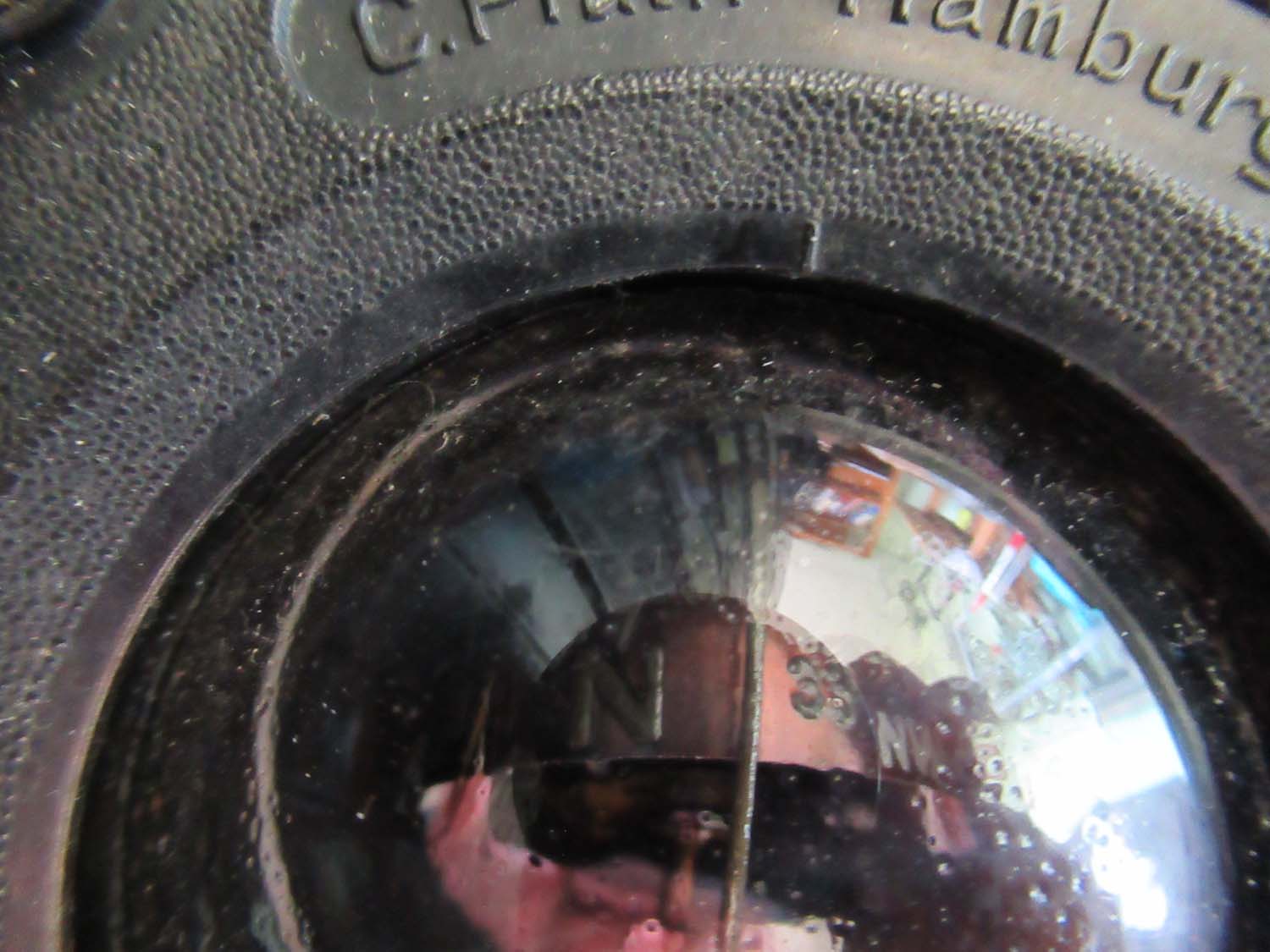 |
Luftwaffe Type Z
10 Fl 23230 (pg
5 Clocks and compasses 70)
The is a really early November
1936 Luftwaffe Kompass. Its in very nice original condition
the oil is quite dark but every one of this and similar
types is also dark so its possible it was designed to be
illuminated ? I do not know what aircraft this was fitted to
but clearly something available in 1936.
Type Z 10
FL 23230
Click on the
picture's to enlarge.
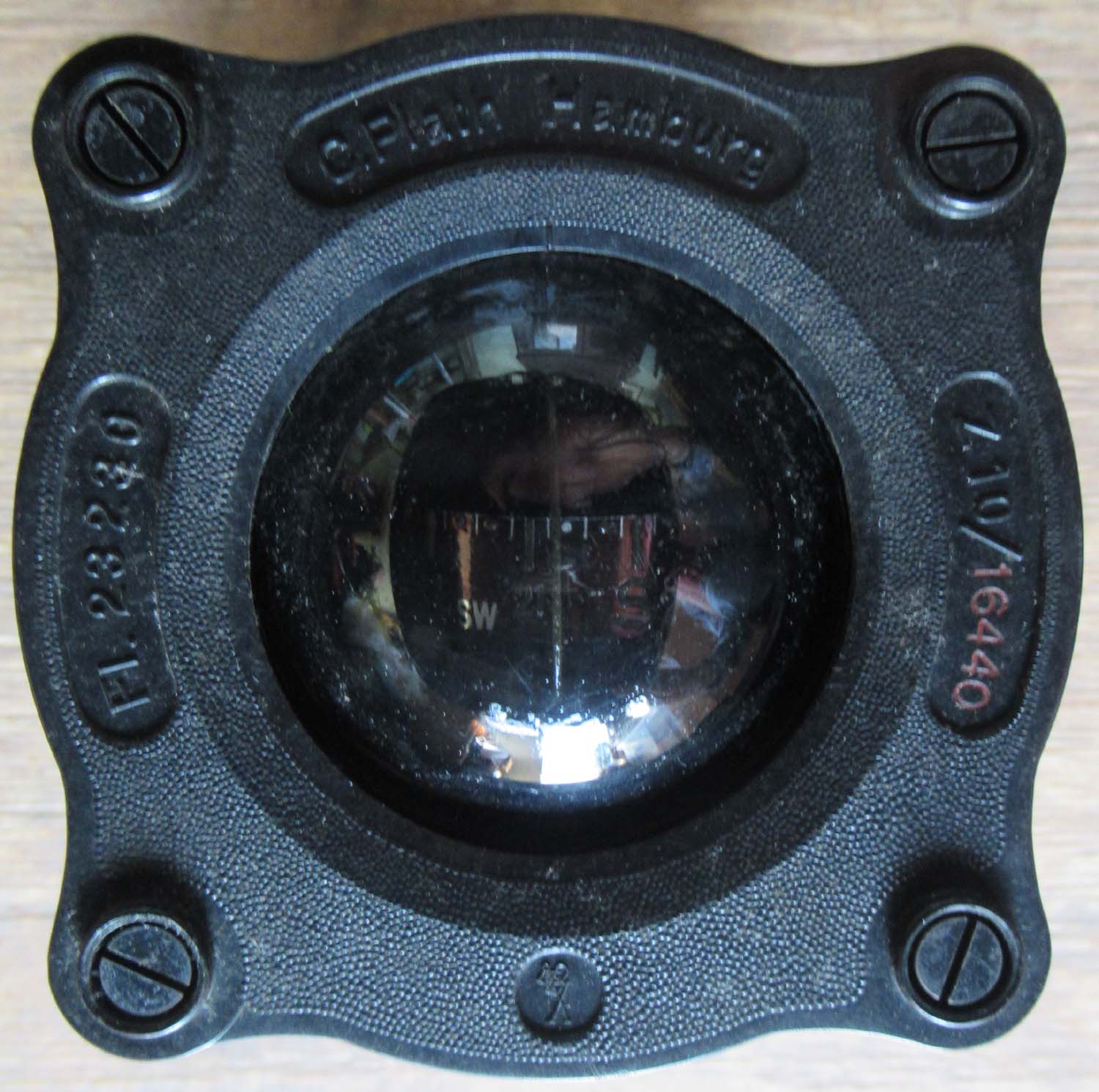
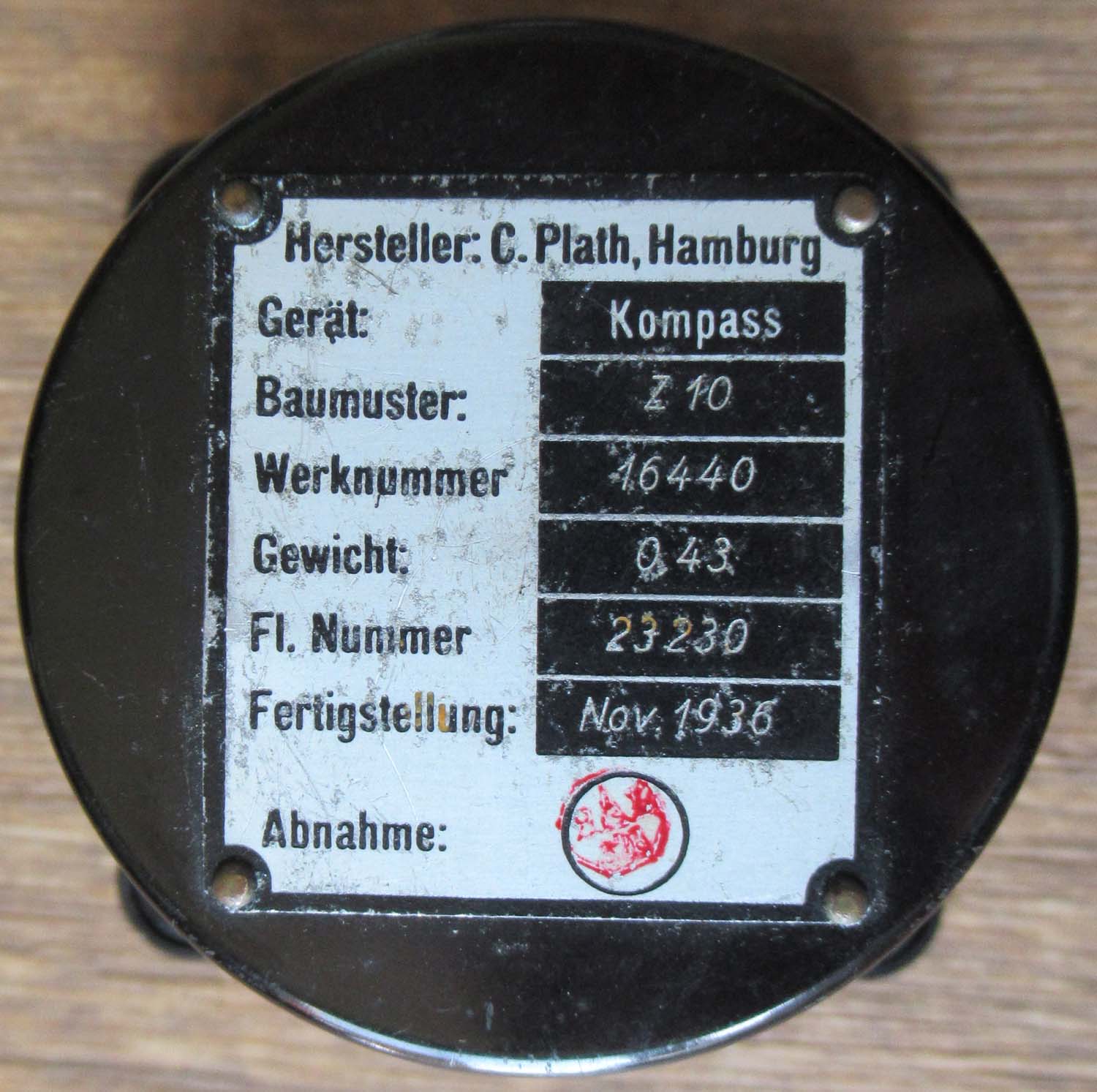
£225


|
|
Click on the
pictures to enlarge.
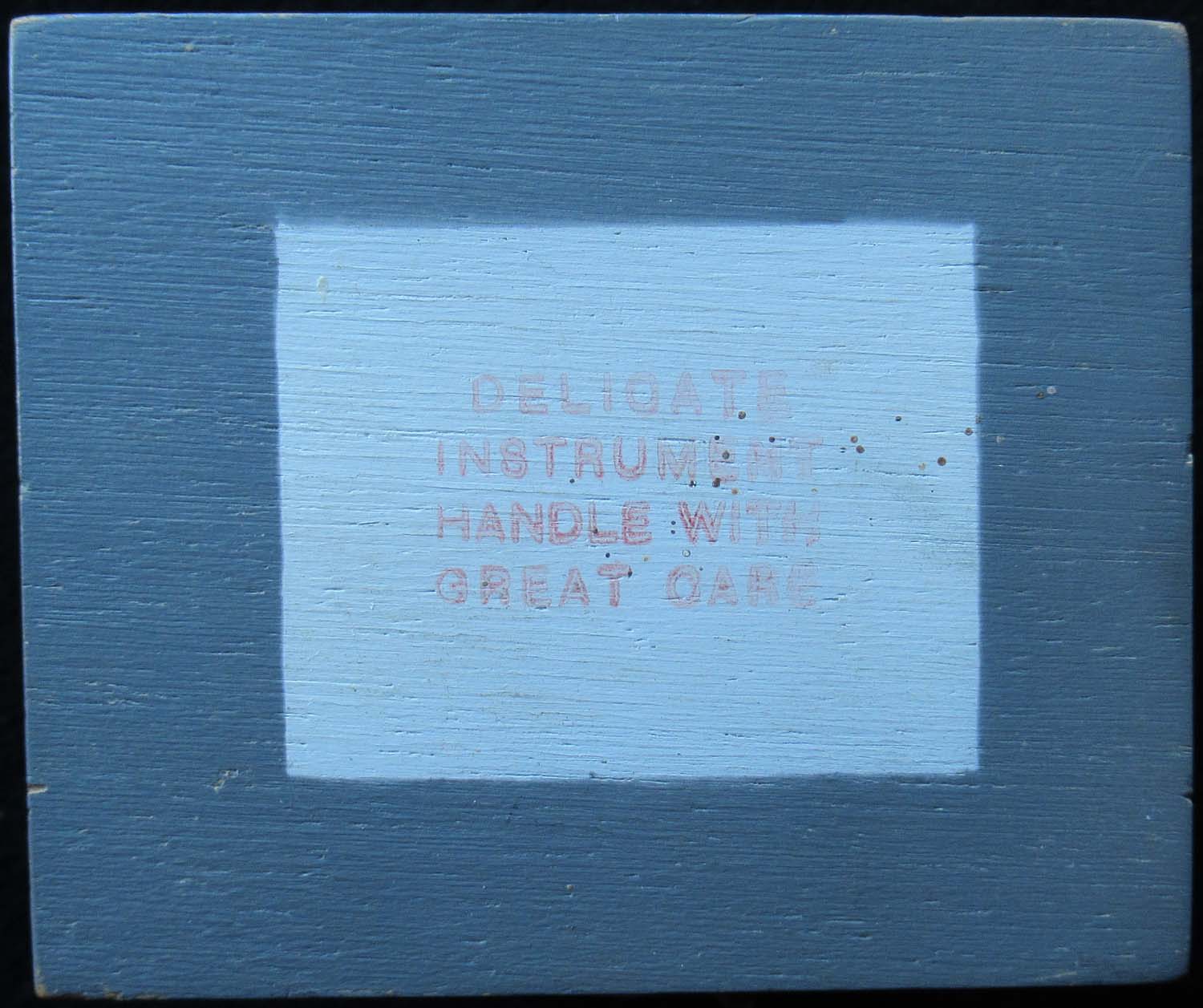
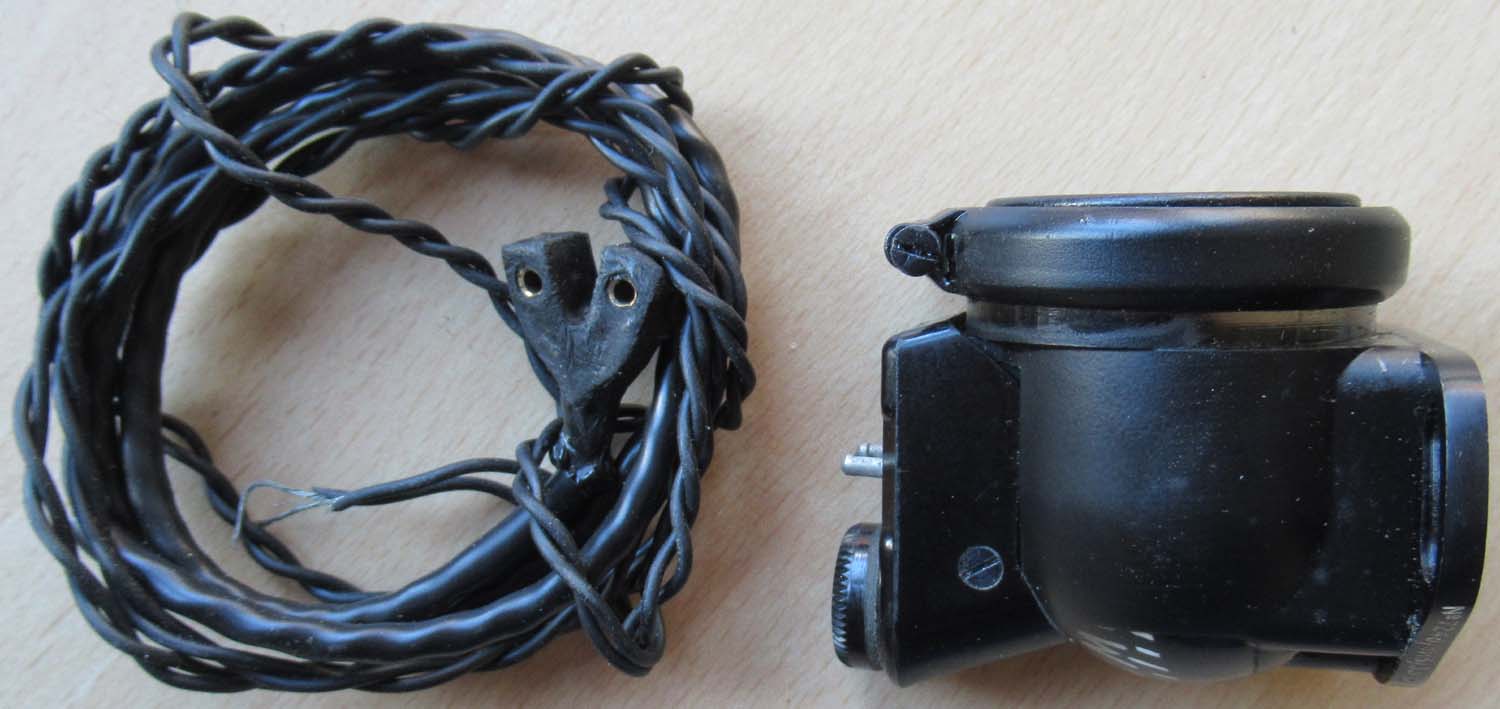
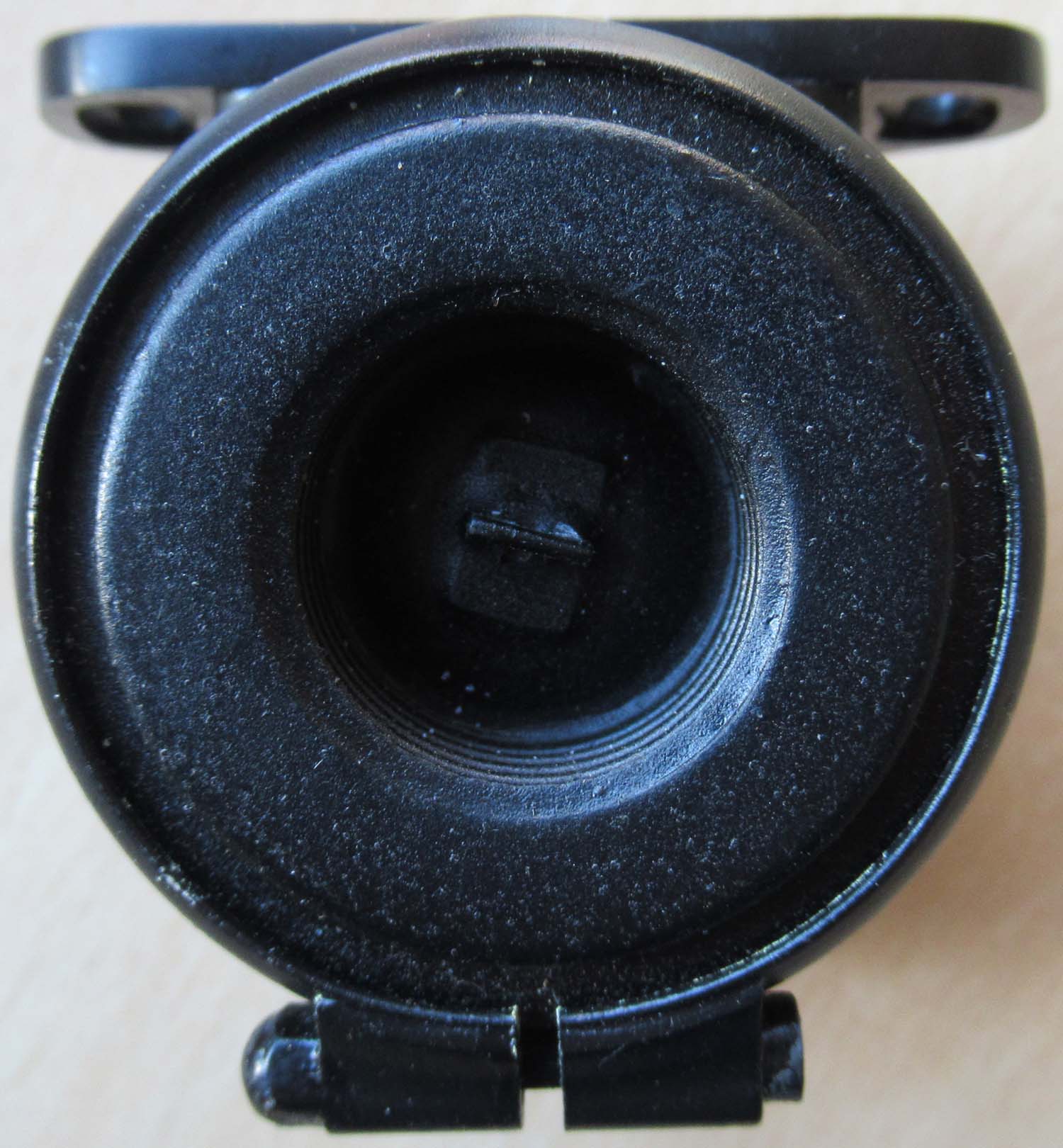
Out of
stock more wanted please
contact me |
Type E2 B
Compass (pg
5 Clocks and compasses 69)
This is a Type E2 B compass used
in early Jets the Vampire, Meteor and the turbo prop
Westland Wyvern along with many other RAF aircraft as a back
up compass. The E2 B is internally lit . This one is in very
good condition in its original transit case and connecting
wire for the light.
Click on the
pictures to enlarge.
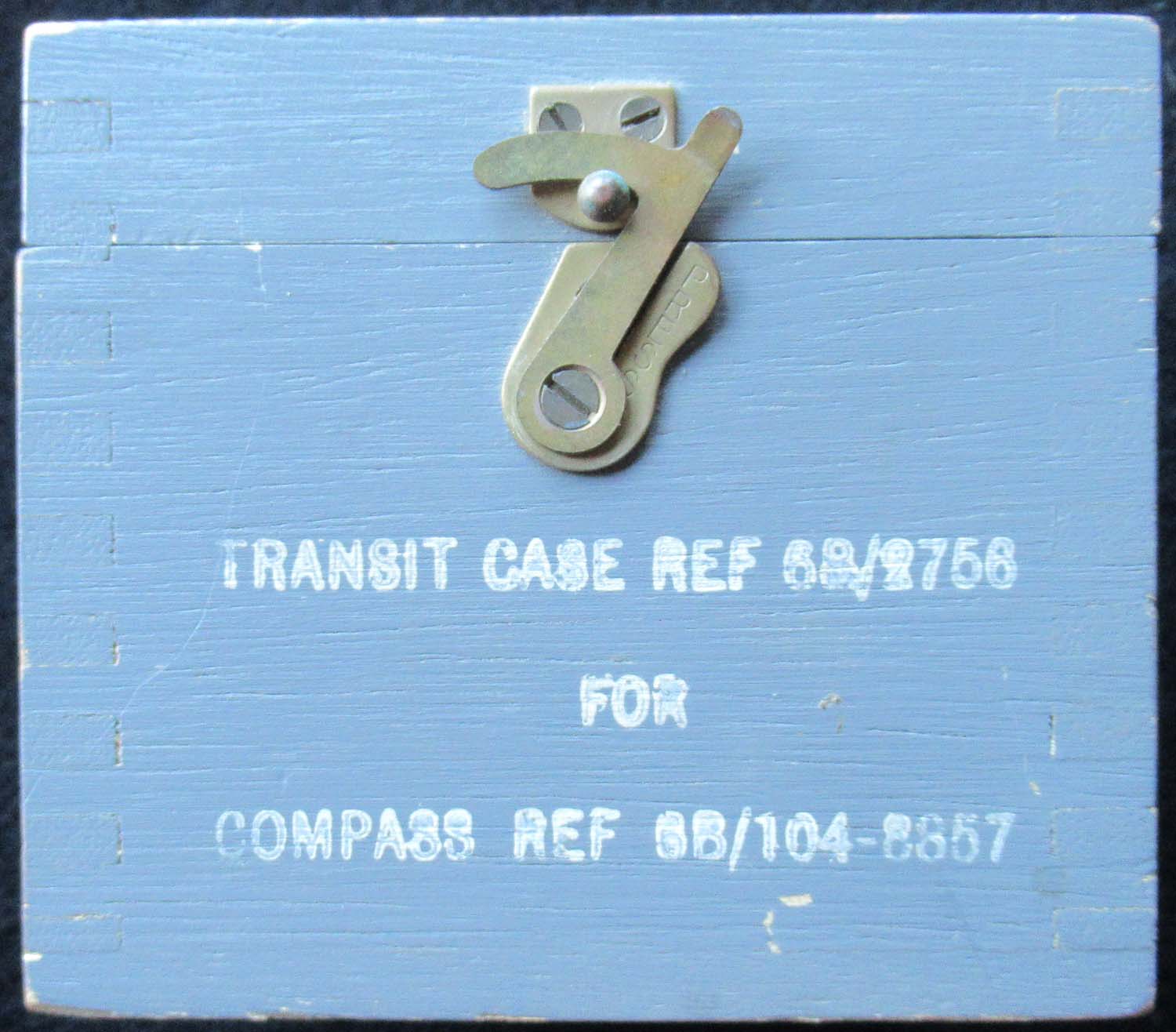
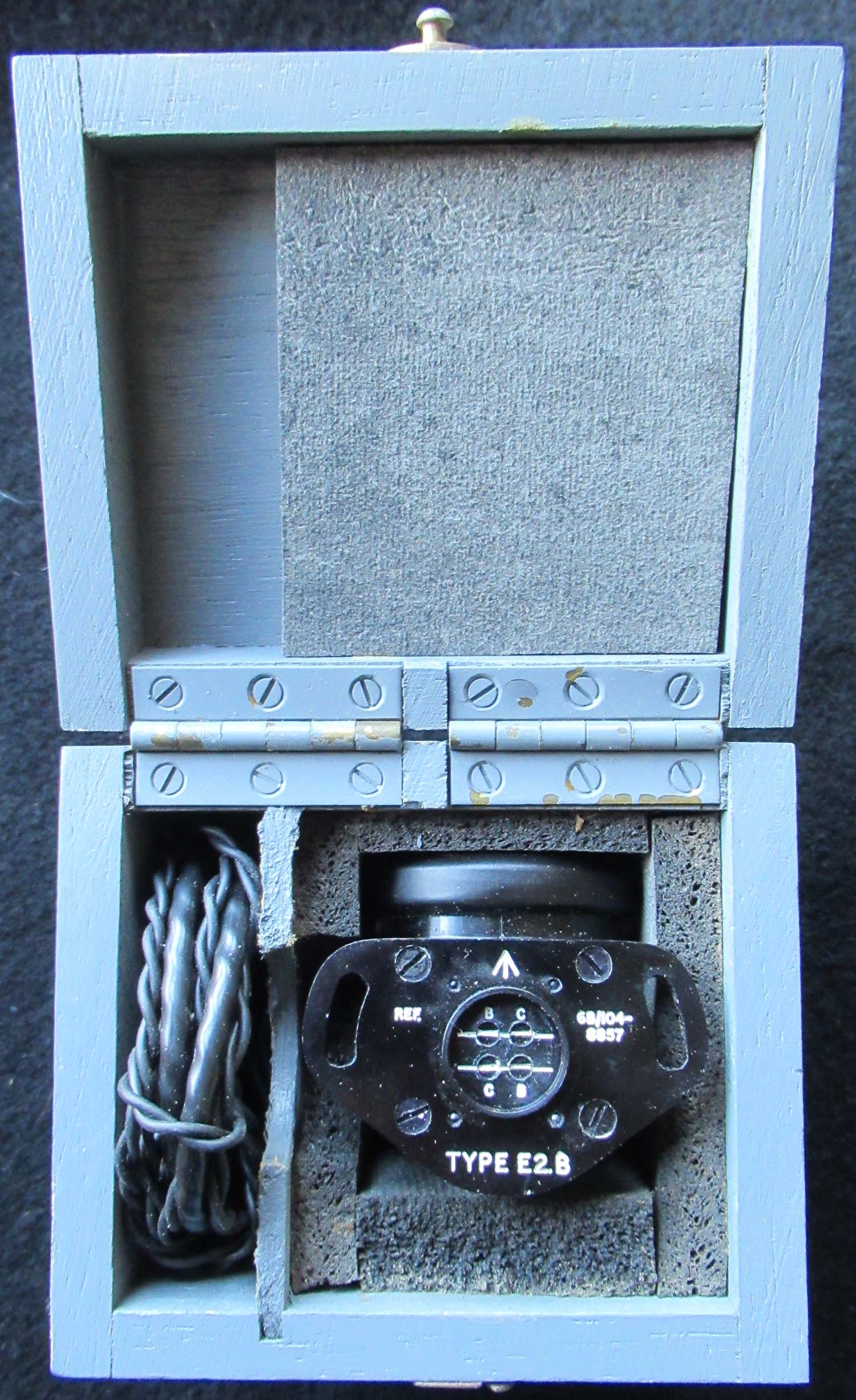
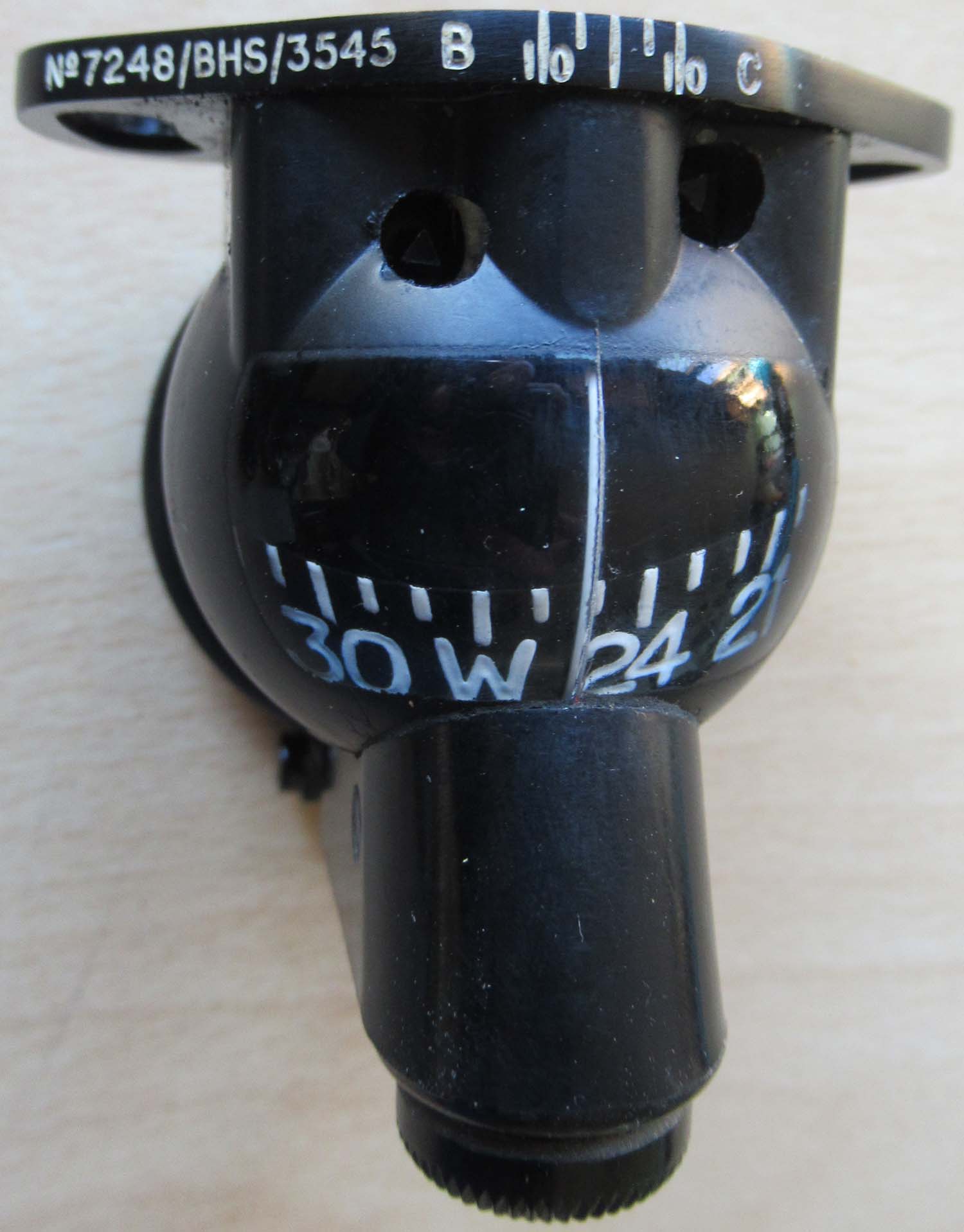
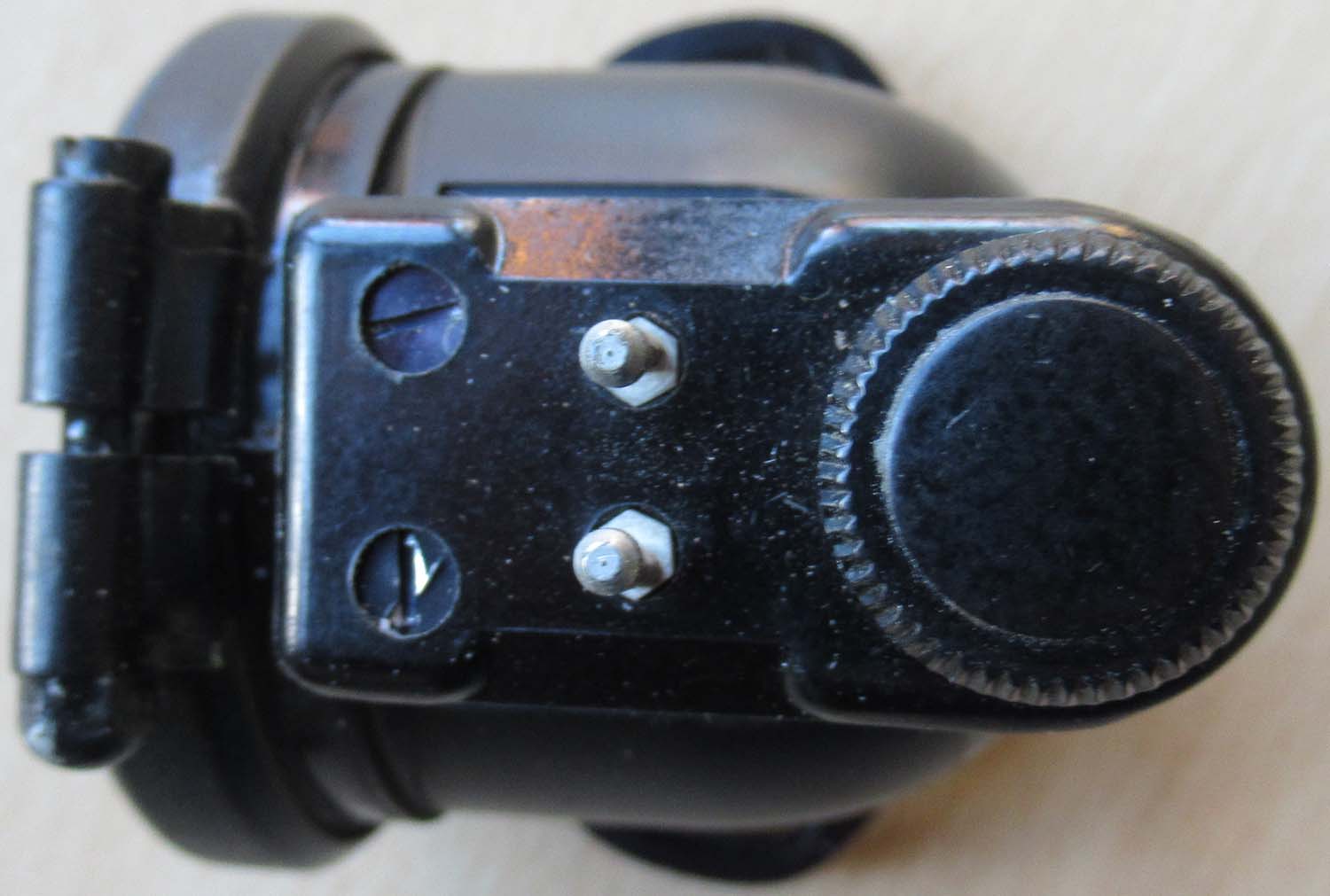 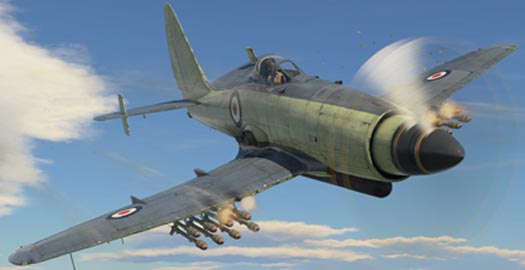
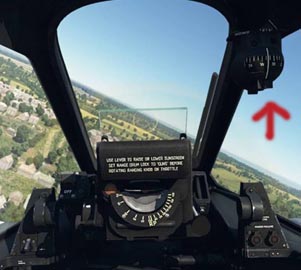
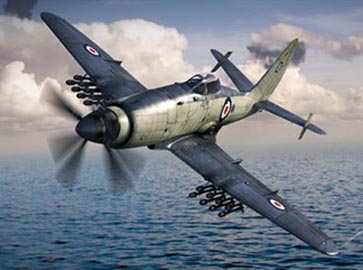
Shown above
centre in situ in a Westland Wyvern .
After
carrier trials which started on the 21st June
1950 the Wyvern entered service with the Fleet Air Arm from
May 1953 and were withdrawn from service by 1958. While in
service Wyverns equipped 813 Naval Air Squadron, 827
Squadron, 830 Squadron, and 831 Squadron of the Fleet Air
Arm. Squadron 813 was the last Wyvern squadron to disband
on the 22nd April
1958.
From September 1954, during
813’s first tour of duty with Wyverns in the Mediterranean
on board HMS Albion, many Wyverns suffered (some were lost
off the bows) from flameout during catapult launches due to
fuel starvation from the high G forces involved on
lunching. The problem was not fixed until March 1955 and it
resulted in the tour being cut short when 813 was left off
at Malta due to the high operational losses. In fact, Lt.
B. D. Macfarlane made history when he successfully ejected
under water after his Wyvern had ditched on launch and been
cut in two by the carrier (thanks John for your “comic”
memories).
Wyverns saw active service in Operation Musketeer with 830
Squadron, operating from HMS Eagle, during the 1956 Suez
Crisis. They mounted the first attack on the 1st November
1956 by attacking Egyptian airfields near the canal. A total
of 79 sorties were flown by the 6th November
when the operation was called off. Two Wyverns were lost,
at least one to ground fire.
As the largest prop-driven
single-seat airplane to go aboard Royal Navy carriers the
Wyvern was not easy to fly. 33 Wyverns were lost to all
causes during its four year operational career. Its range
was so limited that it needed a large centreline fuel tank
in addition to the wing tanks, which meant it could not
carry a torpedo, and when it was carrying enough fuel to
have an adequate range; it could not get off a carrier deck
even with a catapult while carrying its maximum ordnance
load. The Wyvern never lived up to the potential expected
of it and all of the airframes, except VR137, were melted
into scrap during 1959. However, the Wyvern holds the
distinction of being the only Royal Navy turboprop-powered
aircraft to see combat. |
|
Click on the
pictures to enlarge.
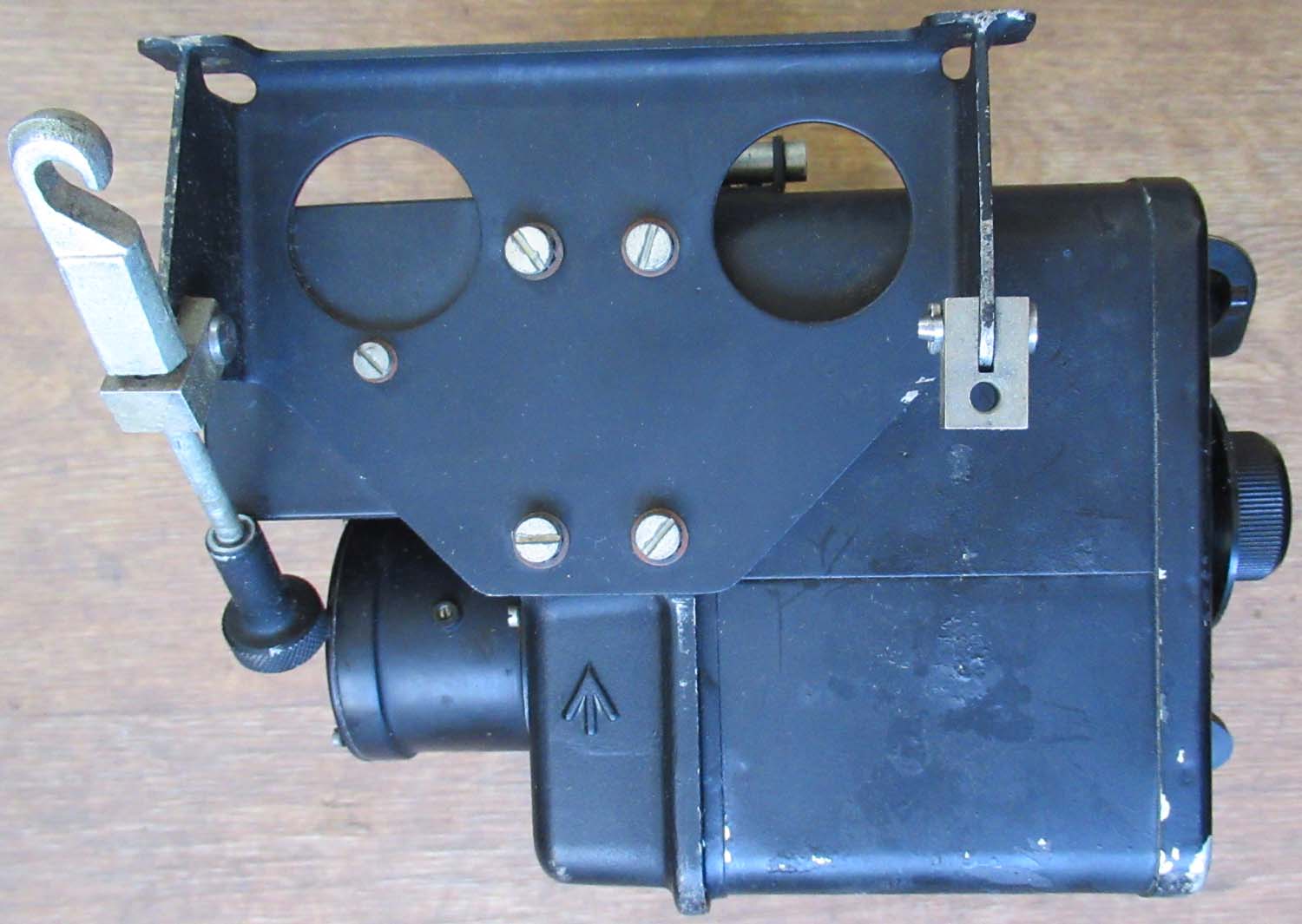
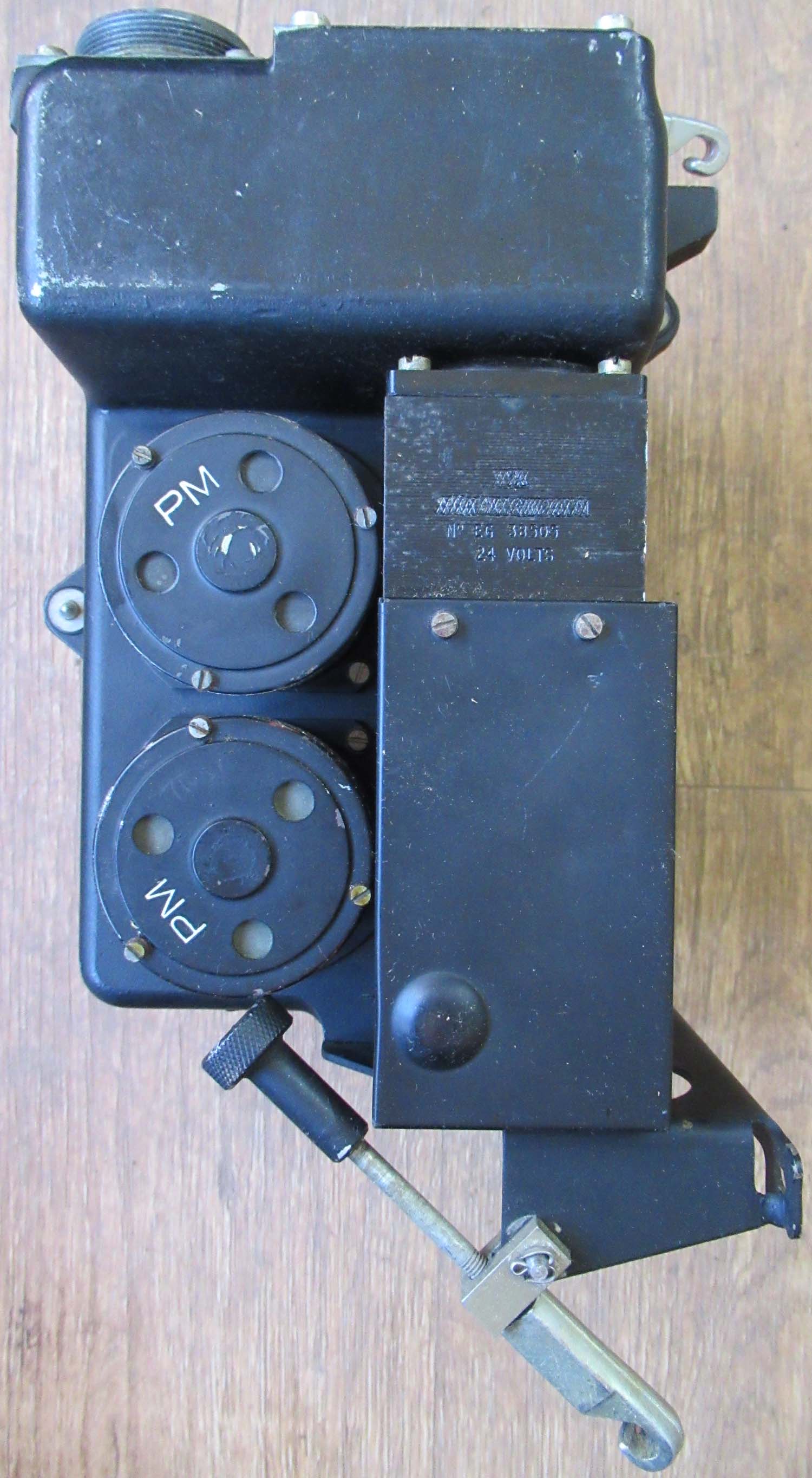
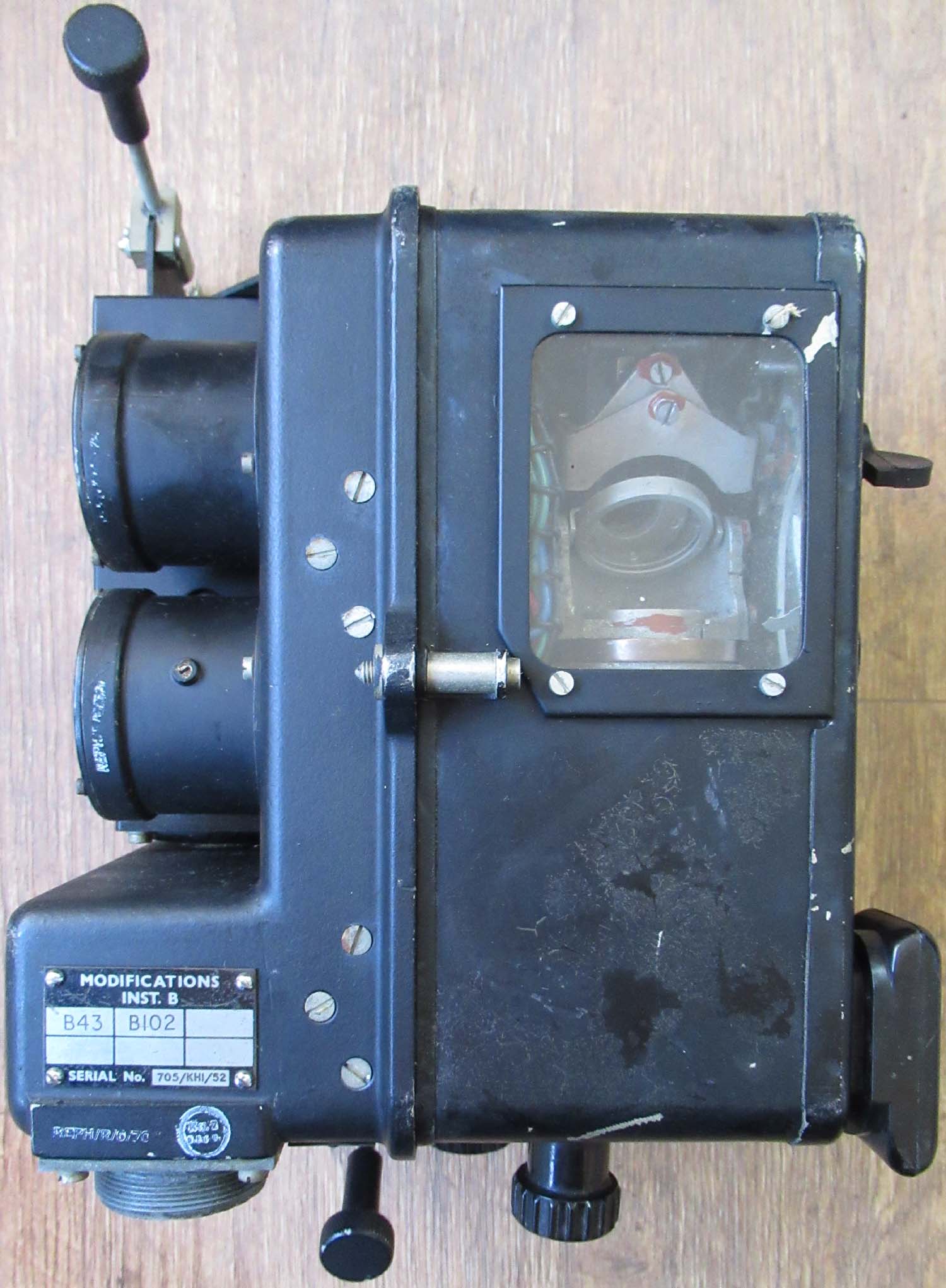 |
RAF Ground
Position Indicator MK I (pg
5 Clocks and compasses 68)
This is a ground position
indicator MK I in nice original condition as fitted to
many of the RAF's heavy Bombers including the Lancaster.
Click on the
pictures to enlarge.
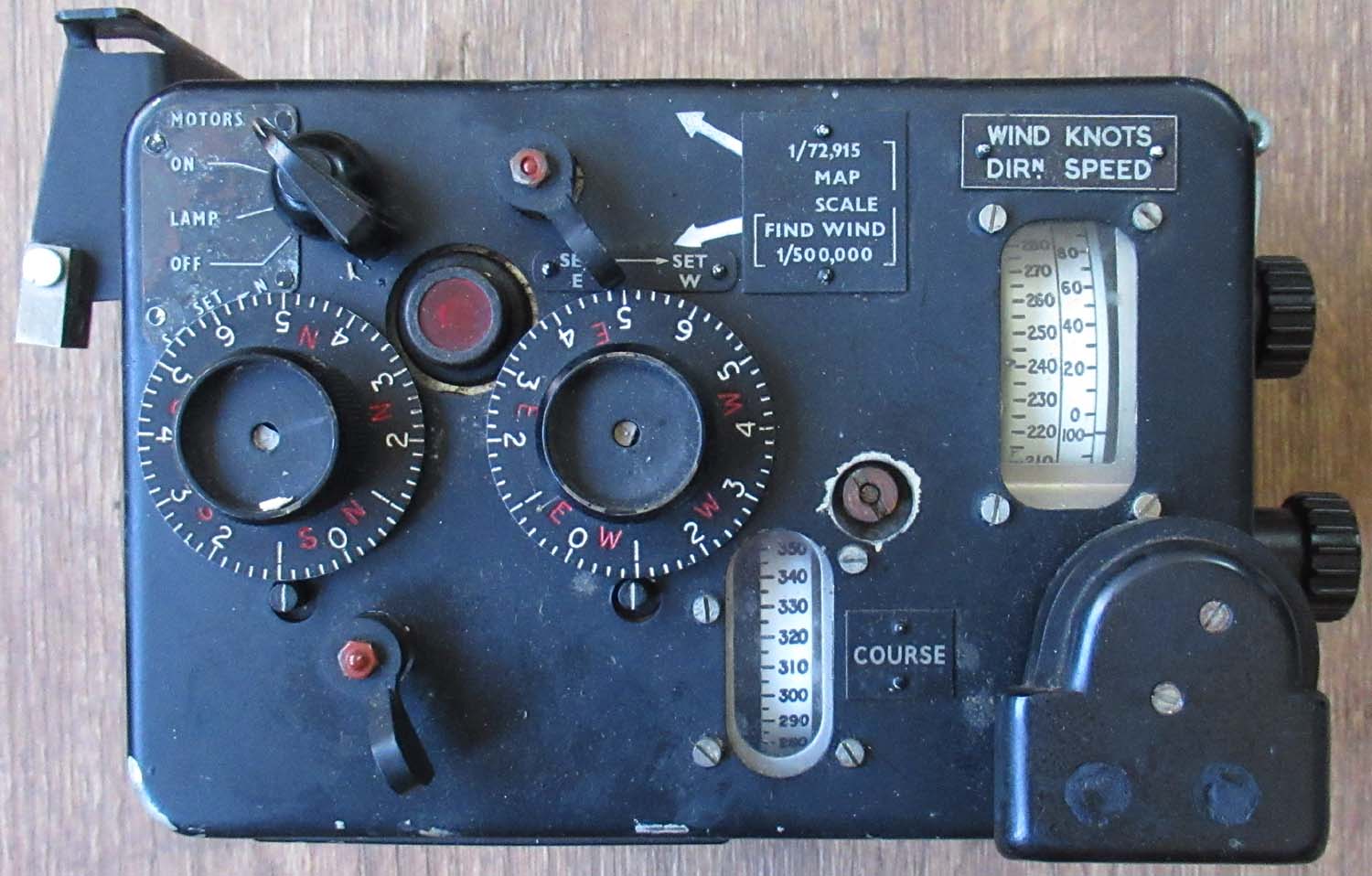
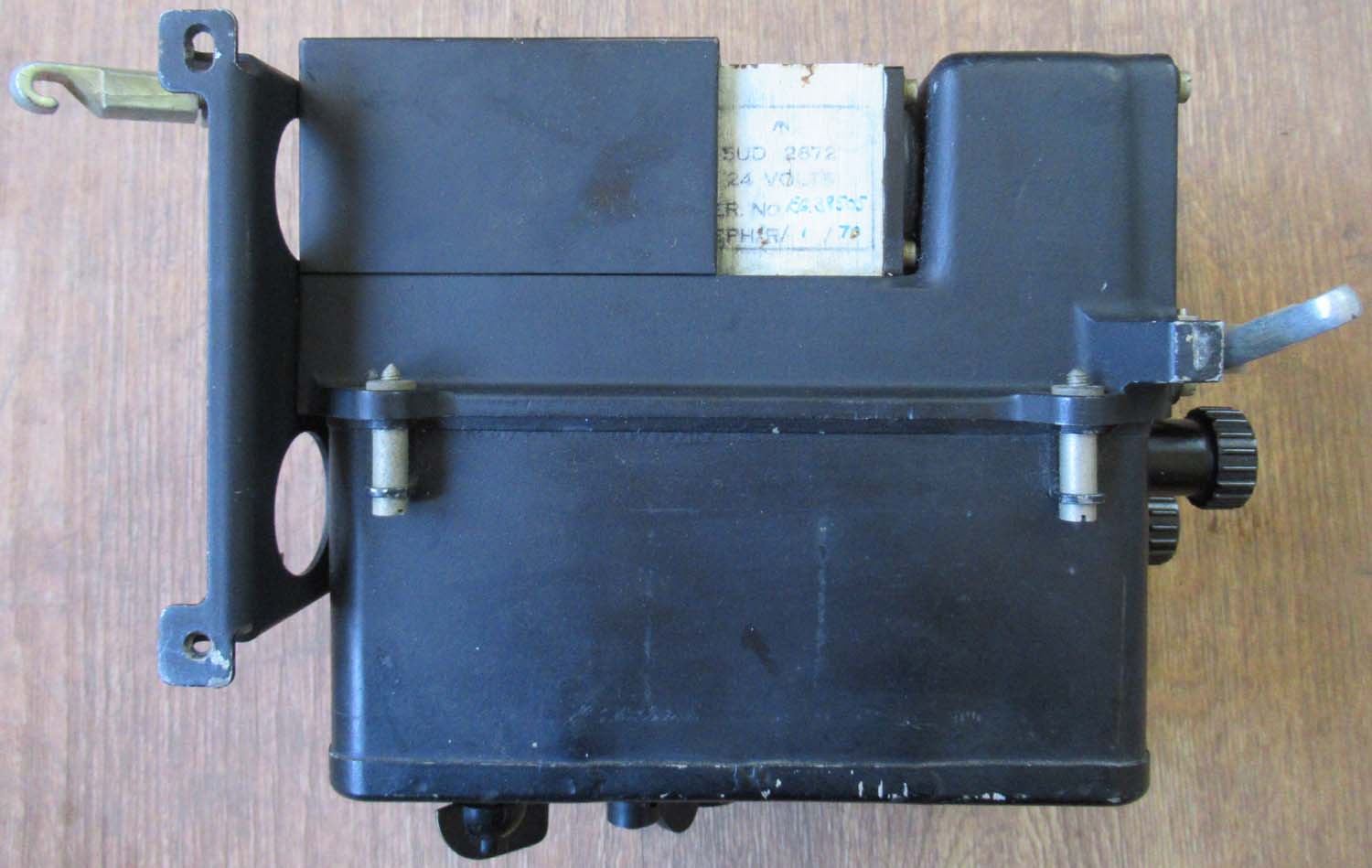
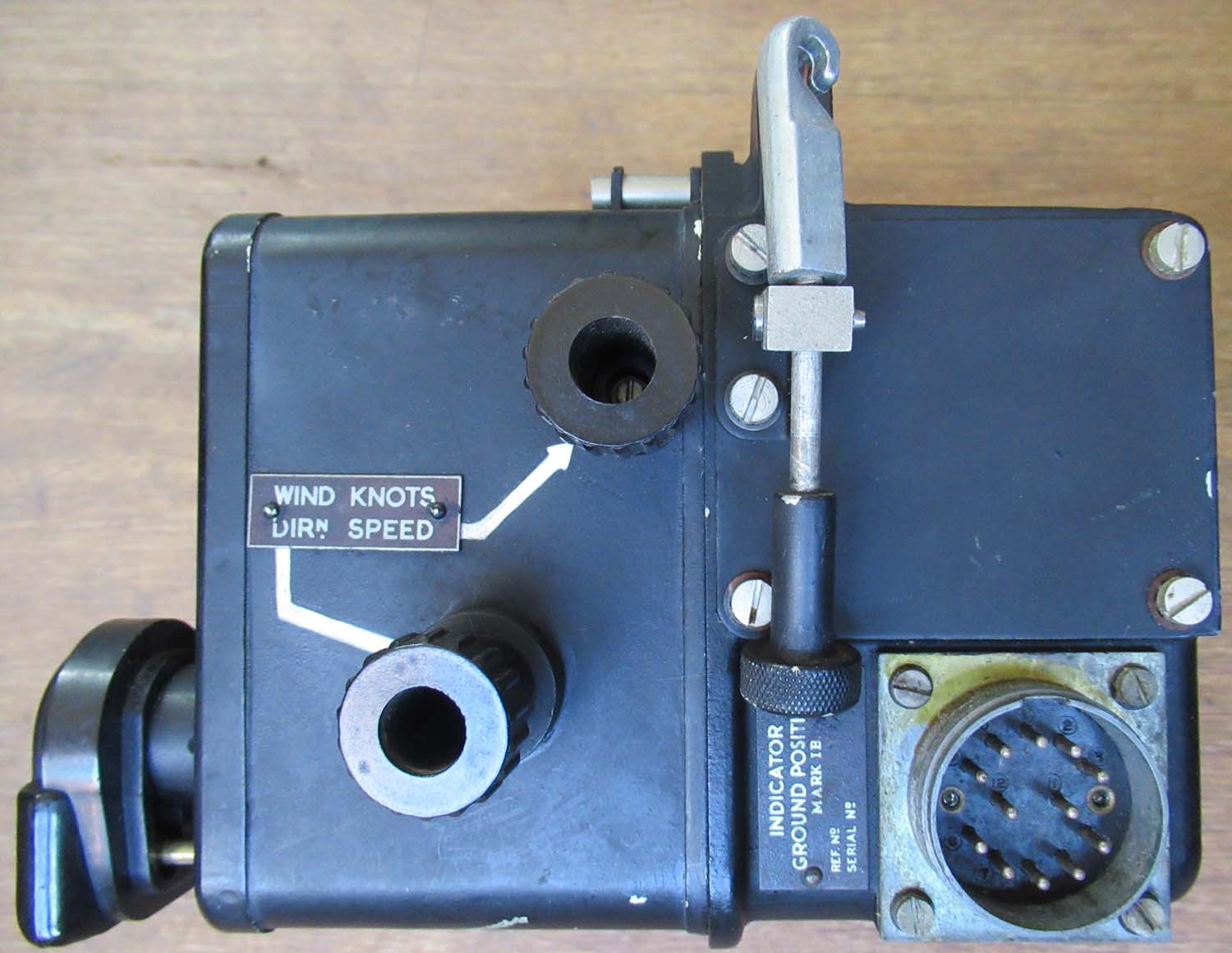
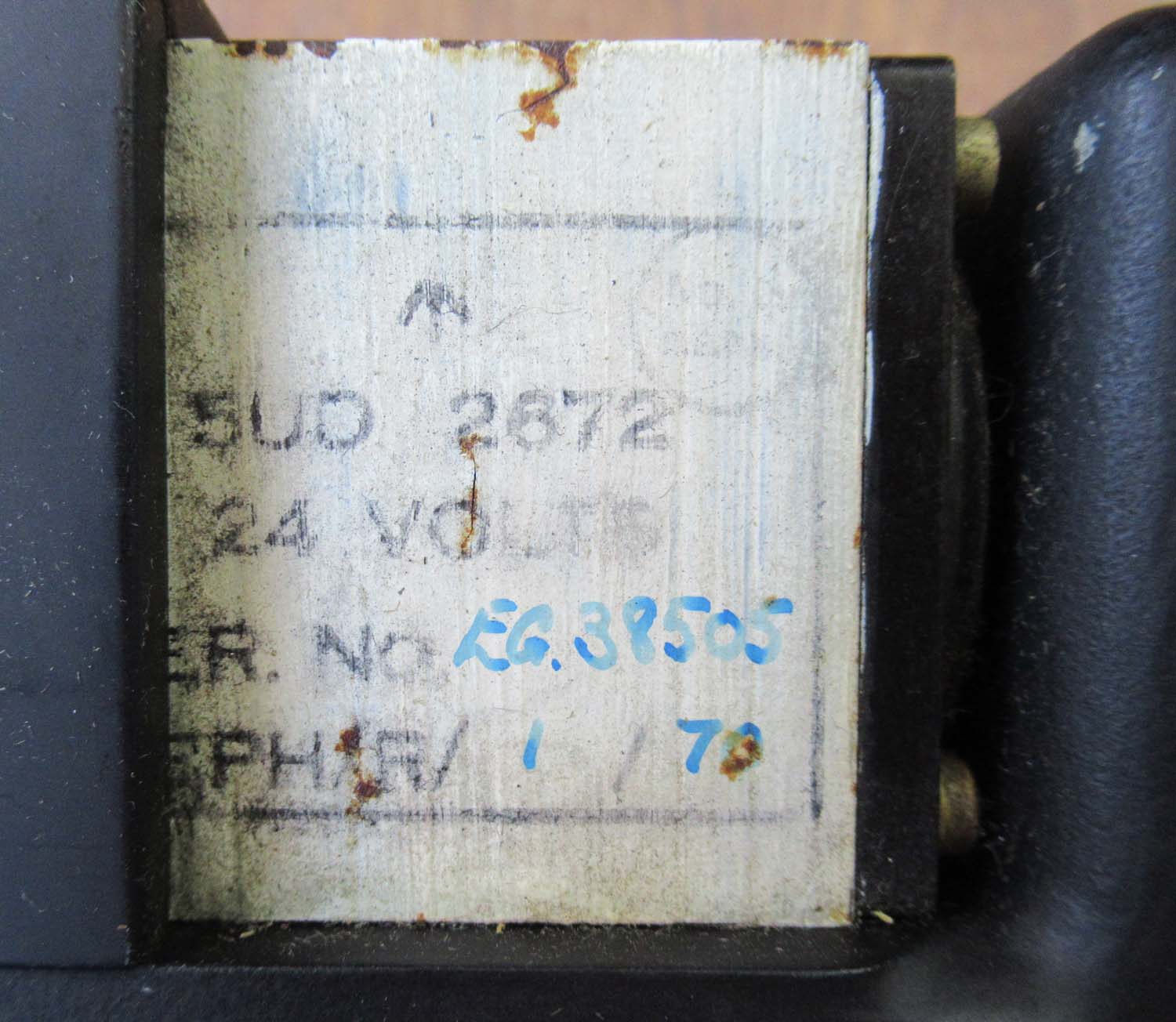
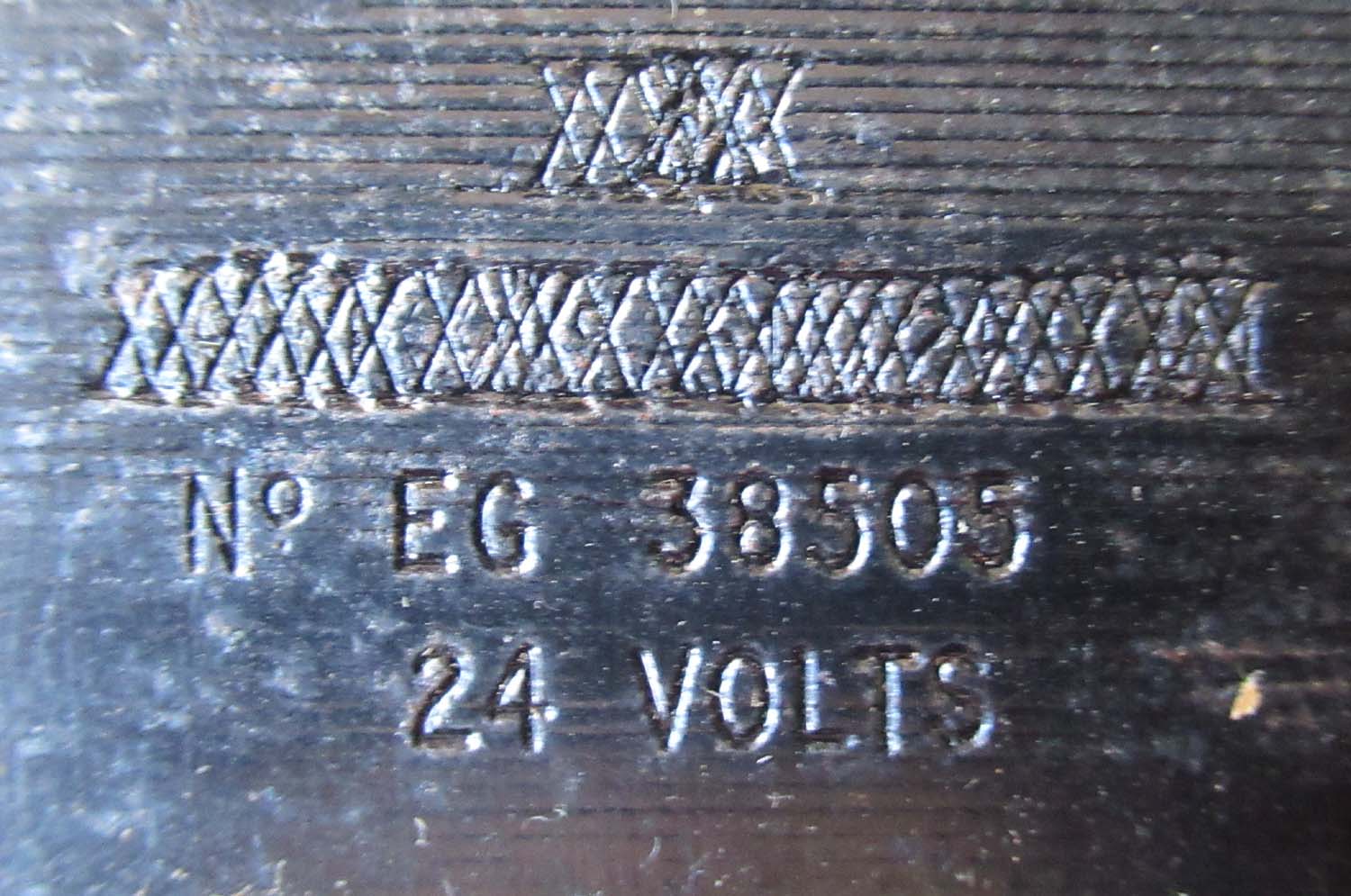
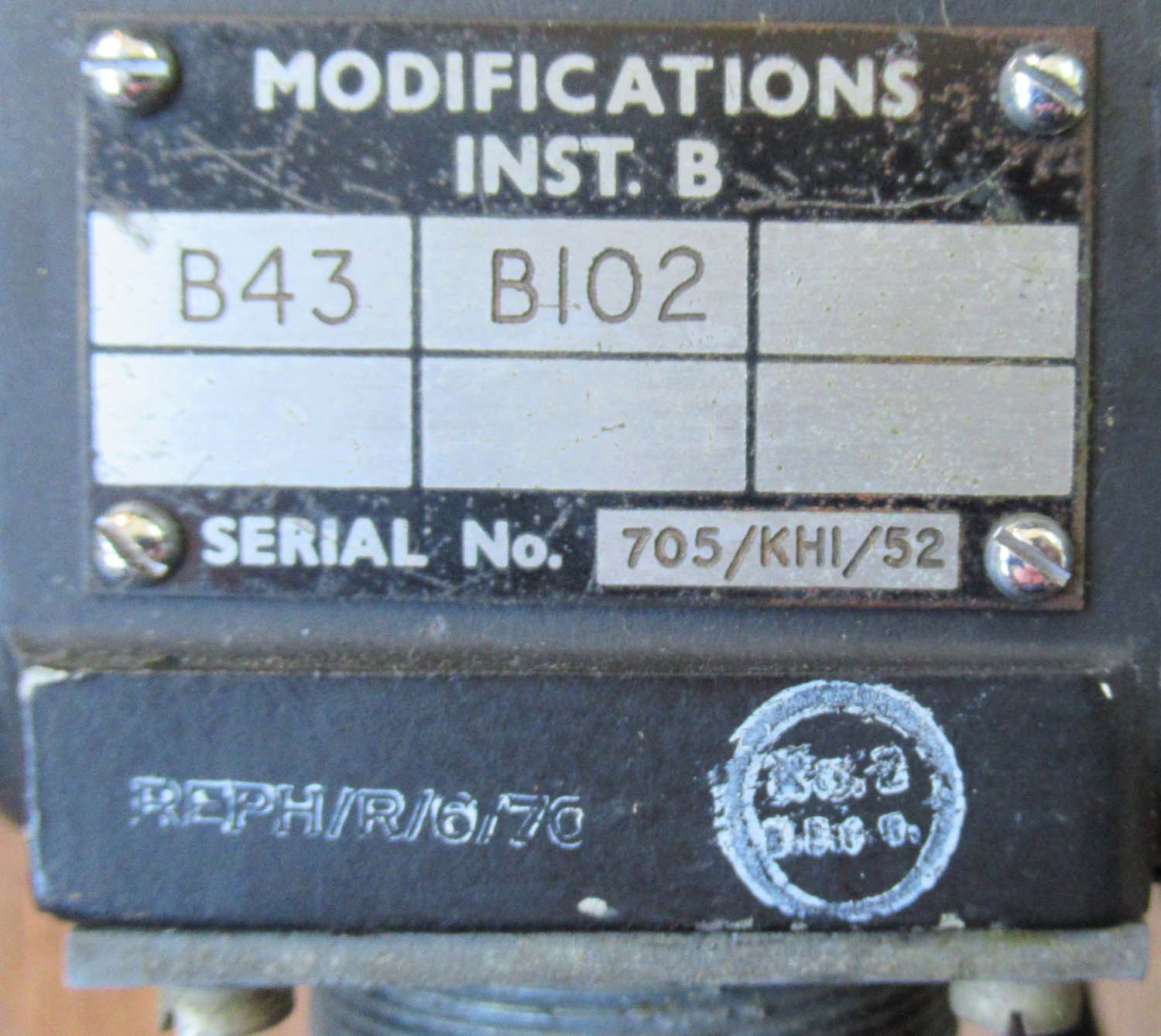
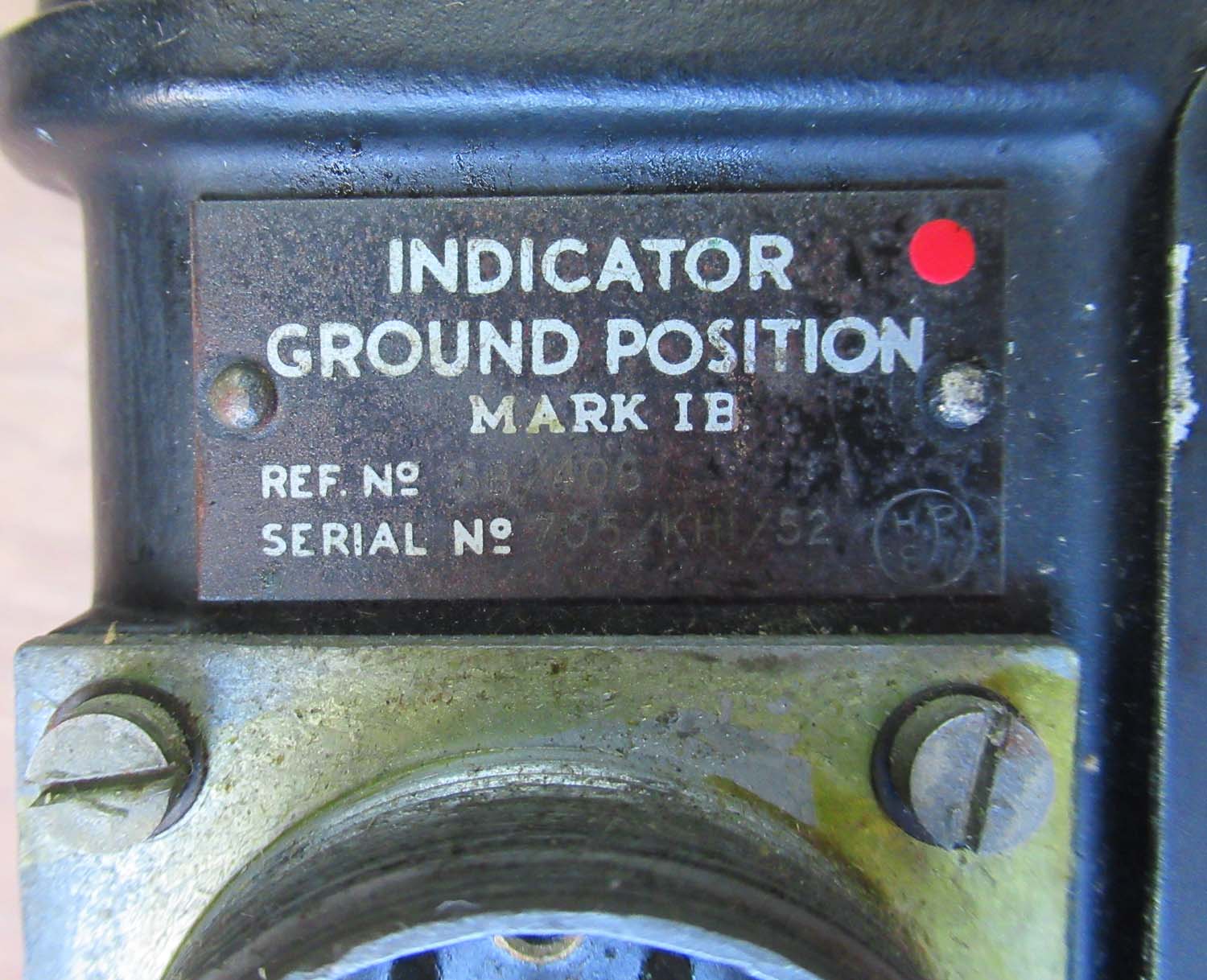
This does what it
says on the box
it is an instrument that determines and
displays automatically the DR (dead reckoning) position of
an aircraft. It gets its data from an ASI (air speed
indicator) and a compass.
Seen
below fitted in a Lancaster.
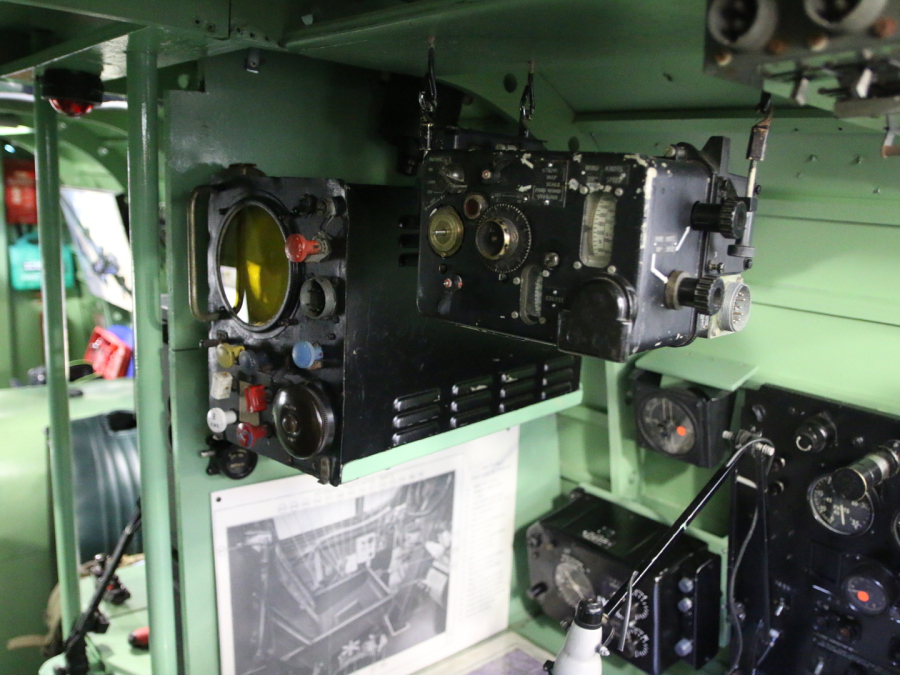
Out of stock
more wanted please
contact me
|
|
Click on
the picture's to enlarge them.
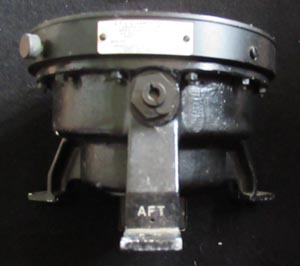
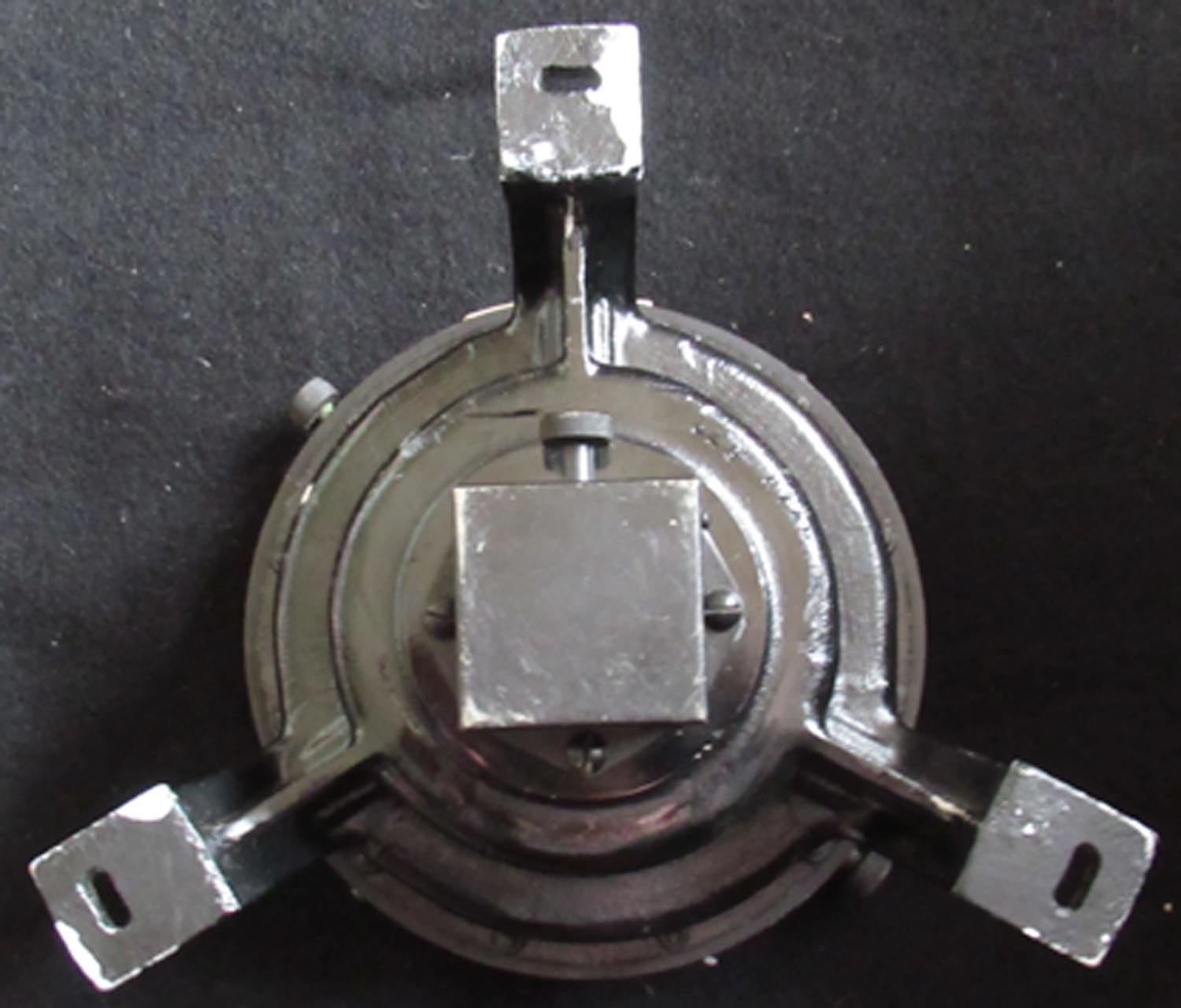
£ 295


|
Type 12D B17
Compass
(Pg 5 Compasses and Clocks 66)
 Here
is a
nice
example of the Type 12D Compass used in both the B17 Flying
fortress and B24 Liberator . Its in good condition with its
mounting lugs and compass corrector. There is no longer any
fluid having evaporated over the years but still functions
as it should.
Click on
the picture's to enlarge them.
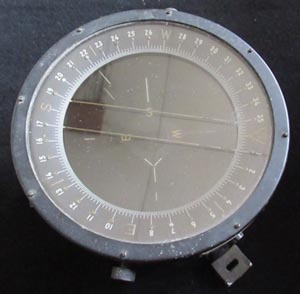 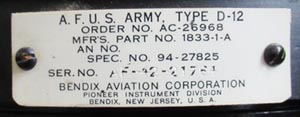
|
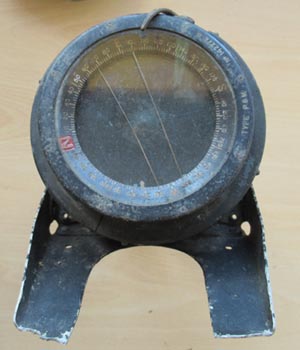
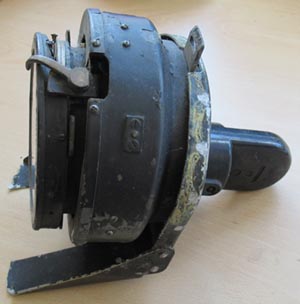
|
Type P8 Compass
with compass tray (Pg 5 Compasses and Clocks 65)
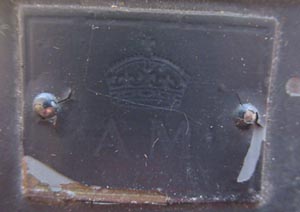
Here we have a Type P8
M
Compass. Used in fighters most commonly found in the
Spitfire this comes with a compass tray for mounting in the
aircraft and a compass correction.
The tray is not for the
Spitfire and so far have been unable to identify the
aircraft type it belongs to.
The compass has had some
heavy use and has some paint loss and no fluid.
£155


|
|
Click on
the pictures to enlarge them
6A/1248 Type 06A
No 40973 H
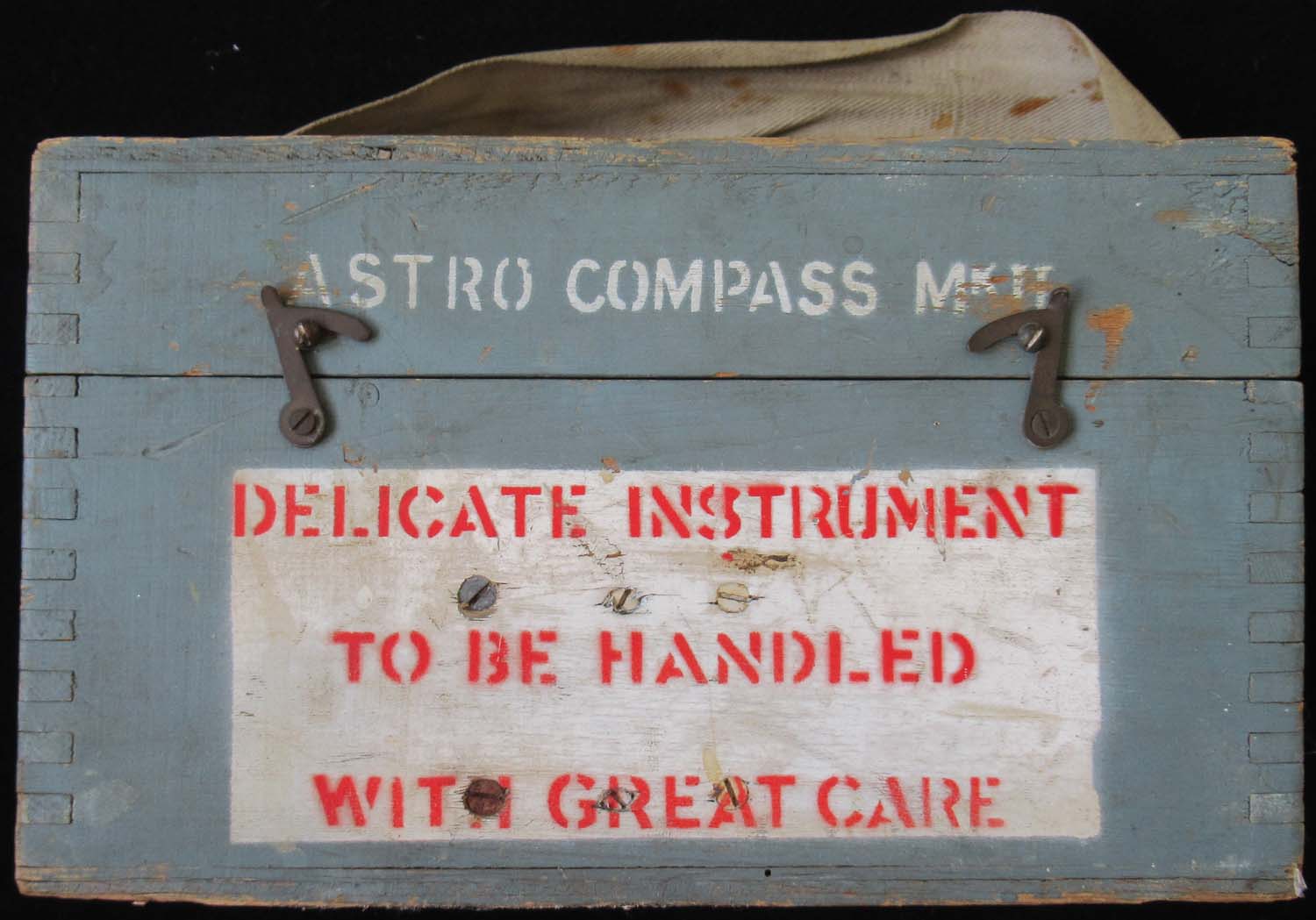
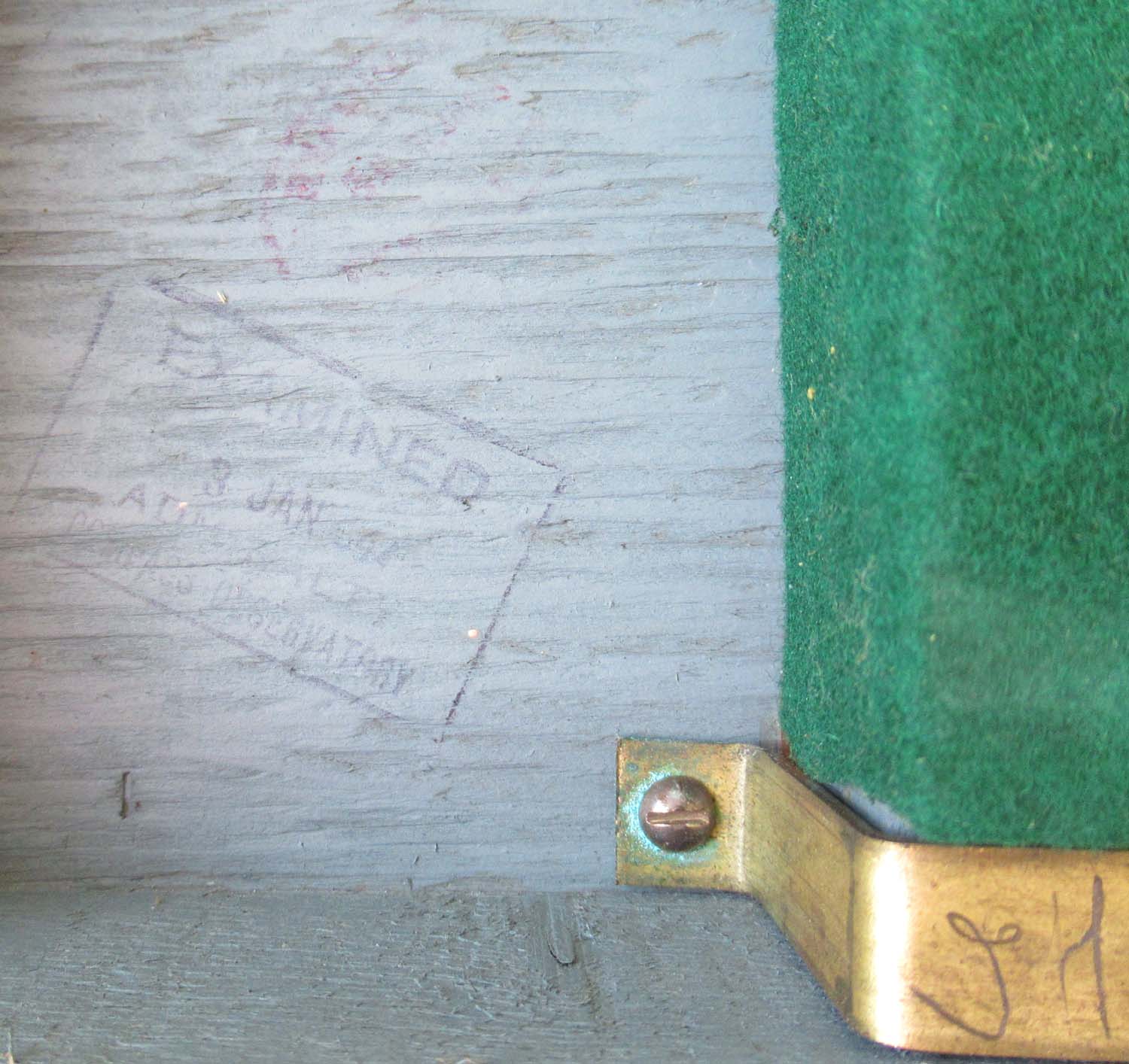
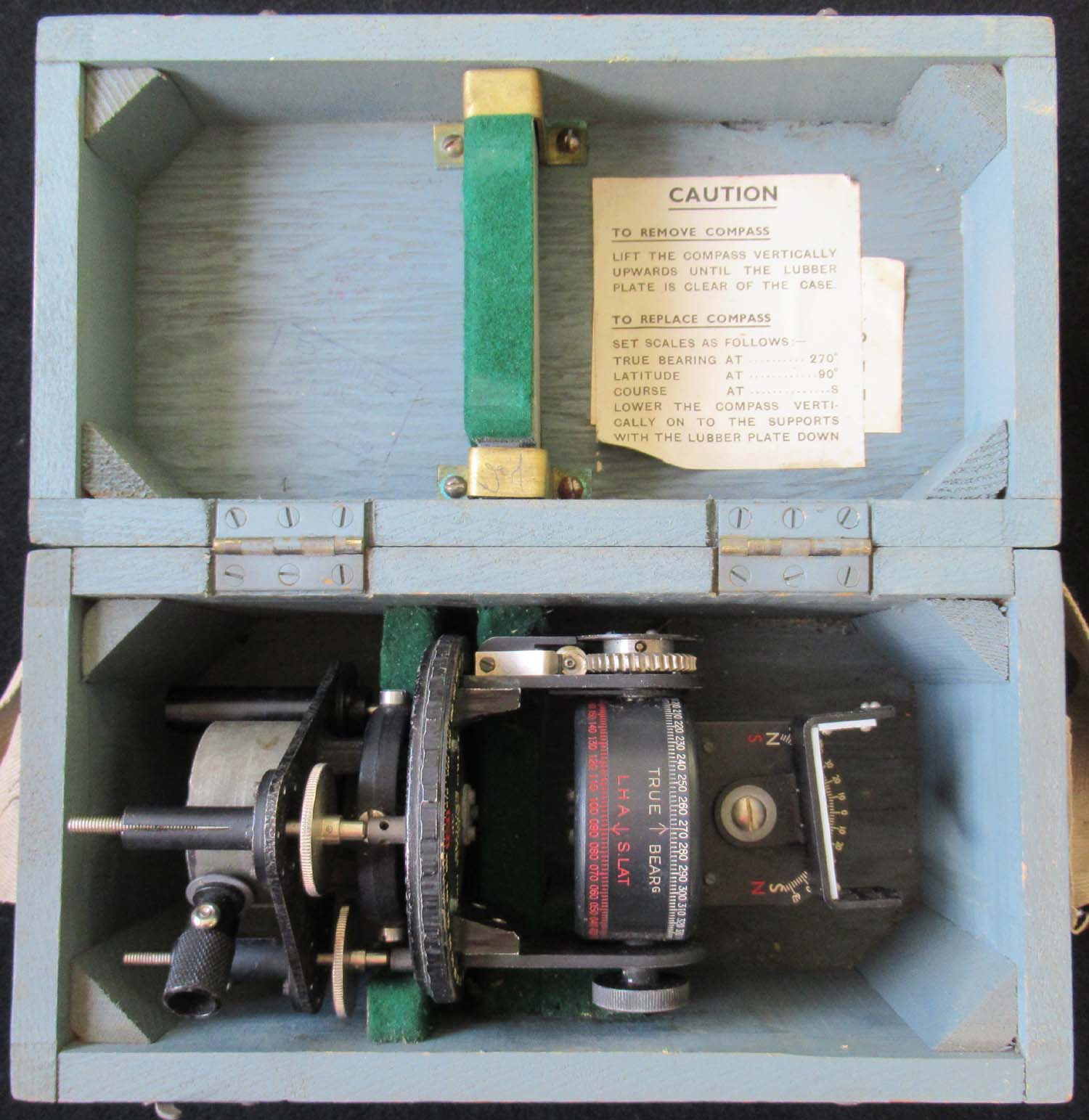 |
Astro Compass (Pg 5 Compasses and Clocks 64A)
Here we have a really nice boxed Astro compass
used by the navigators of heavy aircraft to navigate using the stars , they took
shots through the astrodome of the aircraft to plot their coarse. The Astrodome
see below in a Halifax heavy Bomber.
.jpg)
Click on
the pictures to enlarge them
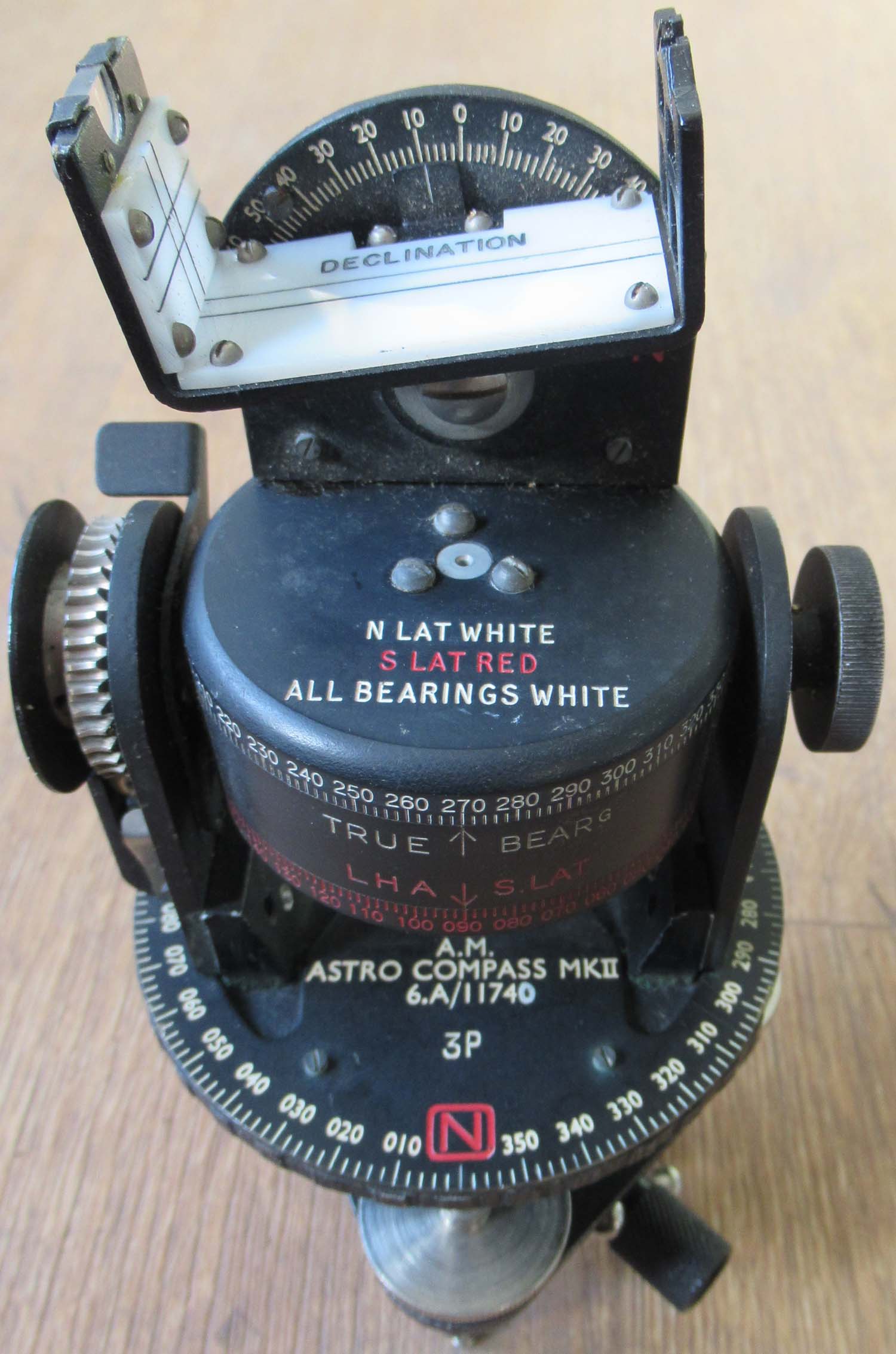
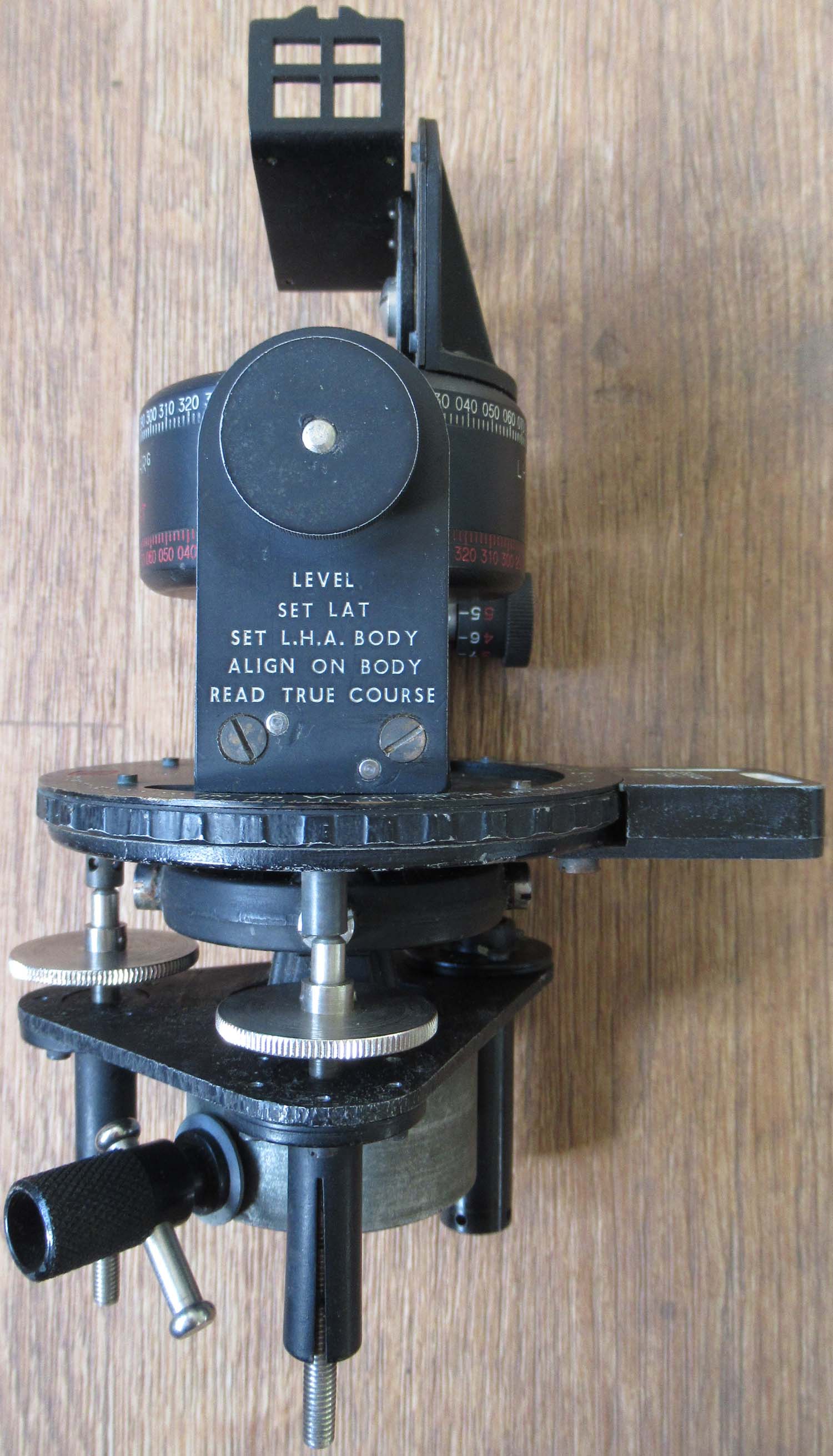
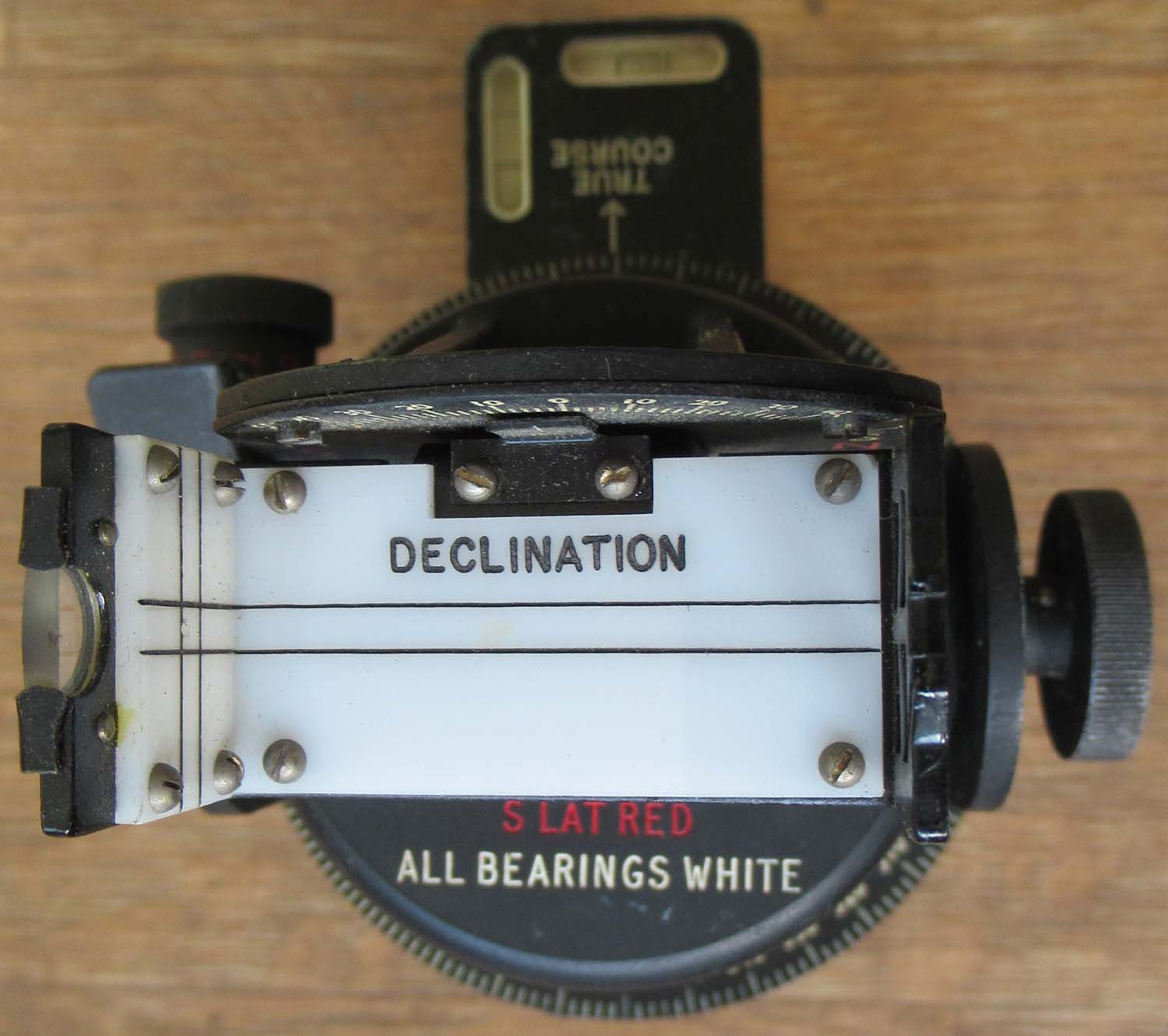
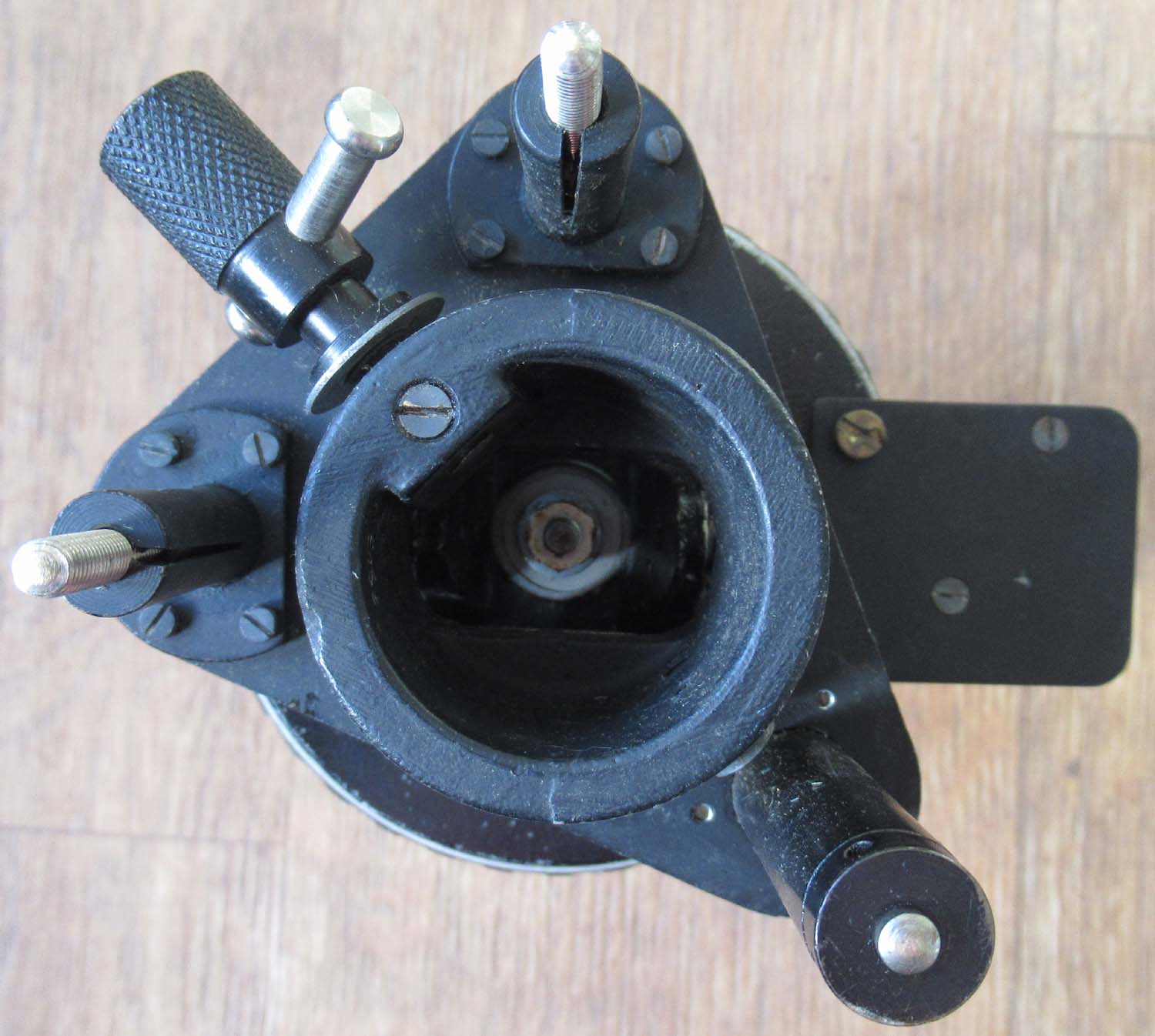
£265


|
|
Click on
the pictures to enlarge them

 |
Type 06A hand held compass (Pg 5 Compasses and Clocks 63A)
Here we have a Type 06A compass used in heavy WWII RAF bombers.
The type 06A was used in circumstances where the fixed type could not
conveniently be accessed. Being a handheld version the type 06A was illuminated
by a battery powered lamp in the handle. Very nice condition and in original
box.
6A/1248
No 40973 H
Click on
the pictures to enlarge them



£195


|
|
Click on
the pictures to enlarge them
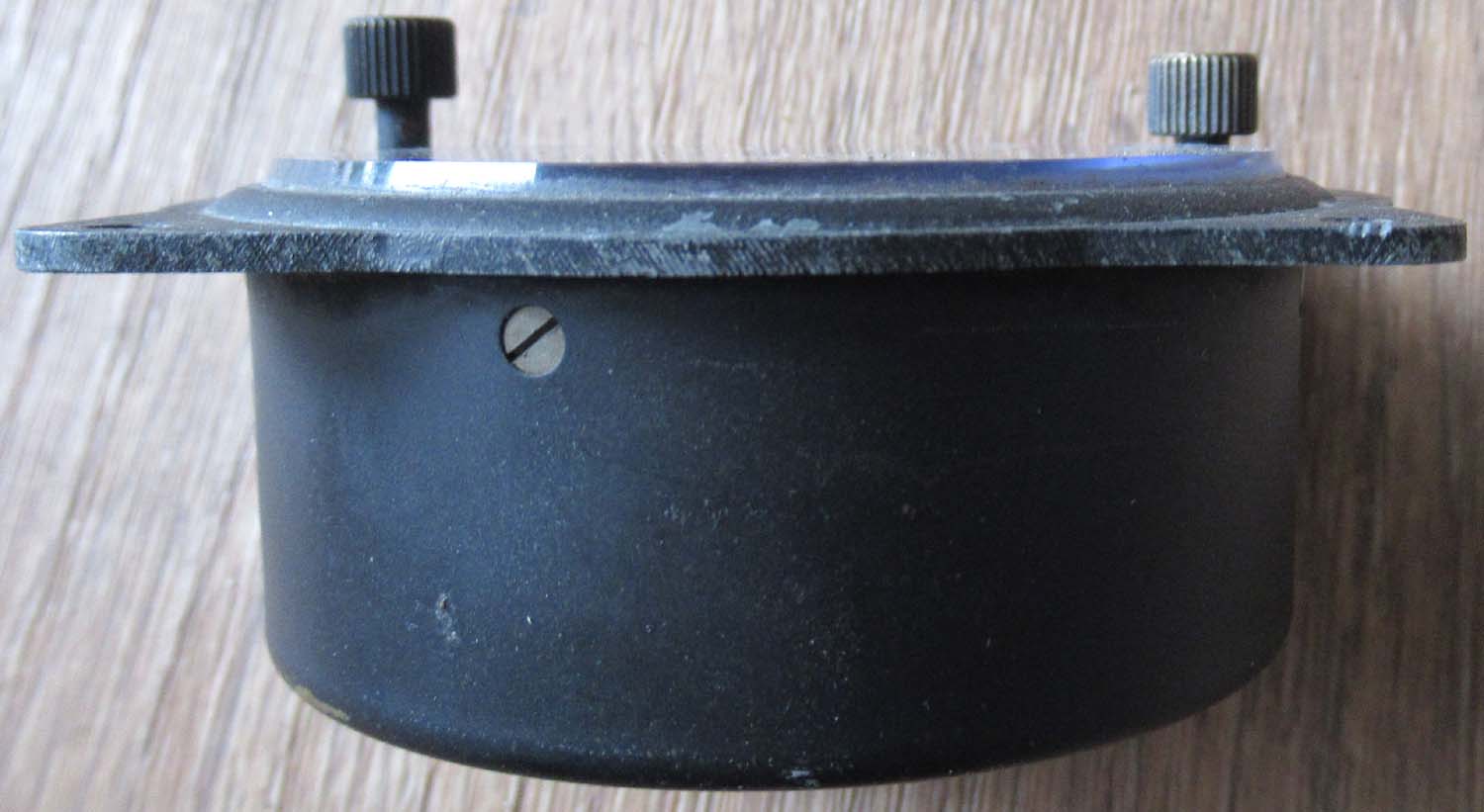
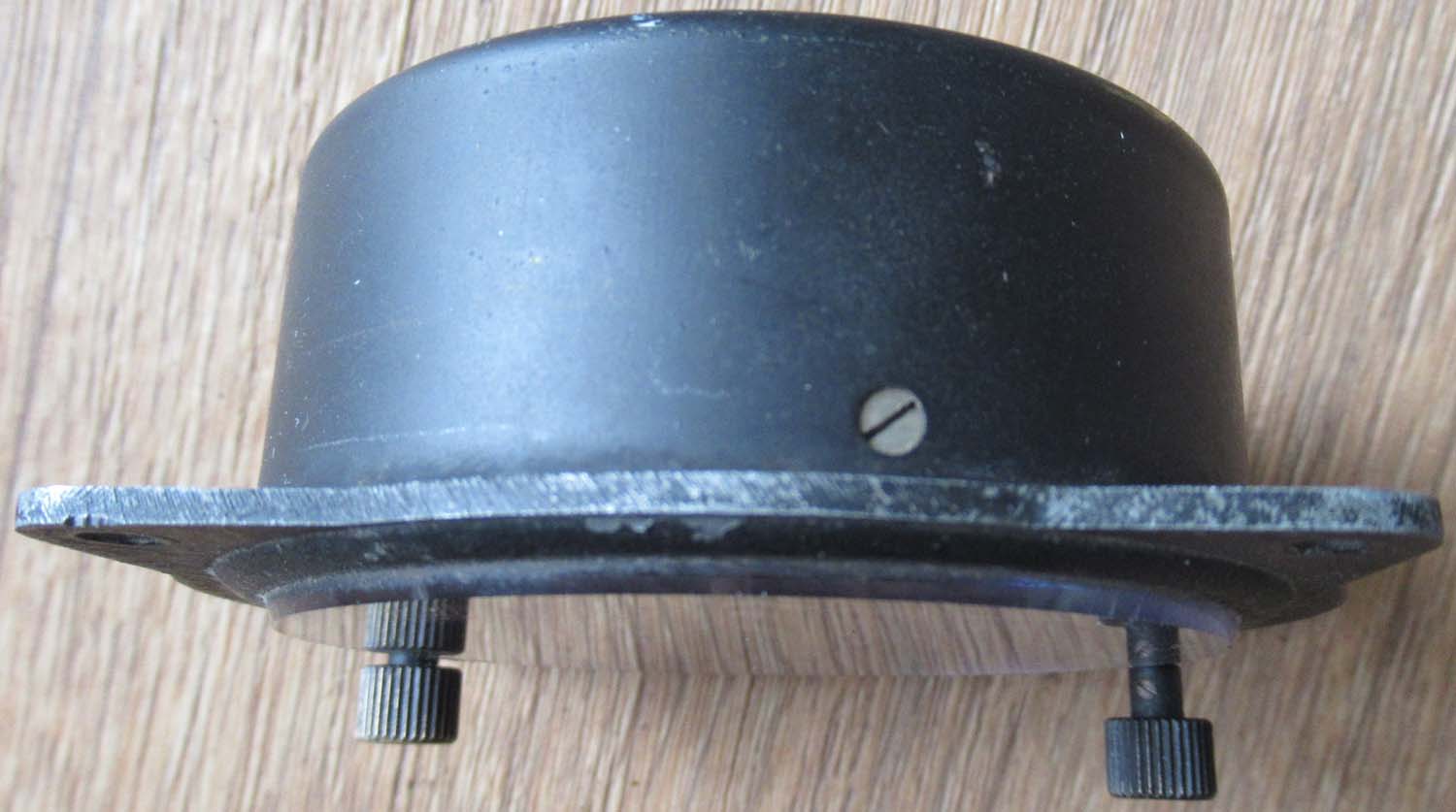
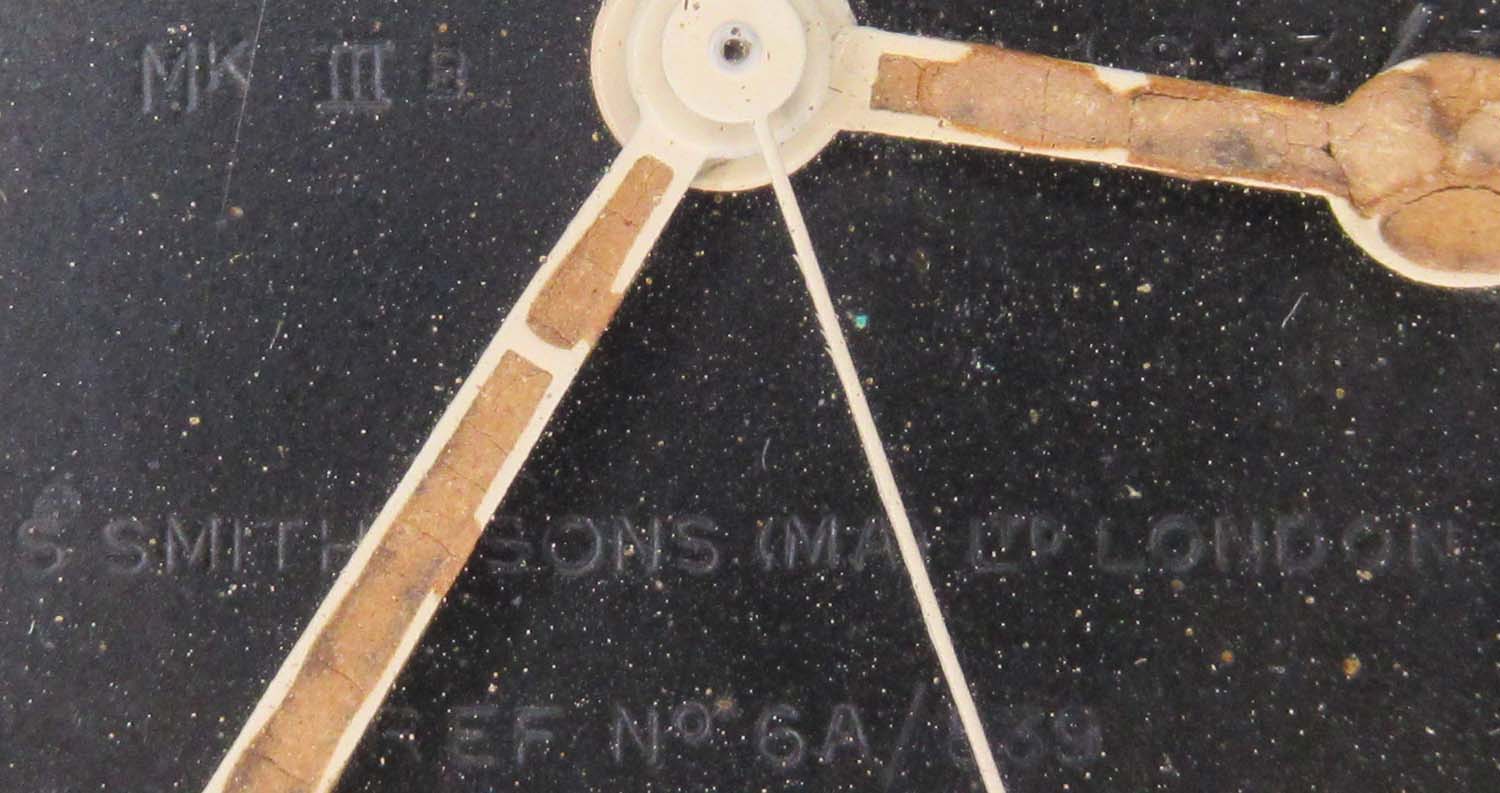
|
MK III Smiths 8 day clock dated 1938 (Pg 5 Compasses and Clocks 62D)
This is the classic
early 8 day clock fitted in early
Spitfire and Hurricanes along with other wartime and pre war
RAF aircraft.
This clock is in good original condition
and has run for a week without any issues.
Dated 1938
Click on
the pictures to enlarge them
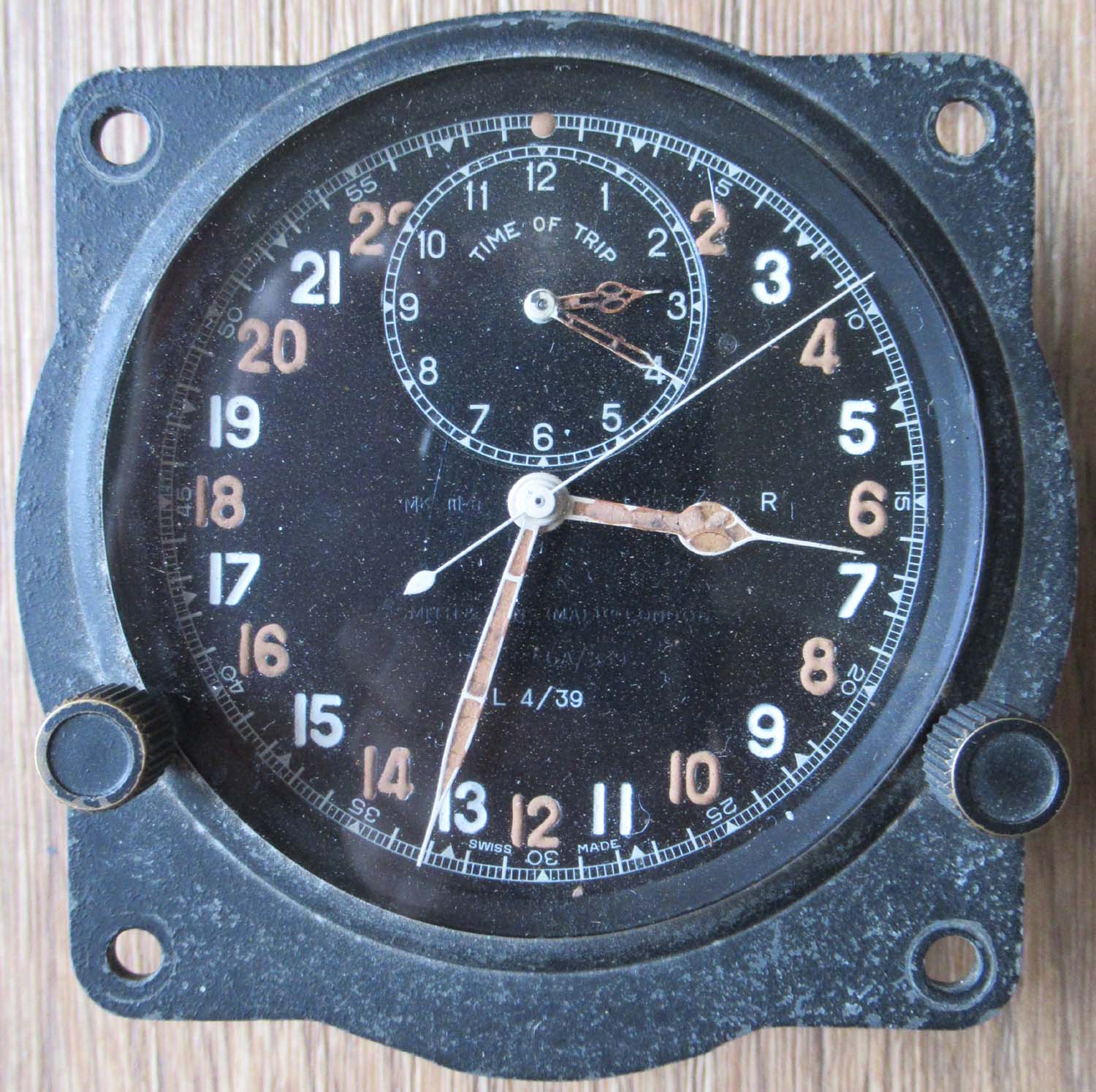 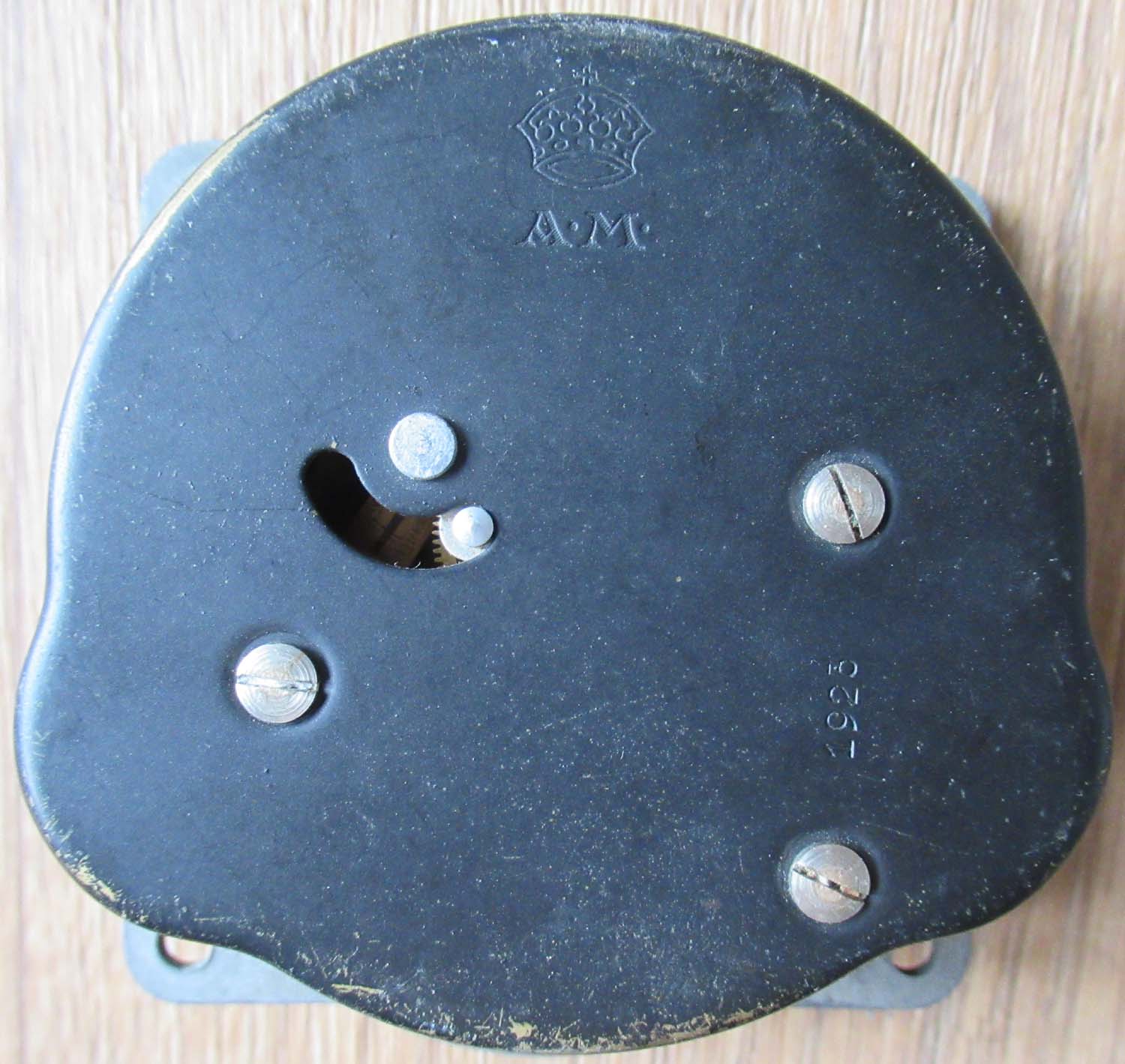
Out of stock more wanted please
contact me |
Click on
the pictures to enlarge them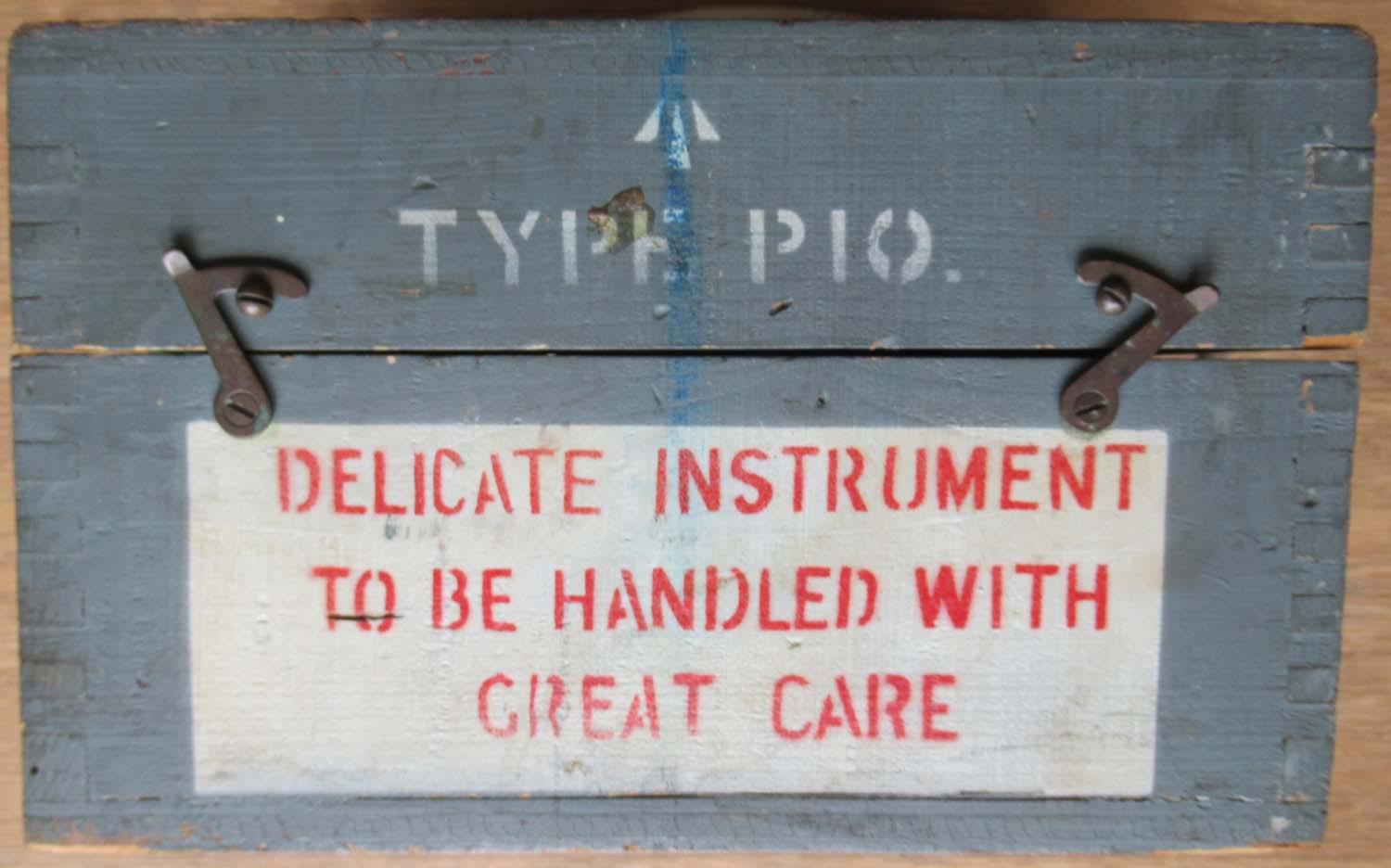
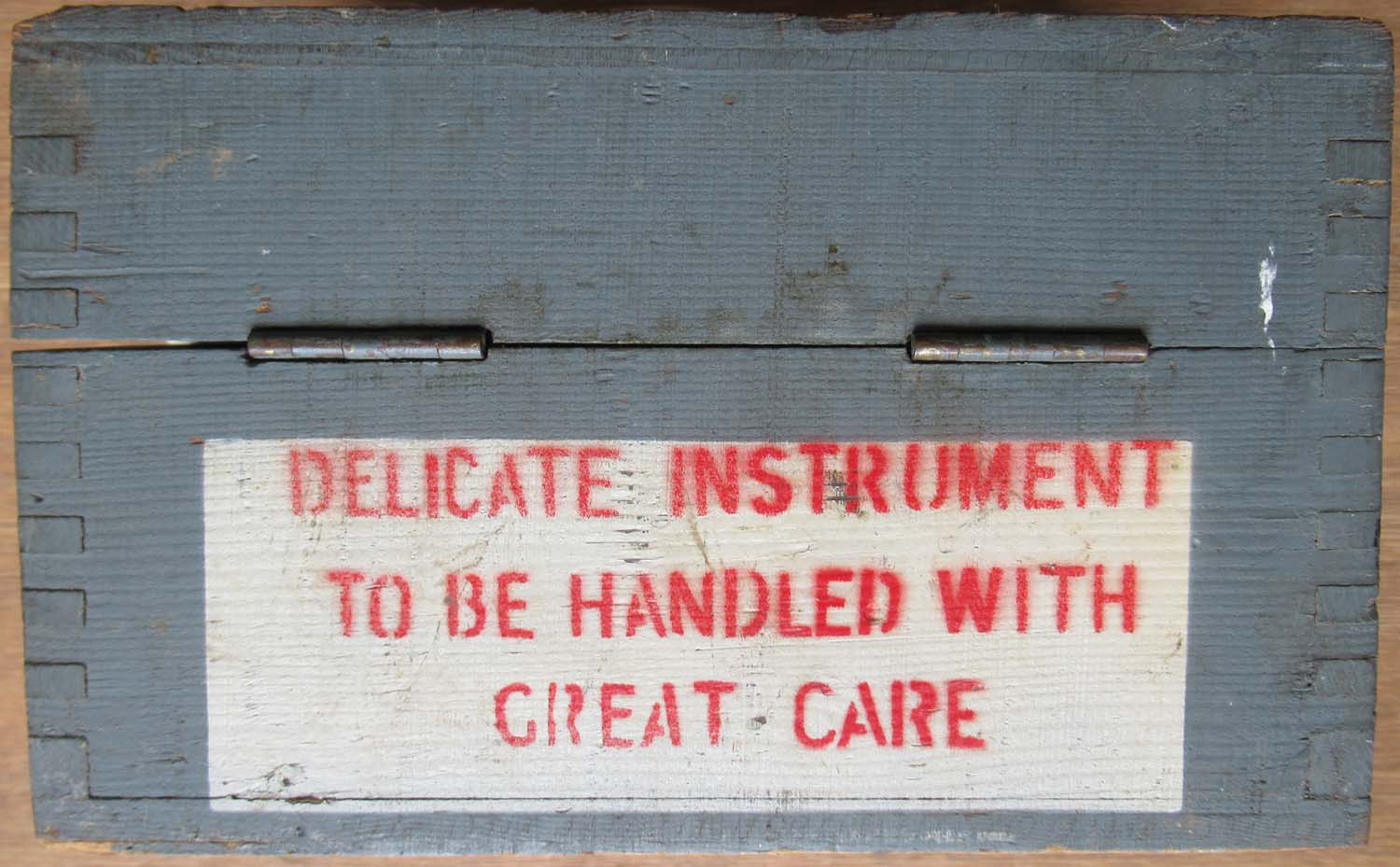
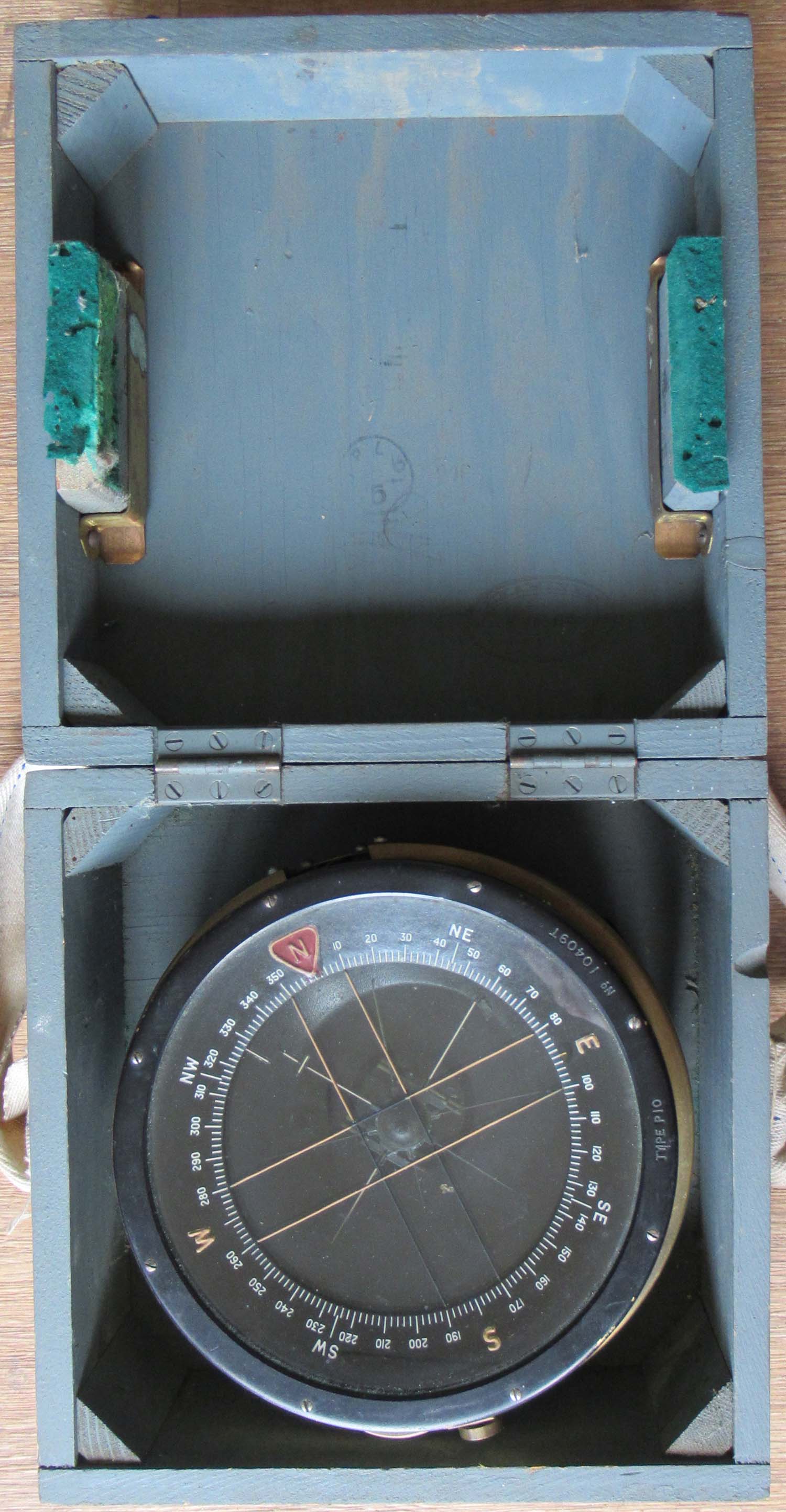 |
P4 Heavy Bomber compass (Pg 5 Compasses and Clocks 61)
Here we have a P4 compass as used in the
Lancaster and other heavy WWII RAF bombers.
Although similar in appearance these are
approximately 20% larger than the P8 fighter type.
This one has had its paint removed to expose the
brass . Unfortunately it no longer has its fluid but still works as it should.
6A/1671
Click on
the pictures to enlarge them
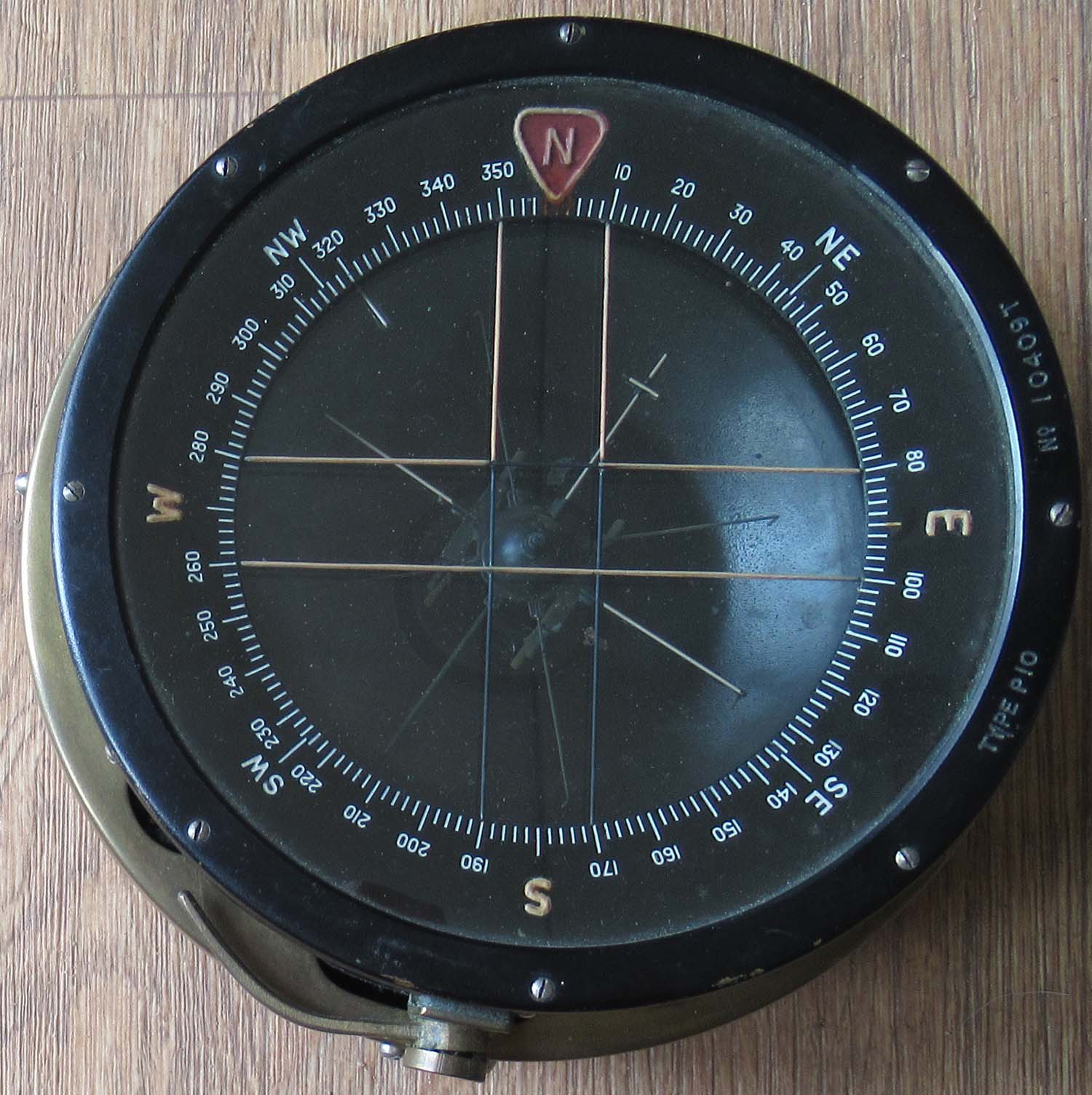 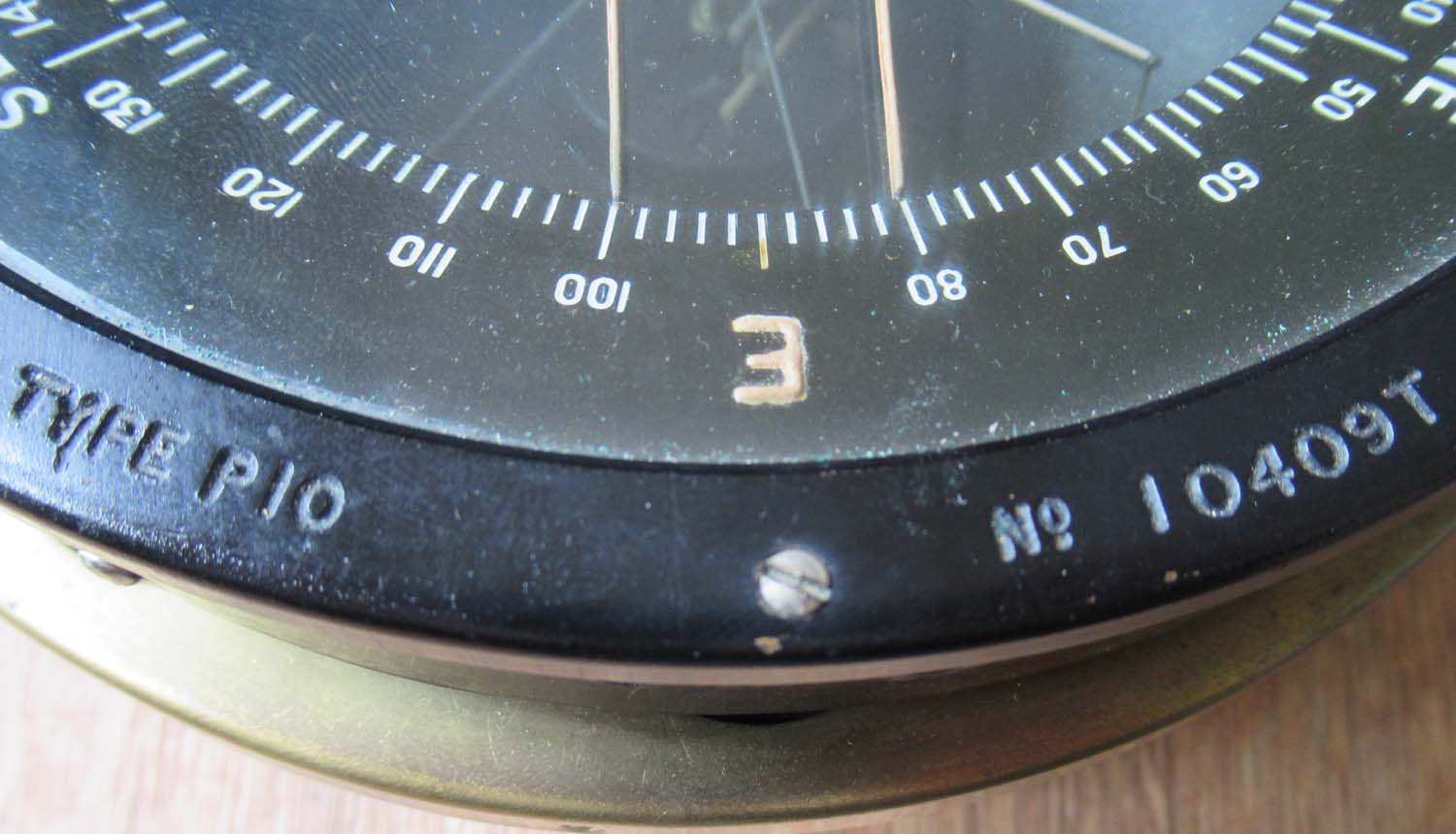 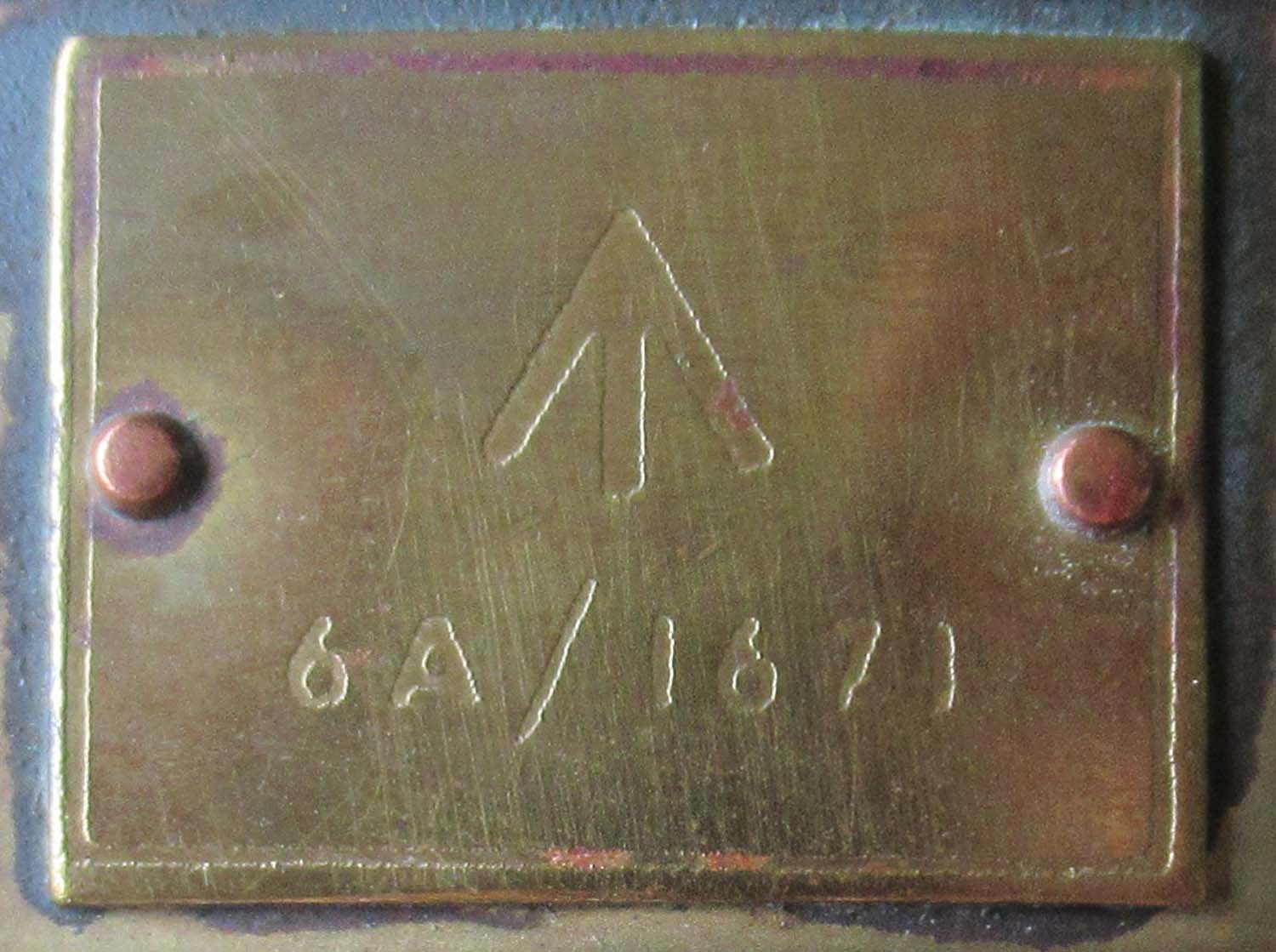 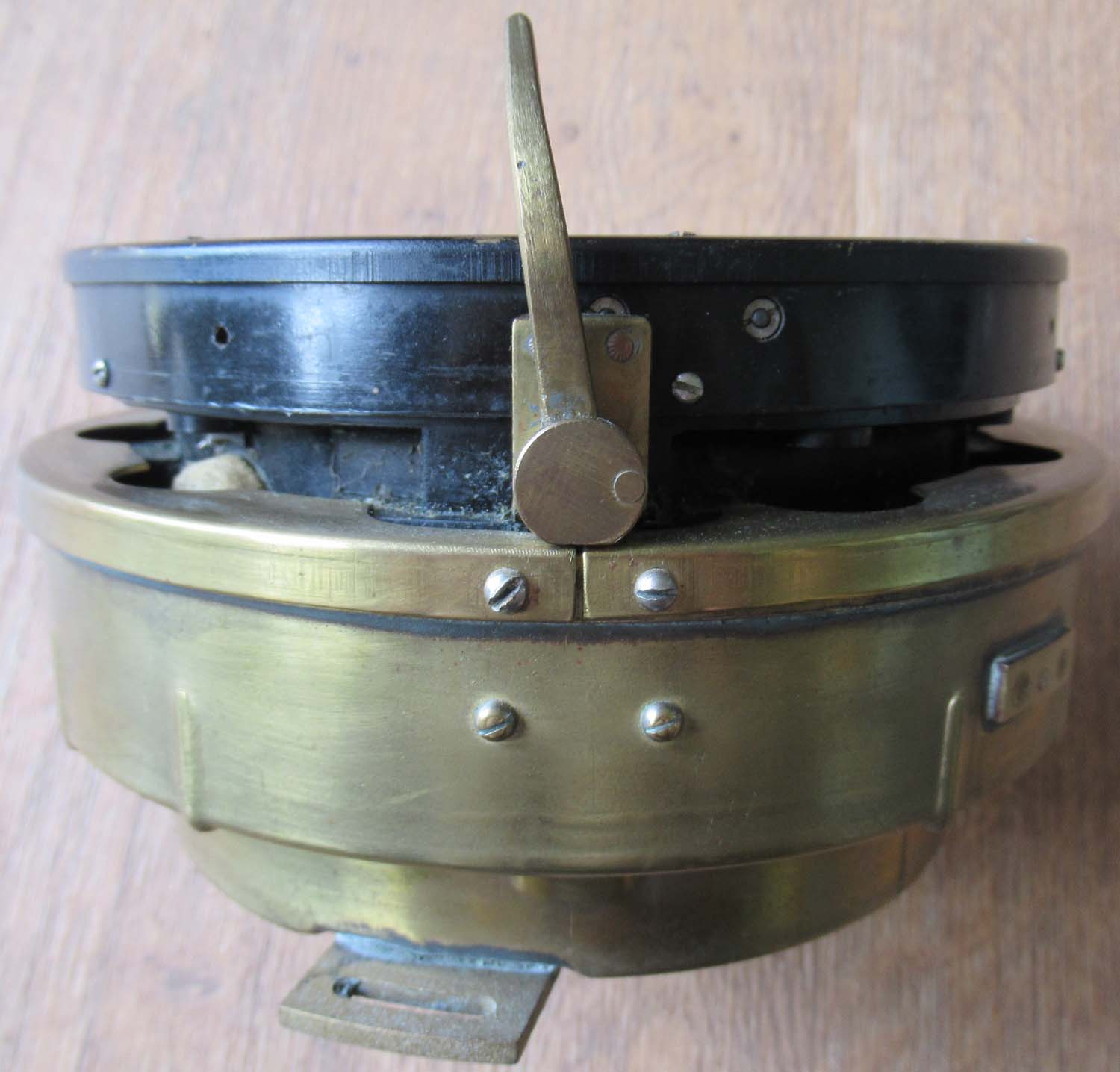
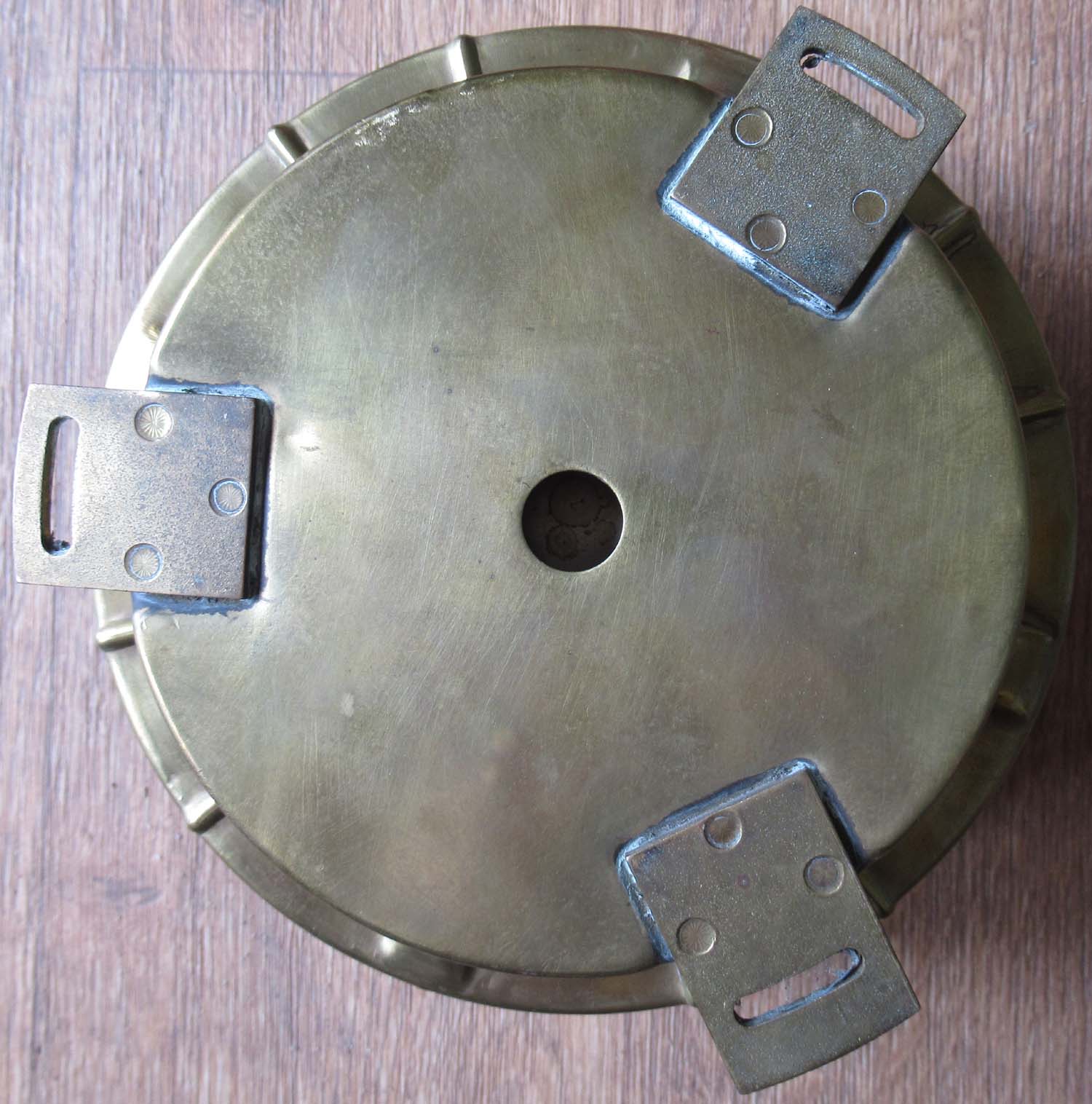
 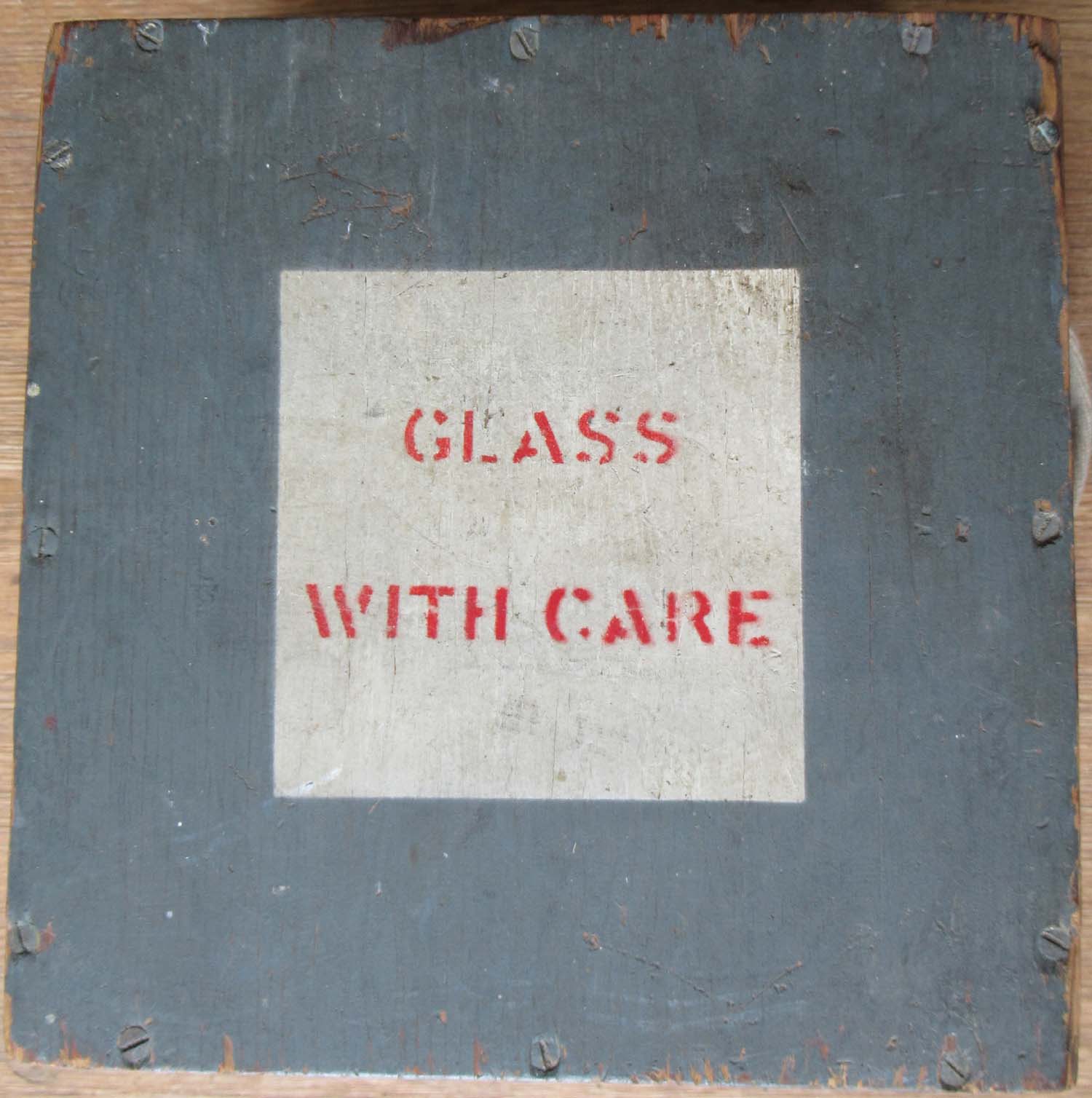 £295


|
|
Click on the pictures to
enlarge them.


 |
Repeater Compass
(Pg 5 Compasses
and Clocks 54A)
Ref:
6A/742 Dated
1944
Seen in situ in
a Lancaster below.

 
Here is a
repeater compass in really nice original condition.
Fitted commonly to
Lancaster's although this was used long before Lancaster's
became operational and fitted to other long range aircraft
including the Sunderland, Halifax and Wellington Bomber..
The
Distant Reading Compass was standard equipment in most
multi-engine aircraft in the RAF throughout World War II
until it was replaced by the Sperry ‘Gyrosyn’ compass.
It
consists of a master unit containing both the gyro and
magnetic elements normally stowed in a part of the aircraft
away from large masses of magnetic material which would
distort the Earth’s magnetic field.
This
master unit feeds, through an electrical transmission
system, repeater compass cards on the pilot’s and
navigator’s panels and wherever heading indications are
required. The complete compass system operates from the
aircraft 24 V DC supply.
The
pilot or navigator has control switches for starting and
stopping the master unit and a variation setting corrector
control to adjust the repeaters to read true instead of
magnetic heading. A complete system comprises a master unit,
variation setting corrector, a control switch box and a
number of repeaters.
The
master unit holds the magnetic element, the gyroscope, the
monitoring and follow-up mechanism and the transmitter for
operating the repeaters. The complete assembly is suspended
in gimbals.
The system uses an electric magnetic inductor element fixed
to the aircraft in azimuth which detects the direction of
the Earth’s magnetic field relative to the aircraft and
transmits this information electrically to the gyro element.
£150


|
|
Click on
the picture's to enlarge them.
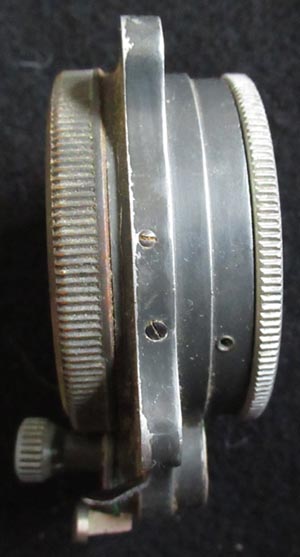
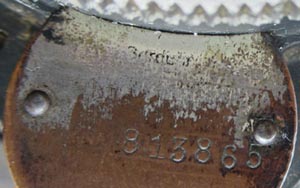
Out of stock more wanted please
contact me |
Luftwaffe Clock
(Pg 5 Compasses and Clocks 28)
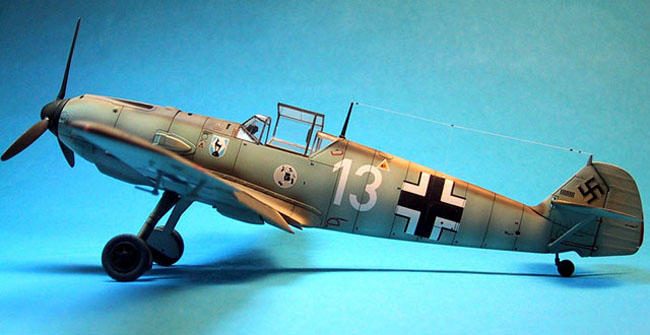
This a superb example of a
wartime Luftwaffe clock in complete and fully working
condition.
I have run it for 24
hours and it keeps perfect time.
Its the best example of
this kind of clock I have seen and extremely rare to find
one in working condition. This was a generic peace and used
in a multitude of German wartime aircraft.
Click on
the picture's to enlarge them.
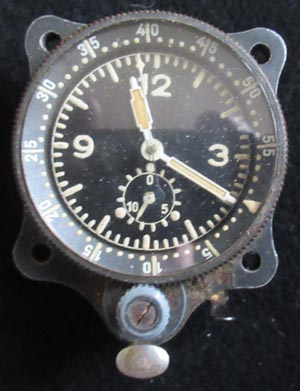 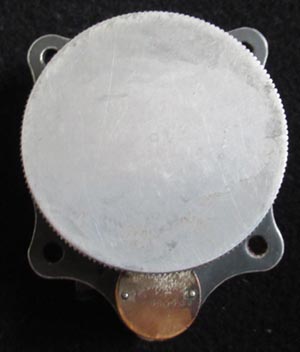 |
|
Click on the
pictures to enlarge them

Omega weems
Kings crown for A/M
Goldsmiths & Siverstmiths
Co LTD
MK VIIA
Acier Staybright
Marking with Omega Symbol
and Omega Text
Swiss made
FAB
Suise
Serial number
4160/40
Dated 1940
A/M 6B/159
Movement Mk VIIA
Movement number
8947319
15 Jewels
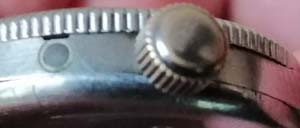
Out of stock more wanted please
contact me
|
Battle of Britain Omega
Weems Watch 6B/159 (Pg 5 Compasses and Clocks 1A)
Worn by RAF Battle of Britain Pilots
and Navigators
This is one of
the rarest piece's on this site and a most desirable time
piece of WWII .
Omega
supplied only 2000 Watches to the RAF during the
entirety of the War.
This one off batch of 2000 being shipped
from Omega to Goldsmiths & Silversmiths Jewelers to the
Queen on the 5th of January 1940 in time for the Battle of
Britain. Once checked they were then issued to the Air
ministry and distributed to the Pilots and navigators of the
RAF Operational Squadrons. Its was originally purchased some
thirty plus years ago from a Scout Jumble sale in Biggin
Hill. Biggin Hill was one of the most famous RAF
Fighter Station's of WWII and Battle of Britain history and
so it can be assumed it belonged to one of the fighter
pilots who operated there. This piece is particularly rare
having a red colored second hand. The Weems Omega was
recently seen being worn in the film about Dunkirk, the
Spitfire Pilot played by "Tom Hardy" used the watch to
calculate His remaining fuel.
Click on the
pictures to enlarge them
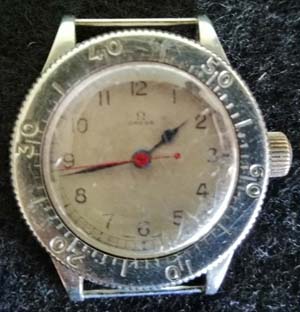 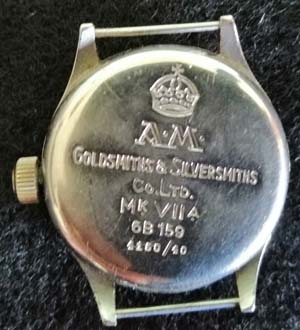 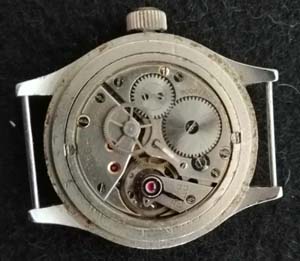 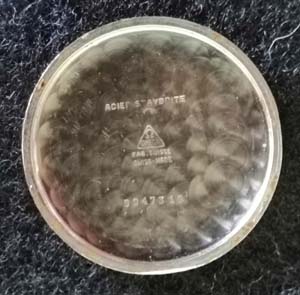
Omegas were not supplied to the Air Ministry
again in this design, similar
watches in the same style were supplied by Longines and
Movado at approximately half the cost of the one with the
Omega movement and although not plentiful are allot more
common than the Omega.
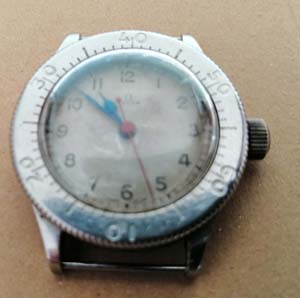 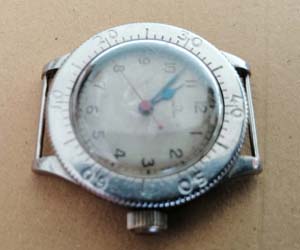 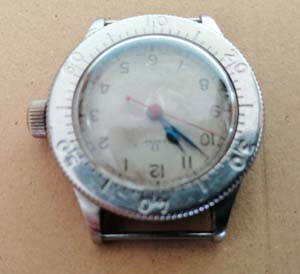 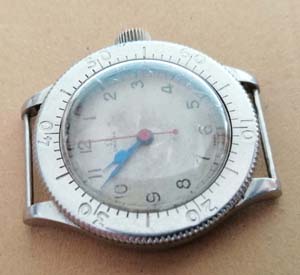
Omega do not have one in their
museum.
This watch has not been restored
and is original in every respect. The locking knob for the
bezel has been
removed at some stage probably because it was not needed
when worn as a normal watch and gets in the way of the
winding and time setting knob. The movement has been
inspected by a watch maker and the movement is in good condition. Its a
great shame that the locking knob has been removed but the
bezel still rotates and the internal shaft appears to still
be in place. I have taken advice from an expert in these
watches who thinks the retail value of a complete piece is around
7 to 9 K GBP
but with so few examples to ga7ge its value is hard to
establish, one thing is for sure it can only appreciate in value
over time. My price should allow for this watch to be
restored to its original specification.
|
|
Click on the
pictures to enlarge them.
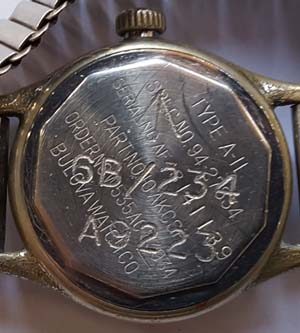
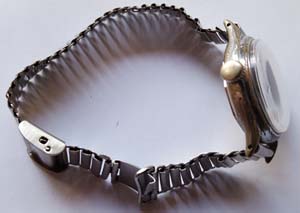
|
Bolova 6B/234
Pilot/Navigators watch (Pg 5 Compasses and Clocks 1)
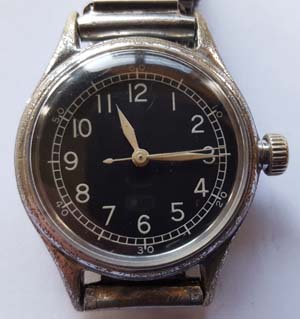
Click on the
pictures to enlarge them.
This is a really
nice example of a Type A II Bulova watch made in the USA and
supplied to the Air Ministry re designa4995as A/M 6B/238.
I have run it for
several days it needs winding every 24 hrs or so and keeps
perfect time. From my research these seem to have been first
issued in about 1942/3.
£ 495


|

Click on the
pictures to enlarge them.
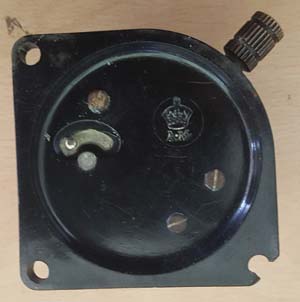
|
Air Ministry rim
wound clock
(Pg 5 Compasses
and Clocks 3B)
This is a classic Battle of Britain 1940 dated rim
wound clock used predominately in
RAF WWII fighter aircraft including the Spitfire.
It will run for a few seconds but sold as display only
6A/579
Dated 1940
Out of Stock
|
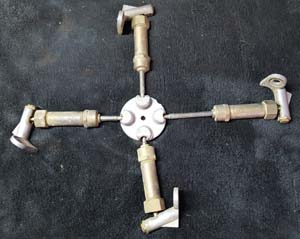
Click on the
pictures to enlarge them.
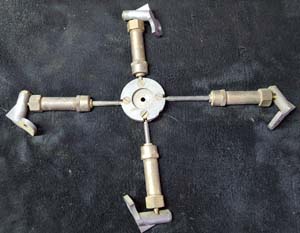
|
Lancaster master compass mounting bracket
(Pg 5 Compasses
and Clocks 3C)
Used in the Lancaster and other heavy RAF
Wartime aircraft this is the bracket for suspending and
mounting the master compass. In good original condition all
parts move freely.
£ 275


|
|
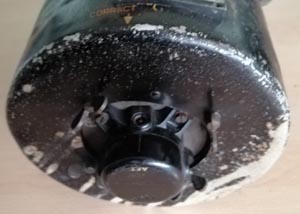
Click on the
pictures to enlarge them.
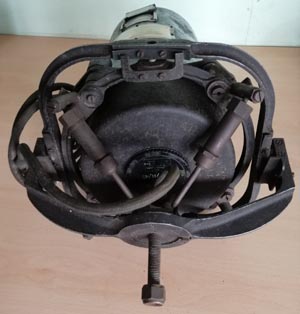
Out of stock more wanted please
contact me
|
Lancaster master compass
(Pg 5 Compasses
and Clocks 3E)
Here is master compass from a Lancaster
probably also used in the Halifax and other large wartime
RAF aircraft.. It has some paint loss but is complete with
its internals and mounting bracket.
Click on the
pictures to enlarge them.
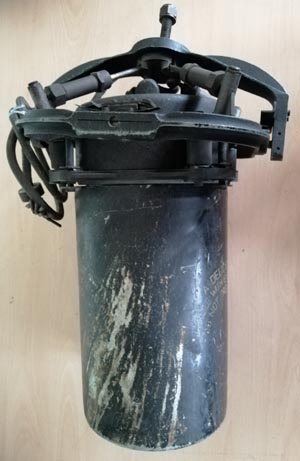 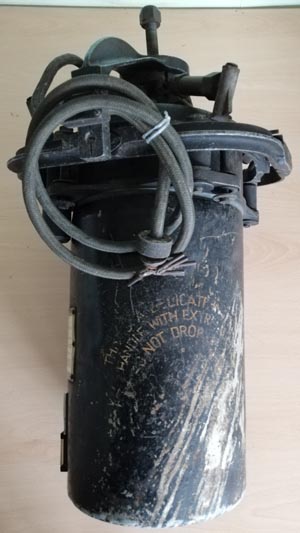 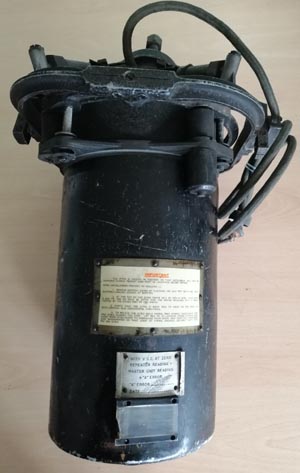 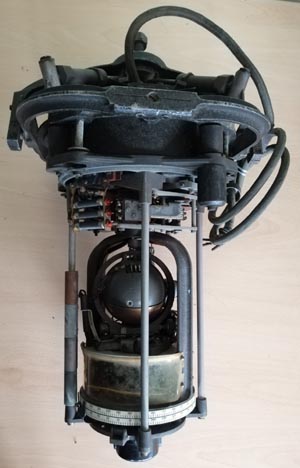
The master compass holds the magnetic
element, the gyroscope, the monitoring and follow-up
mechanism and the transmitter for operating the repeaters.
The complete assembly is suspended in gimbals.
The system uses an electric magnetic inductor
element fixed to the aircraft in azimuth which detects the
direction of the Earth’s magnetic field relative to the
aircraft and transmits this information electrically to the
gyro element.
The D.R. Compass was developed by the
Automatic Telephone and Electric Company and the Royal
Aircraft Establishment from a model originally produced by
the Air Ministry and S.G. Brown Ltd in 1934.
Some 30,000 of these instruments were made at
the A.T.& E. Strowger Works in Liverpool during the WWII
years.
This
piece is big and heavy overseas buyers please
contact me for a shipping
quote.
|
|
Click on the
pictures to enlarge them.
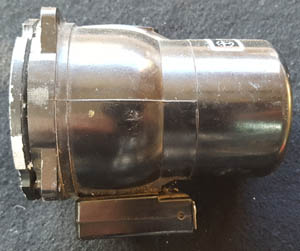
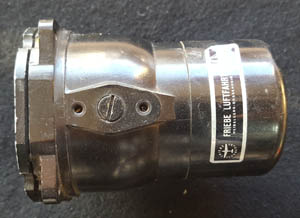
|
BF 109 E & HE 162
Jet
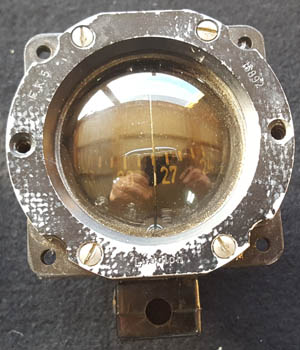
Here is a compass used on early BF
109s and the HE 162 jet. It is in good original condition
the gimble floats freely and it still retains its liquid.
Out of stock more wanted please
contact me |
|
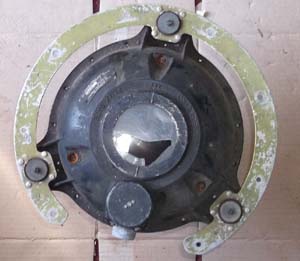
Click on the
pictures to enlarge them.
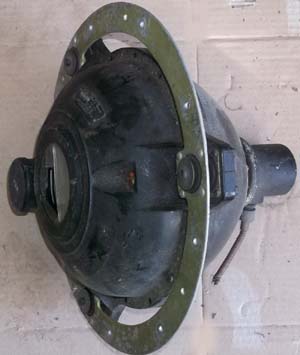
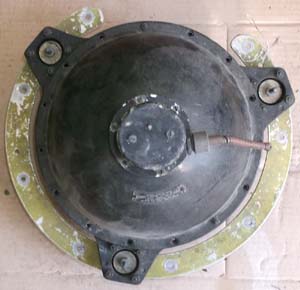
|
B17 Master compass auto pilot (Pg 5 Compasses and Clocks 2)

This is a master compass from a B17 this compass was part of
the autopilot system and was mounted in the wing of the
aircraft. Purchased on our trip to
Arnhem this was probably
from a B17 shot down on its Bombing mission to Germany
although unfortunately the specific history of this
particular piece has been
lost. It is in original condition but the glass is broken
see the pictures.
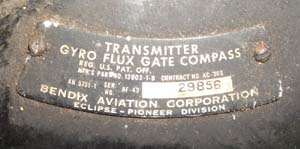
AN5751-1
Click on the
pictures to enlarge them.
Follow this
link to find a servo relating to the B17 auto pilot system.
More information about this compass
and the B17 auto pilot system can be found here.
£225


|
|
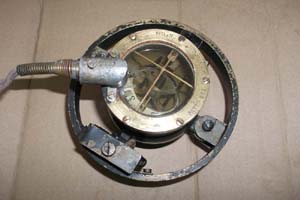
Click on the pictures to
enlarge them
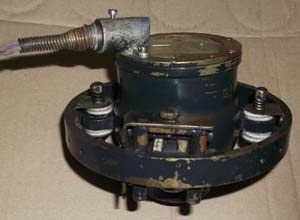
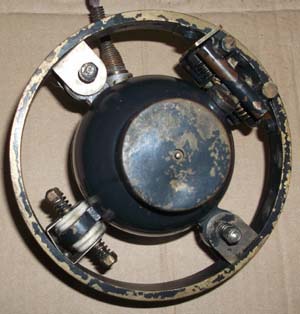
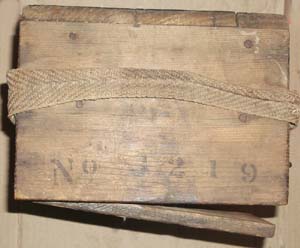
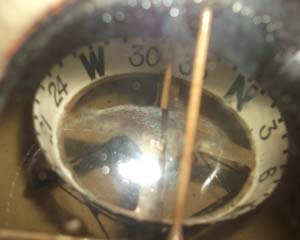
|
Original Boxed WWI RFC
MK II 259 Compass (Pg 5 Compasses
and Clocks 4)
This compass is a superb and
extremely rare piece complete in its original box which
carries the same serial number as the compass. This is the
aircraft version of the Mk II 259 Compass.
Serial number
1219
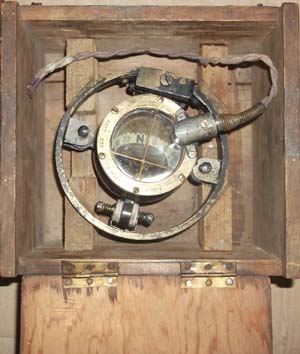
Click on the pictures to
enlarge them
It is in stunning condition
and works perfectly in addition it still has its original
light fitting with original wire attached. It has the
majority of its original paint and fluid everything about
this compass is A1.
The MK II 259 compass
was used in a wide variety of WWI RFC aircraft including the Sopwith Camel shown under

Under seen in
situ in a Camel cockpit
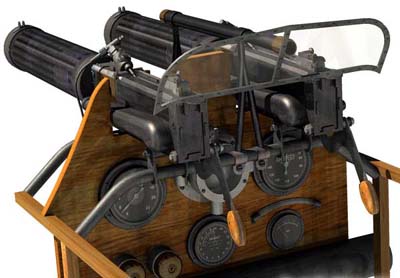
£ 3250


|
|
Click on the
pictures to enlarge them
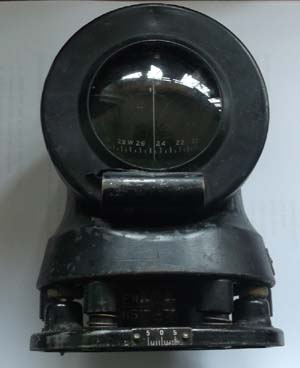
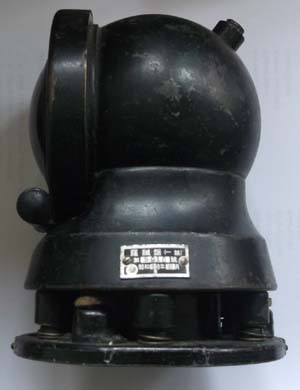
The
translation of the plate is roughly as follows:
"Compass (-best quality?)
Number 9918
Date Aug 1940"
Thank you to William for translating this for me
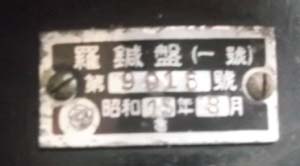
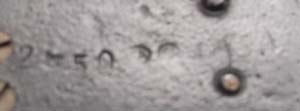
|
1940 dated Japanese
aircraft compass (Pg 5 Compasses and Clocks 5)
Superb example of a Japanese
wartime compass used in a wide variety of the their aircraft
during WWII. Japanese instruments are the most difficult to
find and rarest of all the combatants of WWII. This is the
first Japanese made instrument to appear on this site since
it was created. In excellent condition it still retains its
fluid.
Under are a couple
examples of the aircraft it was fitted to although I
understand it was fitted to at least six or seven aircraft
types.
Compass shown mounted on
top of the panel of a
Mitsubishi Ki-57
Topsy


Seen mounted middle left
in the panel of a Koken Long
Range Mono-Plane
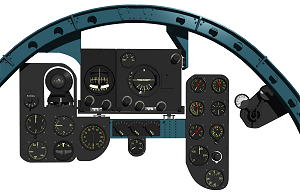
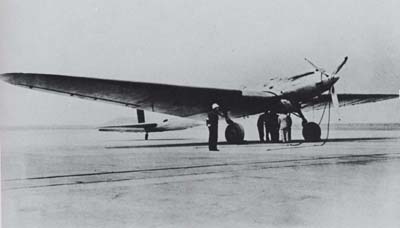
£ 899


|
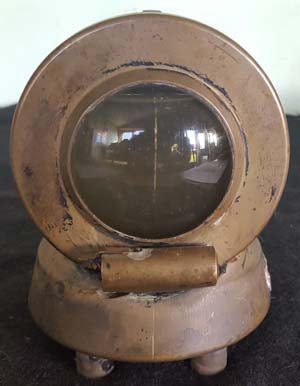
Click on the pictures to
enlarge them
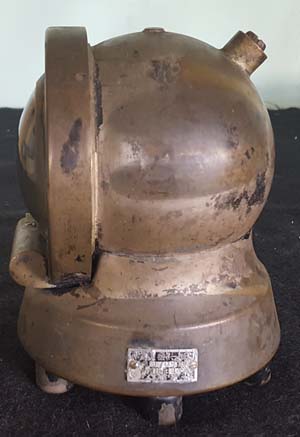 |
Wartime Japanese
compass (Pg 5 Compasses and Clocks 6A)
Here is another
Japanese compass although not in quite good condition.
The ring
inside is there but the fluid has become cloudy and the base
is missing. The paint has rubbed off to expose a solid brass
case.
This
is unusual in that it was found in Holland probably brought
back as a war souvenir from a crashed aircraft which would
explain the condition and the missing base.
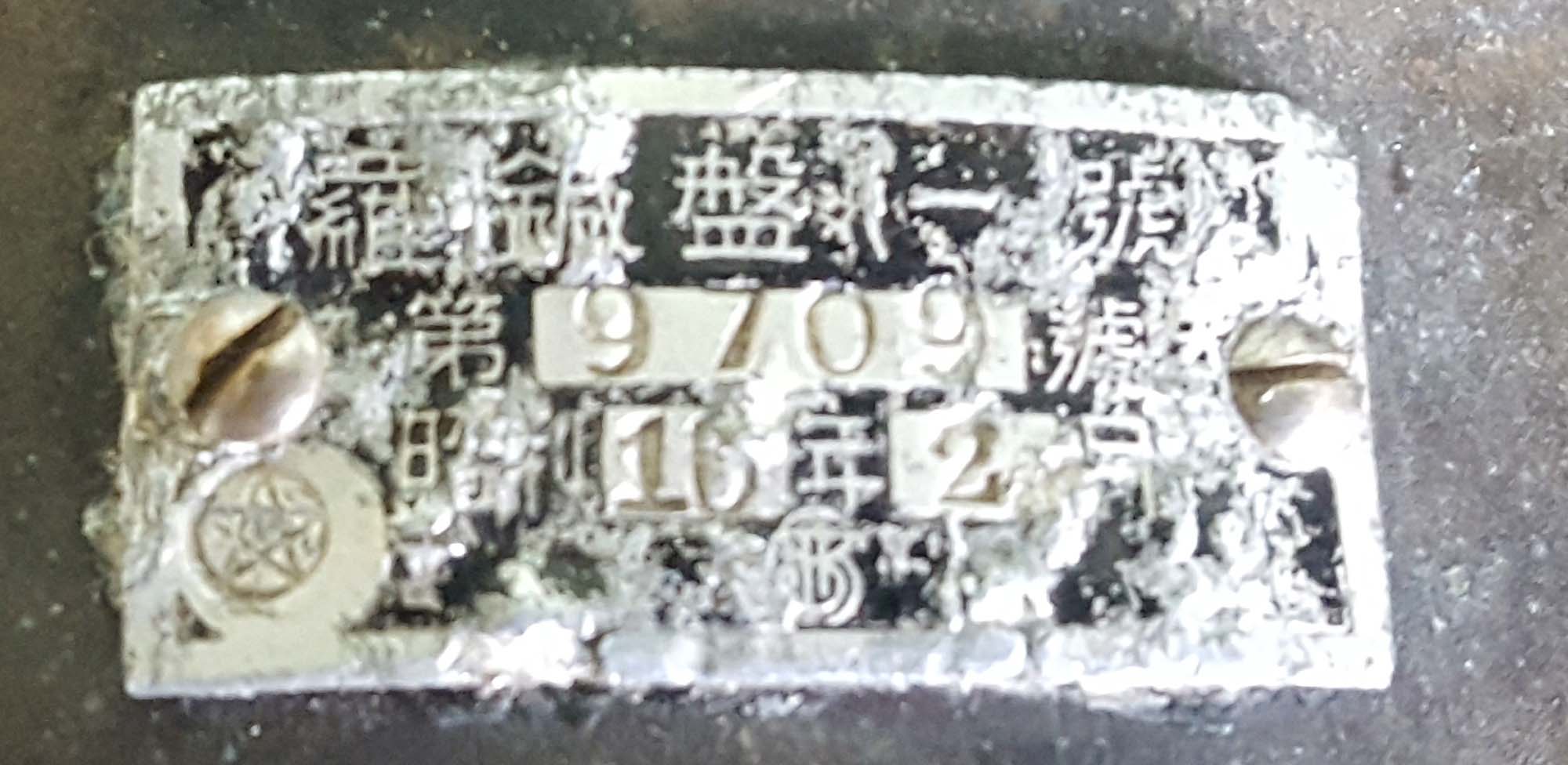
Its the
same design as the one shown above
£495


|
|
Click on
the pictures to enlarge them
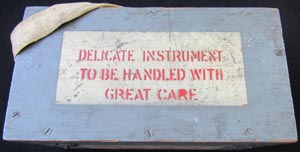
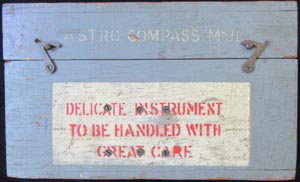
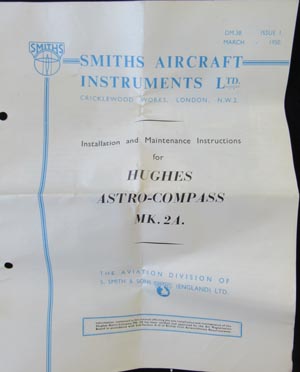
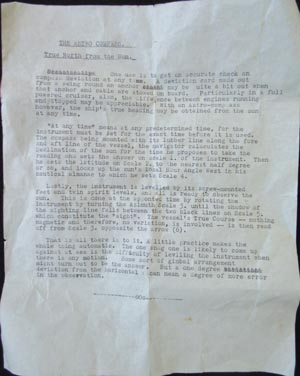 |
Astro Compass MK
II (Pg 5 Compasses and Clocks 6B)
Here we have an Astro compass
MK II complete in its original box with some paperwork it is
in good complete condition please enlarge the pictures.
Astro
Compasses were used during the Second World War by pilots
and navigators to calculate true North and heading by the
sun or stars.
Astro compasses of this
type were used onboard larger Allied aircraft such as
the Avro Lancaster.
The navigator used this
instrument by sighting through the Astrodome fitted to the
larger aircraft specifically for this purpose.
Click on
the pictures to enlarge them
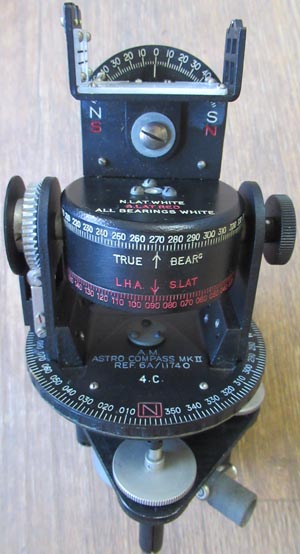 .jpg) 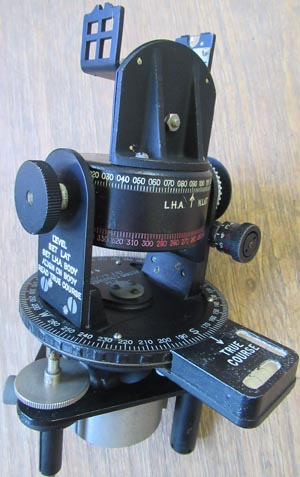
Shown
above the astrodome on a Lancaster this was above the
navigators position and covered by a screen to prevent light
from the Bomber escaping when not in use.
Click on
the pictures to enlarge them
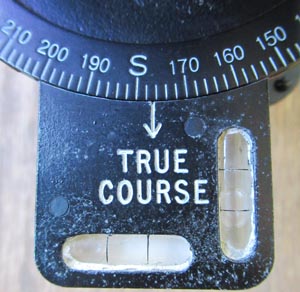 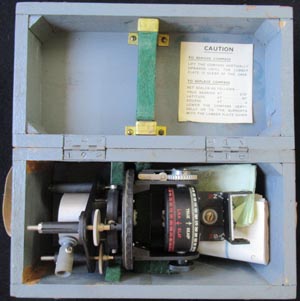 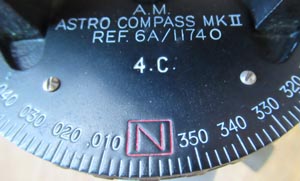 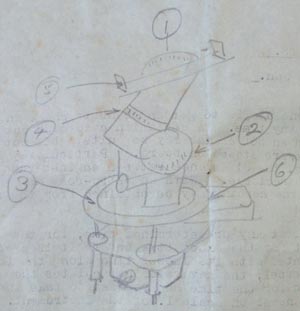 £275


|
|

Click on
the pictures to enlarge them
 |
Type 0.6 Compass
(Pg 5 Compasses and Clocks 7) This is a
hand held compass used for taking a bearing in wartime
aircraft when the fixed type compass was faulty or difficult
to read. They are illuminated and batteries are located in
the stalk. This compass is solid brass and in good used
condition.. I have not tested it so sold as a collectable.
£125


|
|
Click on
the pictures to enlarge them
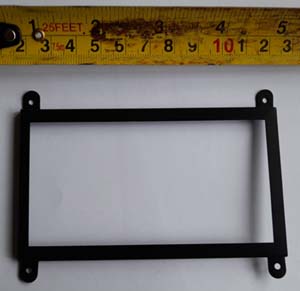 |
Large Compass
card holder (Pg 5 Compasses and Clocks 11)
New old stock original large
card holders, I have not seen these before and assume they
are used for the larger compass correction cards.
4
available
£85 each


|
|
Click on
pictures to enlarge
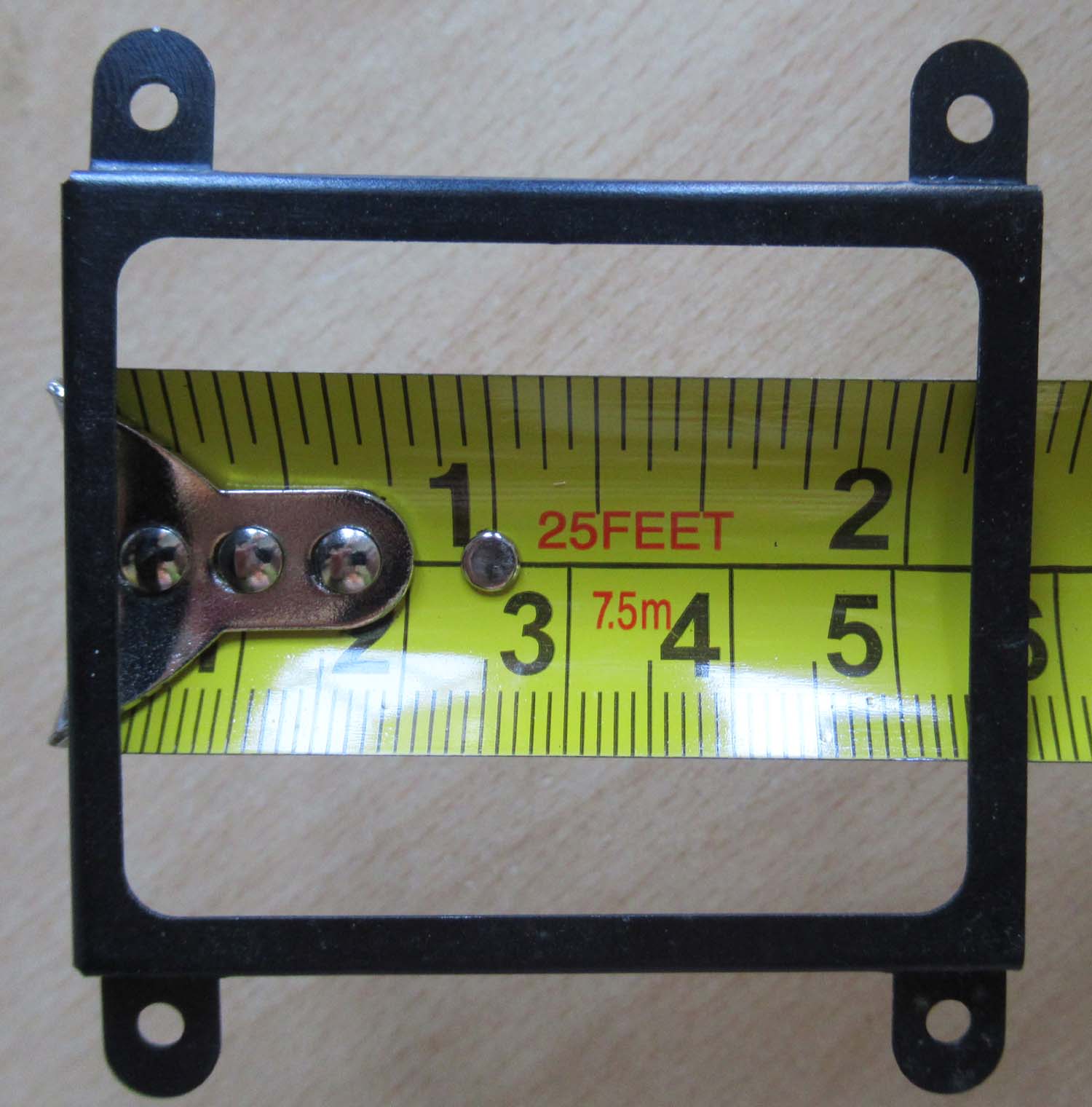 |
Original Compass
Card Holder (Pg 5 Compasses and Clocks 9)
COMPASS CARD
holder for the Spitfire Main panel. This is the bit that's
everybody's missing. These are totally original new old
stock fitted to nearly every type of wartime RAF aircraft.
6
available
£65 each


|
|
Click on
the pictures to enlarge them
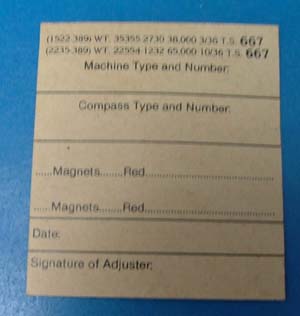 |
Re printed compass cards available £5 each free post
(Pg 5 Compasses
and Clocks 10)
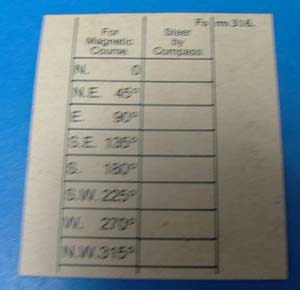
£5


|
|
Click on
the pictures to enlarge them
£25 each 8
available


|
Compass
correction cards named aircraft (Pg 5 Compasses and Clocks 11C)
Used compass correction cards
with named aircraft. these cards are larger than the ones I
have seen before measuring 105mm square. Each one comes from
a named aircraft with its serial number. please click on the
pictures to enlarge them. They are dated from 1950 to 1960.
Once you have ordered
please email
using this link stating
which card or cards you want using the aircraft serial
number and type.
Click on
the pictures to enlarge them
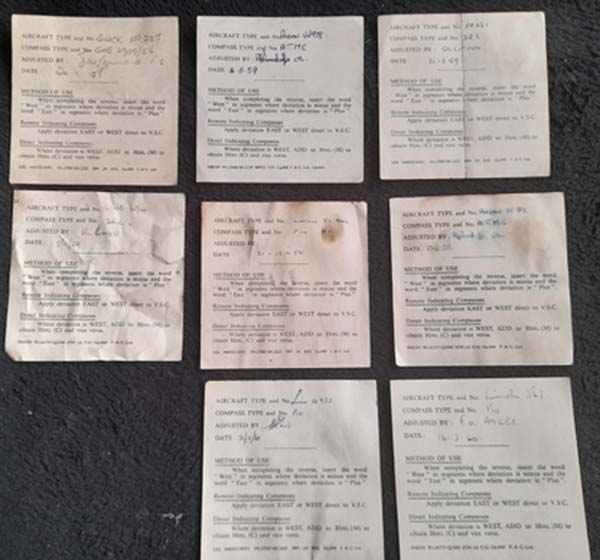 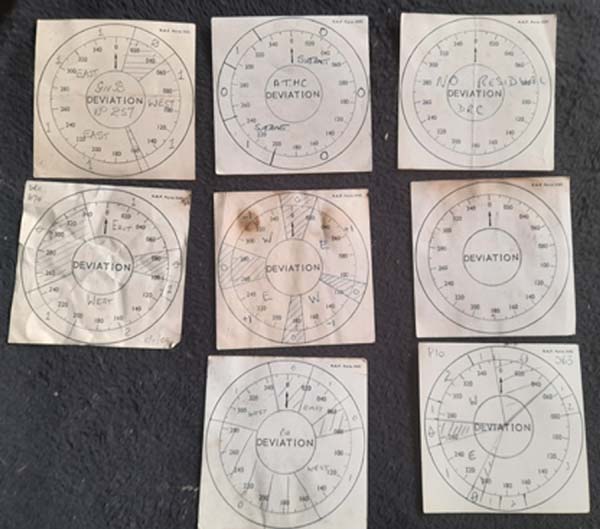
|
|
Click on
the pictures to enlarge them
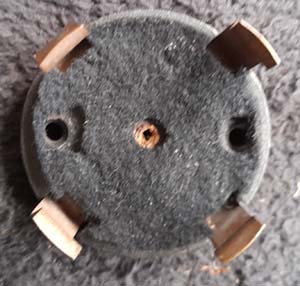
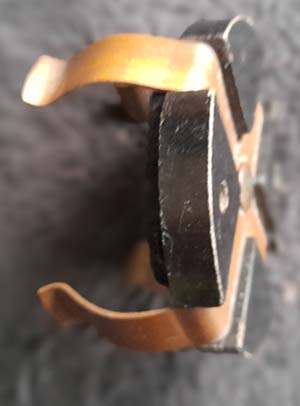 |
Stop Watch
mounting bracket (Pg 5 Compasses and Clocks 11B)
Here is a nice original watch
holder as fitted to the main instrument panel of Lancasters
and other RAF Wartime aircraft in good original condition.
Out
of stock more required please
contact me
|
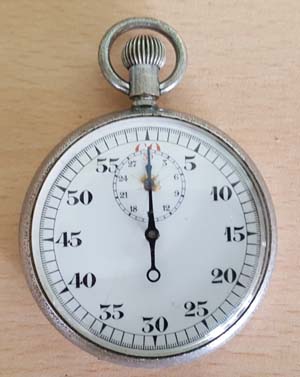
Click on the
pictures to enlarge.
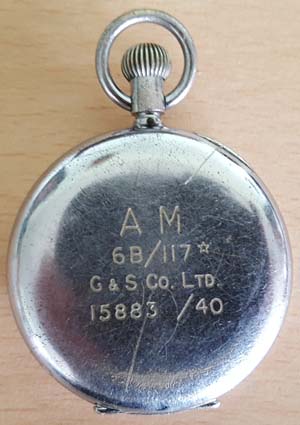 |
Battle of
Britain Bomb Aimers stop watch (Pg 5 Compasses and Clocks 11A)
This is a stunning bomb
aimers stop watch used for timing the bomb run. It works
perfectly , it is dated 1940 so so probably used in the
early raids using Wellingtons and Hamptons.
6B/117
Out
of stock more required please
contact me |

Click on
the pictures to enlarge them

|
P11 Compass (Pg 5 Compasses and Clocks 12A)
Here is a P11 compass in
really nice condition , its mounted in a beautifully made
and lined wooden box on a gimble the exterior case has been
removed. Probably used in someone's boat.
Type P.11
£175


|
|
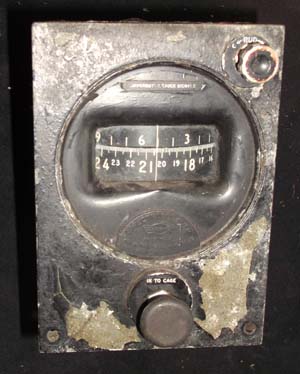
A band of American flyers
under the command of Lieutenant Colonel James Doolittle
dared the impossible by flying their B-25 medium bombers
from the deck of the USS Hornet to avenge the attack on
Pearl Harbour by bombing selected cities on the Japanese
home islands.
Click on
the pictures to enlarge them
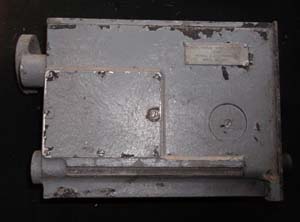 |
A-3/Navy Mark 3
Giro Control (Pg 5 Compasses and Clocks 13)
Found in most C-47, C-46,
B-25 and PV-2s, used in conjunction with the model A3
autopilot.
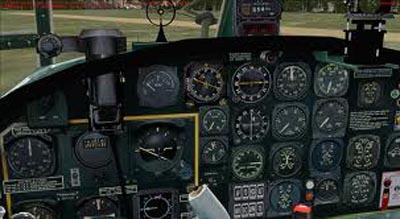
Seen in situ
above in a B25.
£95


|
|
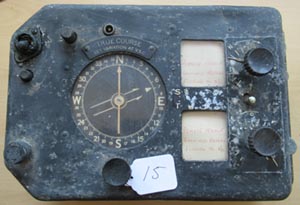
Out of Stock More
Wanted
Contact Us |
Air position
indicator (Pg 5 Compasses and Clocks 15)
API is an air position indicator. You set
the North and East as the aircraft’s initial position or
from a fix point. The True Course is the aircrafts magnetic
heading offset using the VSC – variation setting control –
to get a True Heading or True Course. A feed is the
aircraft’s airspeed corrected for temperature and height.
This then gives a position of where the aircraft would be
assuming no wind. As there is usually wind the position is
its air position. Comparing the given air position with an
updated fix we can calculate the wind over the previous
period.
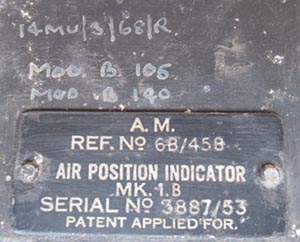
|
|
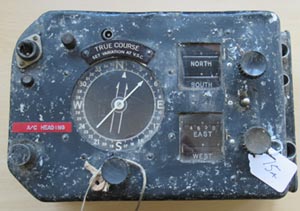
£225


|
Air position
indicator (Pg 5 Compasses and Clocks 15A)
API is an air position indicator. You set
the North and East as the aircraft’s initial position or
from a fix point. The True Course is the aircrafts magnetic
heading offset using the VSC – variation setting control –
to get a True Heading or True Course. A feed is the
aircraft’s airspeed corrected for temperature and height.
This then gives a position of where the aircraft would be
assuming no wind. As there is usually wind the position is
its air position. Comparing the given air position with an
updated fix we can calculate the wind over the previous
period.
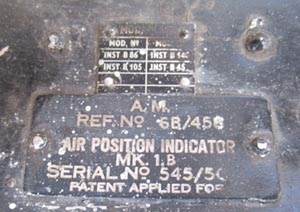
|
|
Click on the
picture's to enlarge.
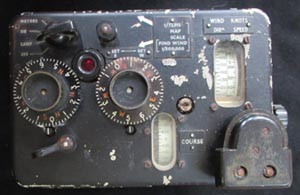
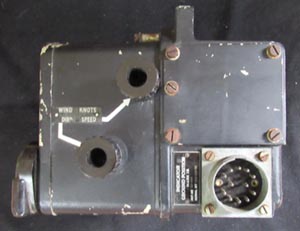
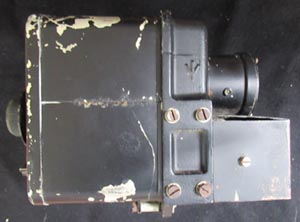
Out
of stock more required please
contact me |
RAF Ground position indicator MK I (pg
5 Clocks and compasses 15B )
This is a ground position
indicator MK I in nice original condition as fitted to
many of the RAF's heavy Bombers including the Lancaster.
Click on the
picture's to enlarge.
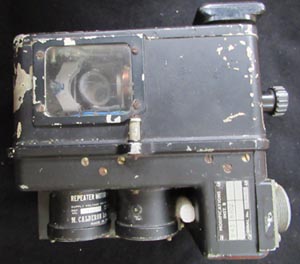 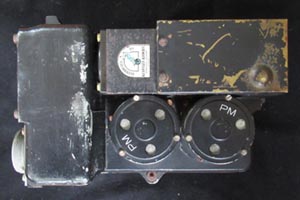 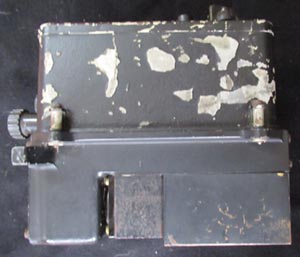 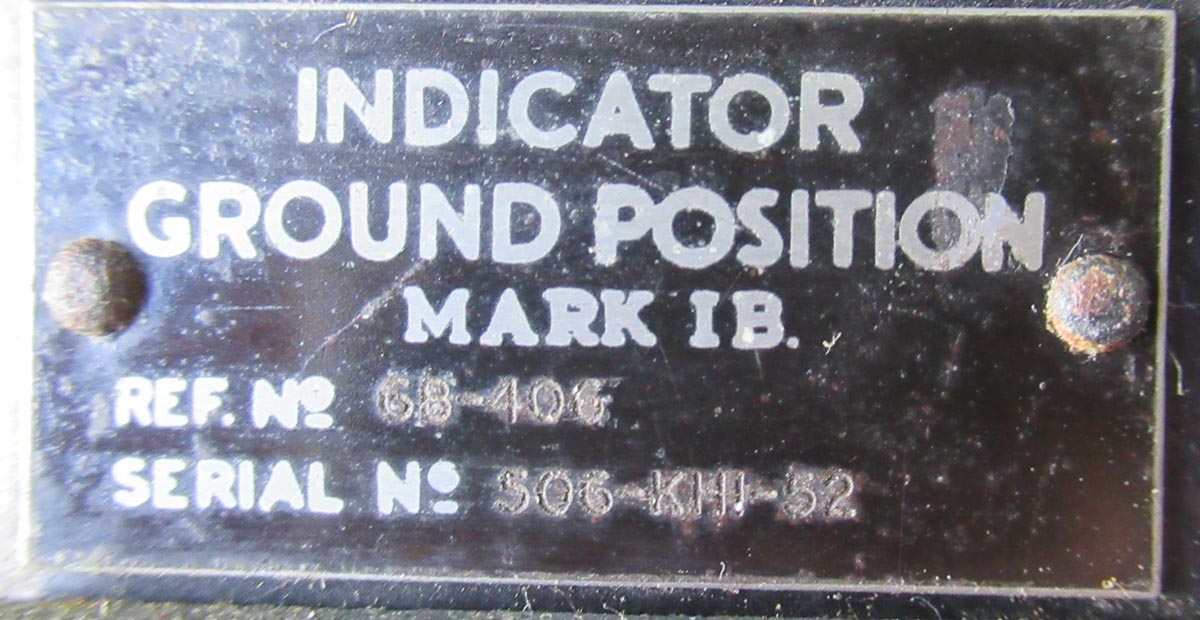
This does what it
says on the box
it is an instrument that determines and
displays automatically the DR (dead reckoning) position of
an aircraft. It gets its data from an ASI (air speed
indicator) and a compass.
Seen
below fitted in a Lancaster.

|

Click on
the pictures to enlarge them

Click on
the pictures to enlarge them
 |
News Chronicle Enterprise
Dinghy Cross channel race Calais to Dover
P8 Compass (Pg 5 Compasses
and Clocks 16)
This is an interesting
piece a P8 Compass most commonly fitted to Spitfires this
one was presented as 1st Price to the winning boat of the
News Chronicle Cross channel race Calais to Dover June 30th
1956. I found the following information however there is a
discrepancy in the date which the article possibly got wrong
as January does not seem a suitable time to hold a cross
channel race in a small Dingy.
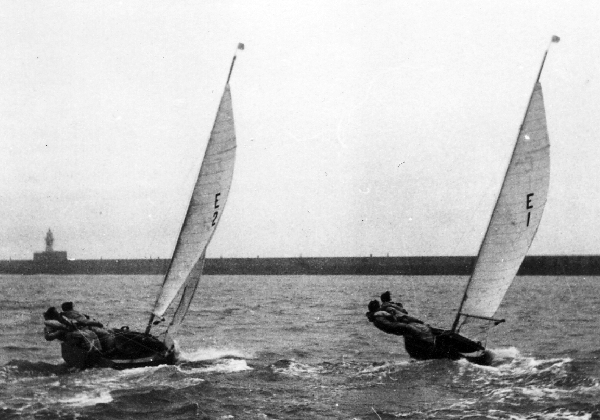
The beach at Dover during the small hours
of a January morning with a full Force Four blowing is
hardly conducive to the idea of dinghy sailing, but at
3.28am on 9 January, 1956 two Enterprise dinghies left Dover
to make a cold night crossing of the English Channel to
Calais, in one of sailing’s great, largely forgotten,
small-boat voyages. The boats, known simply as Enterprise 1
and Enterprise 2, were crewed by Bruce Banks with wife
Rosemary, and Bobbie Prenger and Flavia Nunes.
The publicity stunt made quite an impact
not just because of the feat of sailing a small Dinghy
across the Channel, but because the Enterprise class had
been commissioned as an affordable “Everyman” dinghy from
designer Jack Holt just a year before by
The News Chronicle,
who covered the Channel escapade in full.
On 9 January, the crews pushed off from
Dover beach and planed most of the way to Calais in the
lively conditions, experiencing thick fog at the French end.
They had to delay their entry into Calais for this photo to
be taken by an aeroplane chartered by The Chronicle, a photo
that would appear on the news that night and in papers all
over Britain the next day. They eventually arrived at
10.10am.
This was the era when newspapers would
get behind sailing in a big way: in 1962, Holt would
collaborate with the Mirror to design one of the most
successful dinghies of all time, the eponymous Mirror, and
later that decade, the Sunday Times sponsored the first
round-the-world-solo-nonstop yacht race (the Golden Globe).
The Enterprise continues to enjoy successful racing to the
same design to this day – more than 23,000 have been built.
They celebrate 60 years as strong as ever.
£225


|
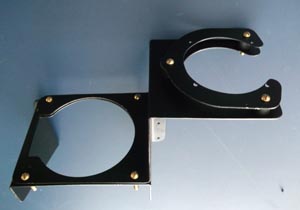 |
Lancaster instrument panel
bracket
(Pg 5 Compasses
and Clocks 17)
Seen left
new made exact replicas of the bracket which held the DR
Compass and LR homing indicator see this on the
Panel
page link
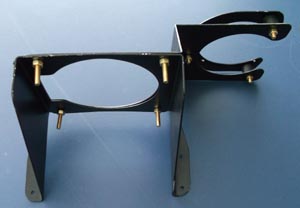
|
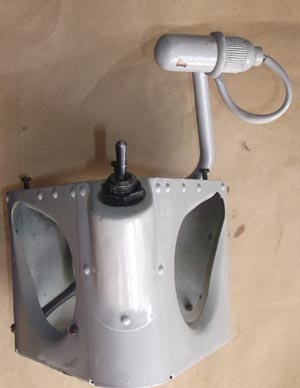
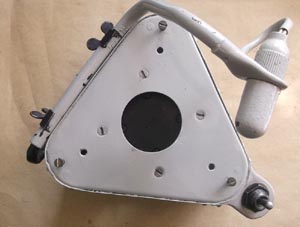 |
Chipmunk Compass mount
(Pg 5 Compasses
and Clocks 18)
This is a
nice complete compass mount from a chipmunk, has the compass
corrector attached and a light all ion very good condition.
This compass mount will fit a P8 or P11compass.
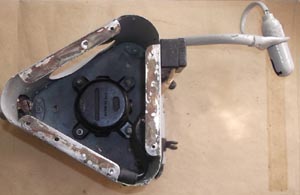
The Chippy was the RAF's
standard trainer from the mid 50s. It remained in service
with the Army Air Corps until 1997. Nearly 500 are still
flying. The first aircraft were designed by De Havilland of
Canada (and was the first indigenous design of that company
since its formation in 1928), intending to replace the Tiger
Moth biplane trainer. It first flew on 22. May 1946 from De
Haviland's factory at Downsview, Toronto. It was designed by
Wsiewolod J. Jakimuik, formerly chief designer with PZL of
Poland. It was ordered by the Canadian Air Force, who used
it as an trainer, prior to students graduating to the
Harvard. Canadian Chipmunks were exported to Egypt, Lebanon
and Thailand.
£275


|
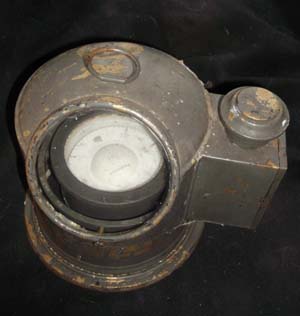
Click on the pictures to
enlarge them
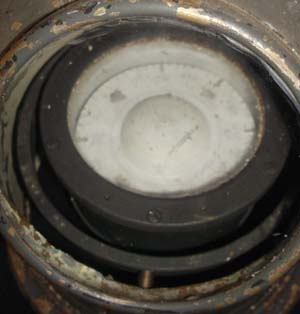
Click on the pictures to
enlarge them
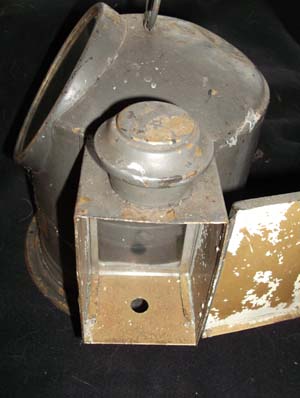 |
RAF ASR/MTB Compass and
binnacle
(Pg 5 Compasses
and Clocks 19)
This is a nice original
compass and binnacle fitted to the air sea rescue launches
used to save downed airmen in the channel and Motor torpedo
boast of the Royal navy. It has its original paint but is
completely made of brass and could be stripped and polished.
ASR launch
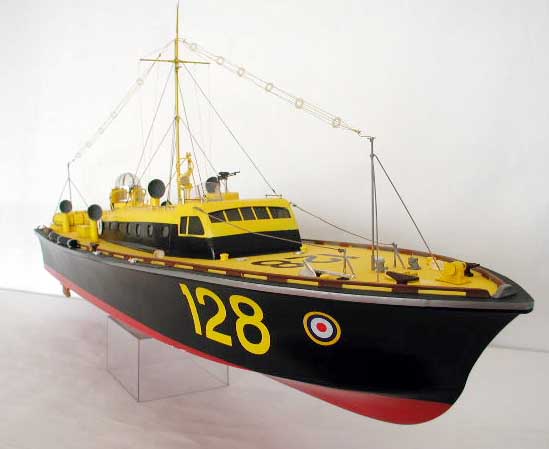
During the Second World War,
flotillas of the Royal Navy's Motor Torpedo Boats and other
coastal forces fought a deadly war for control of the
English Channel and the North Sea. These small, fast boats
attacked enemy convoys, escorted freighters, landed secret
agents and even raided enemy ports. Unsung heroes, these
craft and their tiny crews helped stave off defeat in the
dark days of 1940. The same vessels then took the fight to
other waters, and by the end of the war, British MTB's had
seen service in the Mediterranean, the Baltic and the Far
East.
MTB
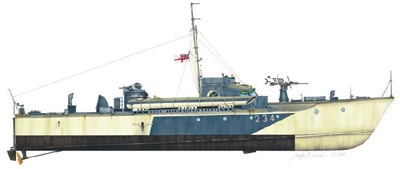
£399


|
|
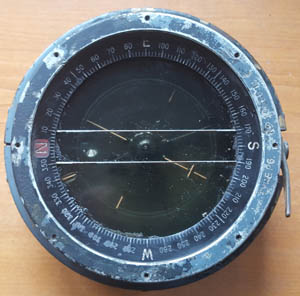
Click on the pictures to
enlarge them
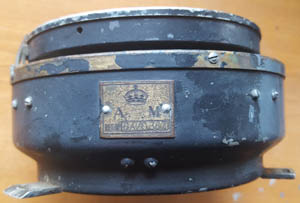 |
P6 Compass
(Pg 5 Compasses
and Clocks 20)
This compass is in heavily
used condition please enlarge the pictures, but does still
contain some of its original fluid and is functioning.
£125


|
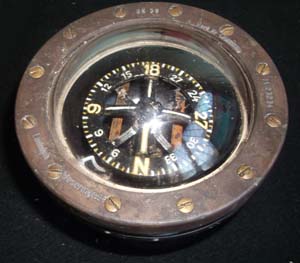
The Junkers JU 87 was one of
the most versatile and effective combat aircraft of World
War II.
The German aircraft was slow, but
nevertheless very effective.
14676 were built, including a
staggering 104 prototypes for its 60 different versions.
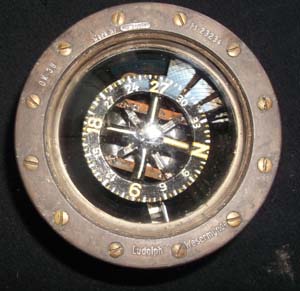
|
BF 110/ JU87 Compass (Pg
5 Compasses and Clocks 21)
This is a WW2 OK 38 German
bomber compass as used on ME110, JU87 ect.
Type FL23234
Werk Nr: Q-20091
Bakelite body made by Ludolph,
Alloy front face good
condition working order fluid has been drained.
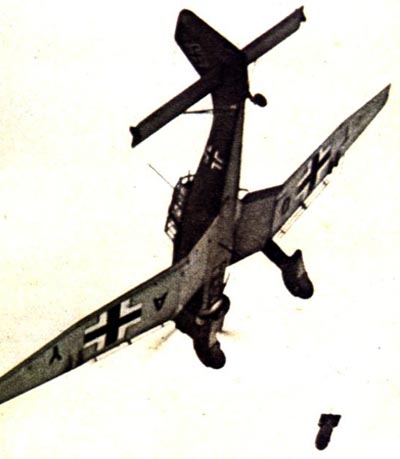
£295


|
|
This
compass was purchased on our trip to
Arnhem.
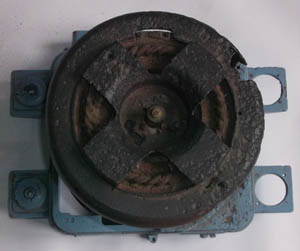
Click on
the picture's to enlarge them.
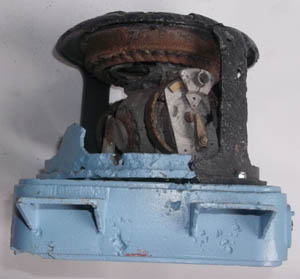
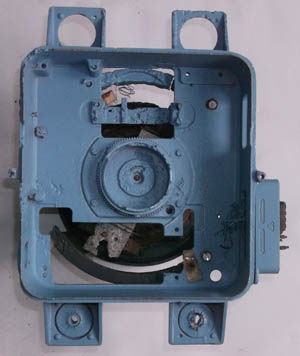 |
Luftwaffe
PKZ 14
auto pilot giro (Pg 5 Compasses
and Clocks 26)
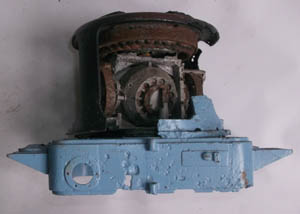
Click on
the picture's to enlarge them.
This is
the internal remains of a PKZ giro compass used as part of
the auto pilot system. The PKZ became available
in 1942 and was produced in large numbers. It was used in a
variety of German aircraft including the AR 234, Do 335, He
218, JU 288 and JU 388.
You can read more about this
unit
here link
Identification kindly supplied by
Remco Caspers.
Ref:
FL32113-6
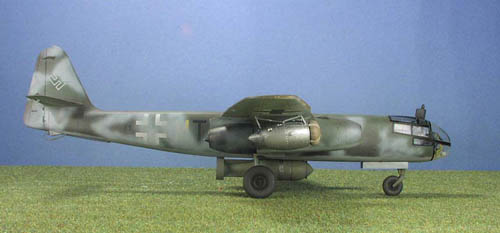
Shown
above the AR 234
The Arado Ar 234 B Blitz (Lightning) was the
world's first operational jet bomber and reconnaissance
aircraft. The first Ar 234 combat mission, a reconnaissance
flight over the Allied beachhead in Normandy, took place
August 2, 1944. With a maximum speed of 735 kilometers (459
miles) per hour, the Blitz easily eluded Allied
piston-engine fighters. While less famous than the
Messerschmitt Me 262 jet fighters, the Ar 234s that reached
Luftwaffe units provided excellent service, especially as
reconnaissance aircraft
Click on
the picture's to enlarge them.
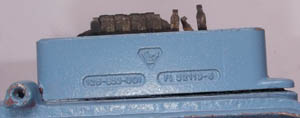
£199


|
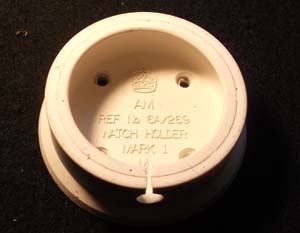
Click on the
picture to enlarge |
Watch Holder Mk
I White (Pg 5 Compasses and Clocks 30) Old
new stock mint condition rubber Mk I watch holder. My
understanding is the white ones were used mainly pre War and
the Black were wartime although they probably used what was
available at the time .
Used in a variety of RAF
wartime aircraft including the Lancaster.
White
Air
Ministry Marked
Ref: 6A/269
£125


|
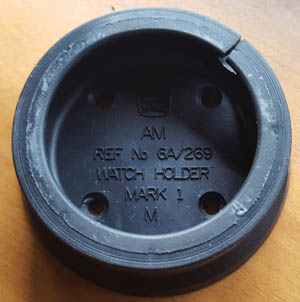
Click on the
picture to enlarge |
Watch Holder Mk
I Black (Pg 5 Compasses and Clocks 30A) Old
new stock mint condition rubber Mk I watch holder. My
understanding is the white ones were used mainly pre War and
the Black were wartime although they probably used what was
available at the time .
Black
Air
Ministry Marked
Ref: 6A/269
Out of
stock
|
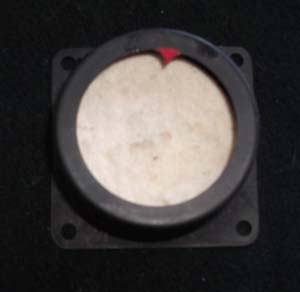
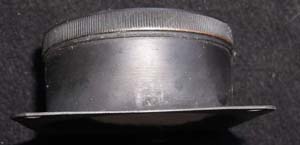 |
Metal MK II
Watch Holder (Pg 5 Compasses and Clocks 31)
These are exact copies of the
metal watch holders used in 1930s RAF aircraft complete with
soft backing material.
£125


|
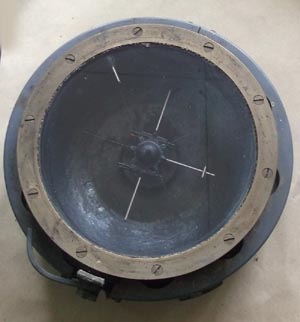
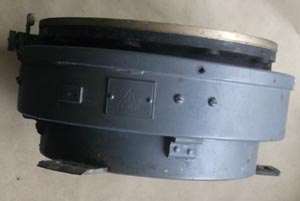 |
P10 Compass (Pg 5 Compasses and Clocks 39)
The top is missing from this compass and there is
no fluid
Used in the
Lancaster and Halifax Heavy Bombers.
Ref: 6A/1671
Click on the pictures to
enlarge them.
£110


|
 Click on the pictures to
enlarge them.

£275


|
Battle of the Atlantic P6 Compass (Pg 5 Clocks and compasses 44)
Battle of the Atlantic P6
Swordfish compass, this compass has been heavily used is dry and has no fluid.
Its quite incredible to think what this piece of equipment
has witnessed the Battle of the Atlantic being for all
involved one of the toughest of the war.
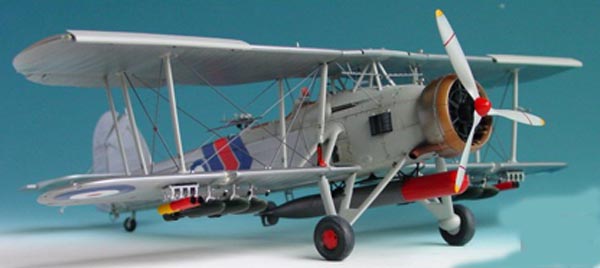
This compass belonged to Alex
C Martin who married Althea Hart in Honiton in 1945 , he
lived in Pinetrees. Jubilee road. Totness until his death in
1993.
The information I have is that he was a Pilot with the
New Zealand airforce and was sent to Canada under the
Empire training scheme it is unclear whether he was a trainee
or training other pilots at this time.
His combat
career involved flying Grumman Hellcats and the Swordfish
from aircraft carriers during the Battle of the Atlantic.
This would of coarse make him a FAA Pilot and this compass
belonged to one of the aircraft he flew in the Battle of the
Atlantic. I have a written account of one of his experiences
protecting Atlantic Convoys .
|
|
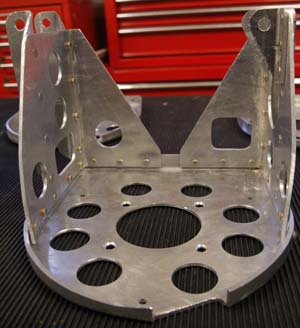
Click on the pictures to
enlarge them.
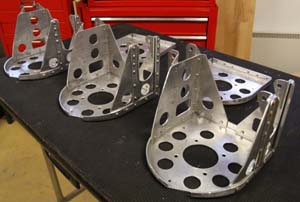 |
Spitfire compass tray
(Pg 5 Compasses
and Clocks 45)
Now available exact
replicas of the Spitfire compass tray, this is a very
difficult piece to replicate these are perfect copies made
using original drawings they will be supplied painted in a
black finish.
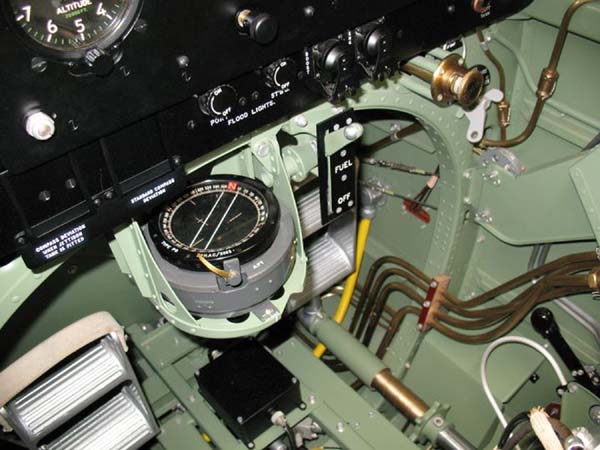
Click on the pictures to enlarge them
£450


|
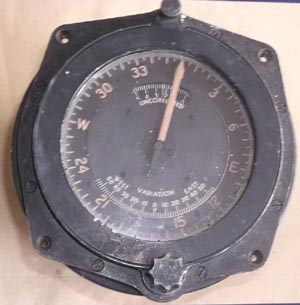 Click on the pictures to
enlarge them.
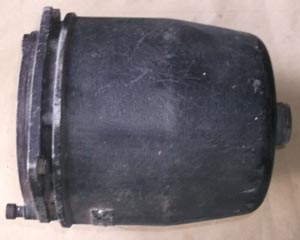 |
B17 Bendix master indicator
giro flux Compass
(Pg 5 Compasses
and Clocks 47)
Used in the
B17 and other American WWII bombers
The
Gyro Flux Gate Compass, was a revolutionary type which
enables Allied airmen to fly straight to their target under
virtually any conditions, return just as unerringly to their
bases after showering destruction on enemy objectives.
The flux gate, or magnetic azimuth
sensitive element of the system (magnetic azimuth is direction with relation to
magnetic north) is fully electrical and is maintained at the horizontal by an
electrically driven horizon gyro. Because of this arrangement, the compass
system's indications are not appreciably affected by the sudden manoeuvres in
flight. A stable compass proves its worth to airmen who dive, turn their planes
at 300-400 mph.
The device will not go off its reading when the plane
dives or climbs suddenly, and as Reichel describes it, "will not lag or
overshoot during a turn and will not oscillate or 'hunt' back and forth in rough
weather."
One of the compass problems arising from use of aircraft
equipped with armament, armour plate and laden with bombs has been solved with
the remote indicating phase of the system. The magnetic azimuth sensitive
element, or transmitter, is placed where interference will be at a minimum —
that is, at a point remote from current carrying conductors or causes of local
magnetic deviations such as armament, which would impair the accuracy of the
standard compass.
Through this arrangement, the indications of the
transmitter in its out-of-the-way place are registered on the master indicator.
Further, other indicators are linked to the compass through the Magnesyn system,
which makes possible remote readings of measurements received from a master
source. Pilot, co-pilot navigator and bombardier have their own dials, and
compass readings are transmitted to them or to as many as six different points
about the aircraft.
£175


|
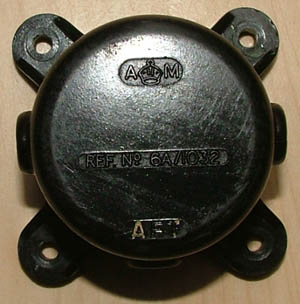 |
Compass corrector
(Pg 5 Compasses
and Clocks 48)
Compass corrector,
bolted to the underside of the compass tray in practically all
RAF Wartime aircraft.
AM Ref: 6A/1032
£35
Currently out of Stock
|
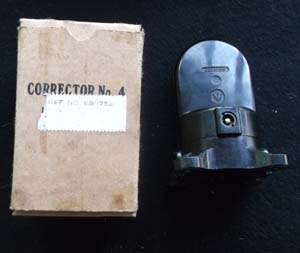 Click on the pictures to
enlarge them. |
Compass corrector
(Pg 5 Compasses
and Clocks 49)
Compass corrector,
bolted to the underside of the compass tray in practically all
RAF Wartime aircraft.
Ref:6A/1752
£35


|
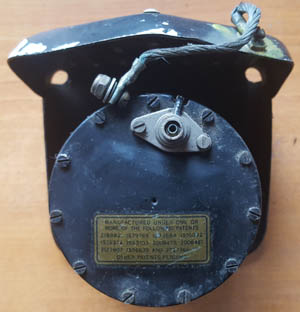 Click on the pictures to
enlarge them.
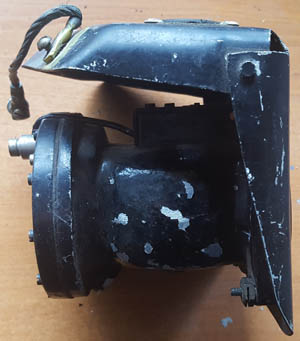 |
USAAF Airpath
Compass with mounting bracket. (Pg 5 Compasses and
Clocks 51A)
Here we have a Airpath
Compass as Used by the USAAF
The Compass Inside the
Case is working although it is quite faded there is
still fluid present. It comes with its original mounting
bracket.
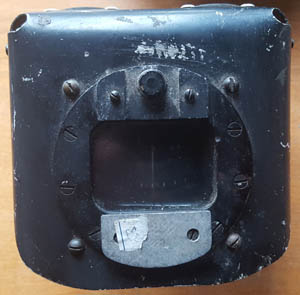
Click on the pictures to
enlarge them.
£85


|
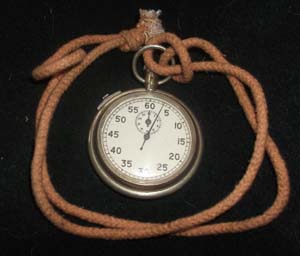 Click on the pictures to
enlarge them.
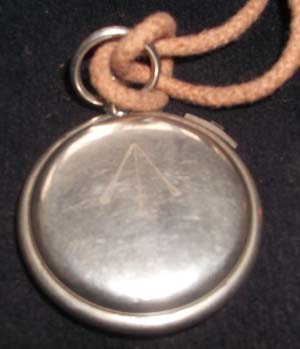 |
WW2 Military
Stop Watch (Pg 5 Compasses and
Clocks 52)
Here we have a WW2
Stopwatch with a War Department Crows Foot and S.4494
Stamped on the Back
It has a Cuprel,
Dennison Watch Case Company, Made in England Stamped on
the Inside of the Case
The Movement is Clean
and is in Working Condition
It has a Switch on the
Side with Sections Marked Stop and Go

Out of stock more wanted please
contact me |
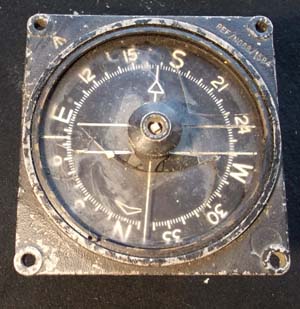 Click on the pictures to
enlarge them.
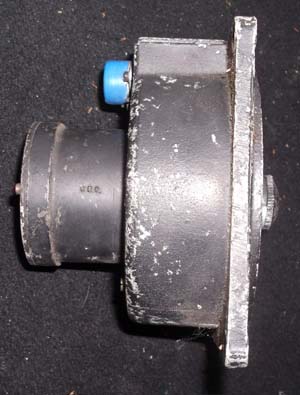
|
Repeater Compass
(Pg 5 Compasses
and Clocks 54)
. Fitted commonly to
Lancaster's although this was used long before Lancaster's
became operational. Could
have been fitted to a Hampton or Wellington or other early
RAF aircraft.
Glass is broken
Ref:
6B/1584
Has a
service date of
1951 however it was obsolete long before then.
£75


|
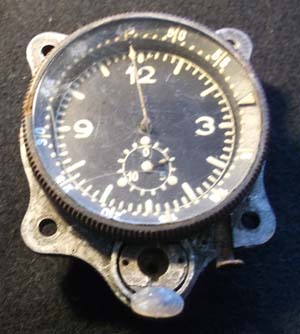
Luftwaffe Clock
2 (Pg 5 Compasses and Clocks 56)
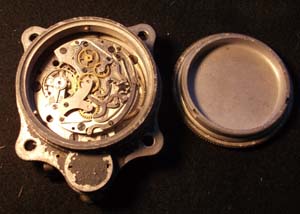
|
Luftwaffe Clock
2 (Pg 5 Compasses and Clocks 56)
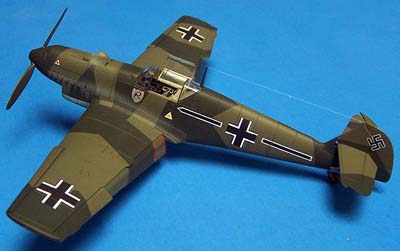
This clock looks almost
complete although not working
One of the Hands is Missing and it has no Dust Cover £289


|
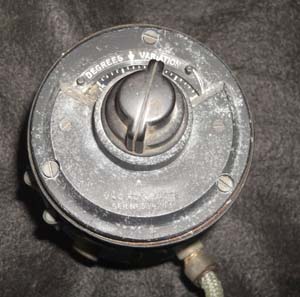
Out of stock more required please
contact me |
Variation
Setting Controller for DR Compass (Pg 5 Compasses and Clocks 57)
Here we have a Variation
Setting Controller that was used with the Distant Reading
Compass System
It Carries the Reference
Number 6B/1056 and is Dated 1943
The Knob turns but it does
not move the Dial
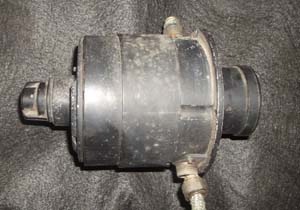
Click on
the pictures to enlarge them
|
|
Click on
the pictures to enlarge them
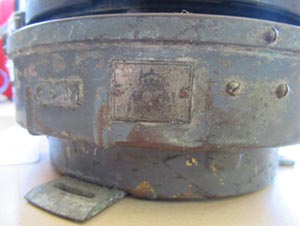
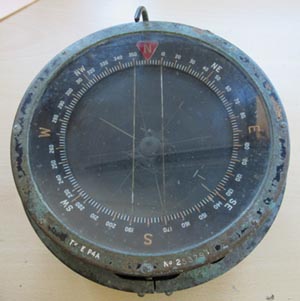 |
P4 Type E
Compass (Pg 5 Compasses and Clocks 58)
Here we have a P4 compass as
used in Lancasters and other heavy bombers.
It is very well used
with some paint loss but is complete and has a nice patina.
It no longer contains
fluid.
Type P4 E
6A/745
£155


|
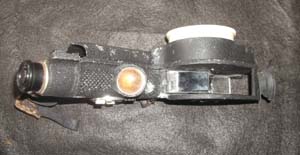 Click on
the pictures to enlarge them
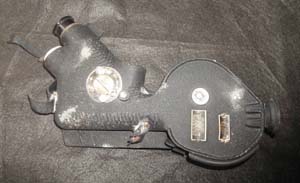
Click on
the pictures to enlarge them
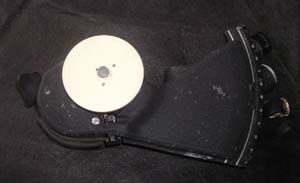
Click on
the pictures to enlarge them
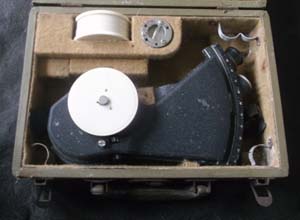 |
Type A-12 Army
Air Force Sextant (Pg 5 Compasses and Clocks 60)
Here we have a Type A-12
Bubble Sextant as used by the Army Air Force
The Sextant is in its
Original Box and is in an OK Condition
A pre
World War II sextant manufactured by the Link Aviation Co.
It was used by the military and airlines until sometime in
the 1940’s, and was the last of a line of aircraft sextants
whose design was influenced by use in open cockpit
airplanes.
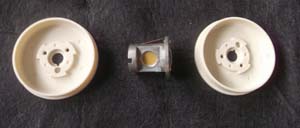
Celestial altitudes are measured by reference to an
artificial bubble horizon. The bubble is electrically
lighted for night use by standard C size batteries. The
sextant is very unique in that it has two different optical
paths that can be used. In one, the observer looks down into
the sextant and sees the reflected image of the star
overhead. We suspect this is the mode designed for open
cockpits. In the other mode, the observer holds the sextant
at arm’s length and sees the bubble reflected on a glass
surface as an illuminated ring against the night sky.
Readings are taken from a vernier scale.
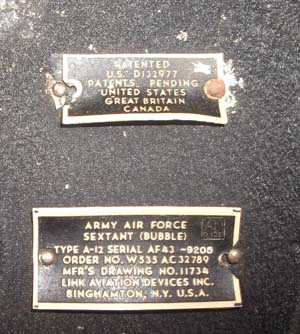
£195


|
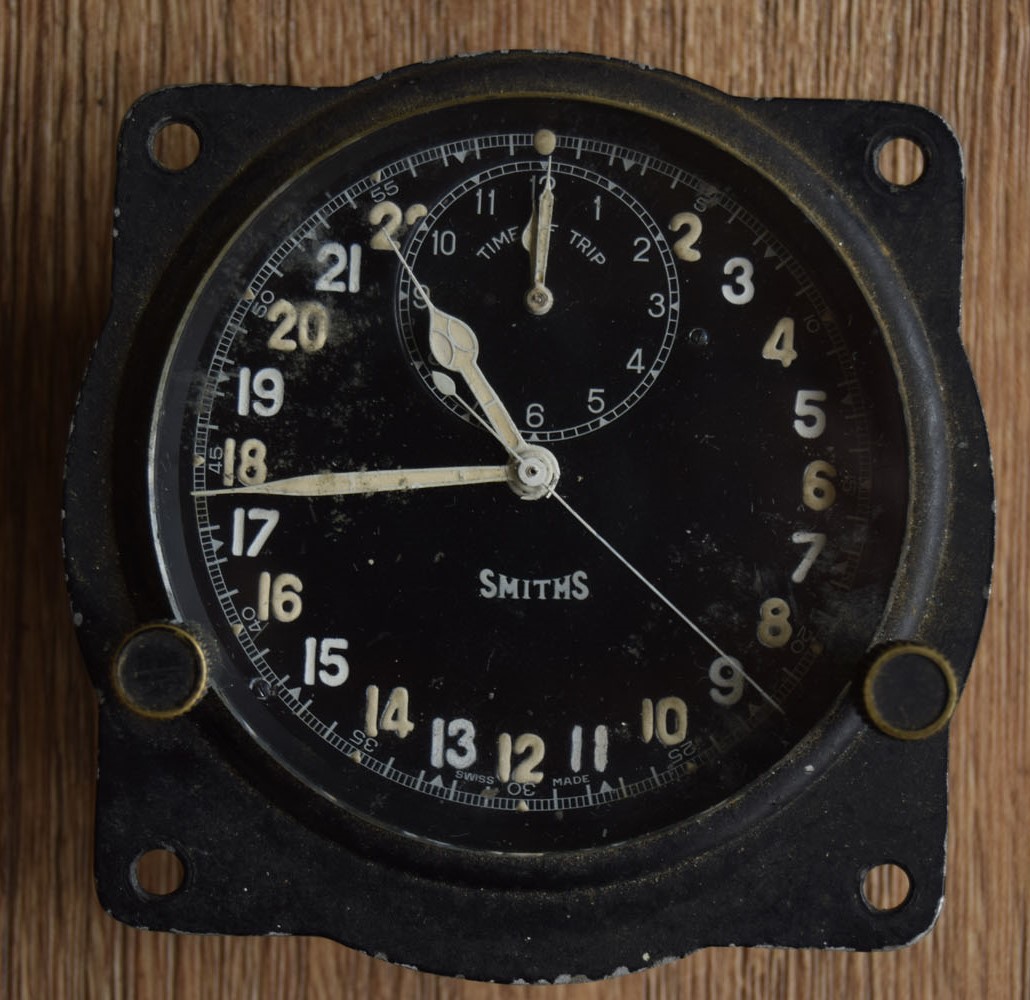
Click on
the pictures to enlarge them
|
Smiths 8 day clock (Pg 5 Compasses and Clocks 62A)
This is the classic
early 8 day clock fitted in early
Spitfire and Hurricanes along with other wartime and pre war
RAF aircraft. Runs nicely.
Unusually it does not have any
Airministry markings and may have been used in a civilian aircraft
Serial number B 169327
£895


|
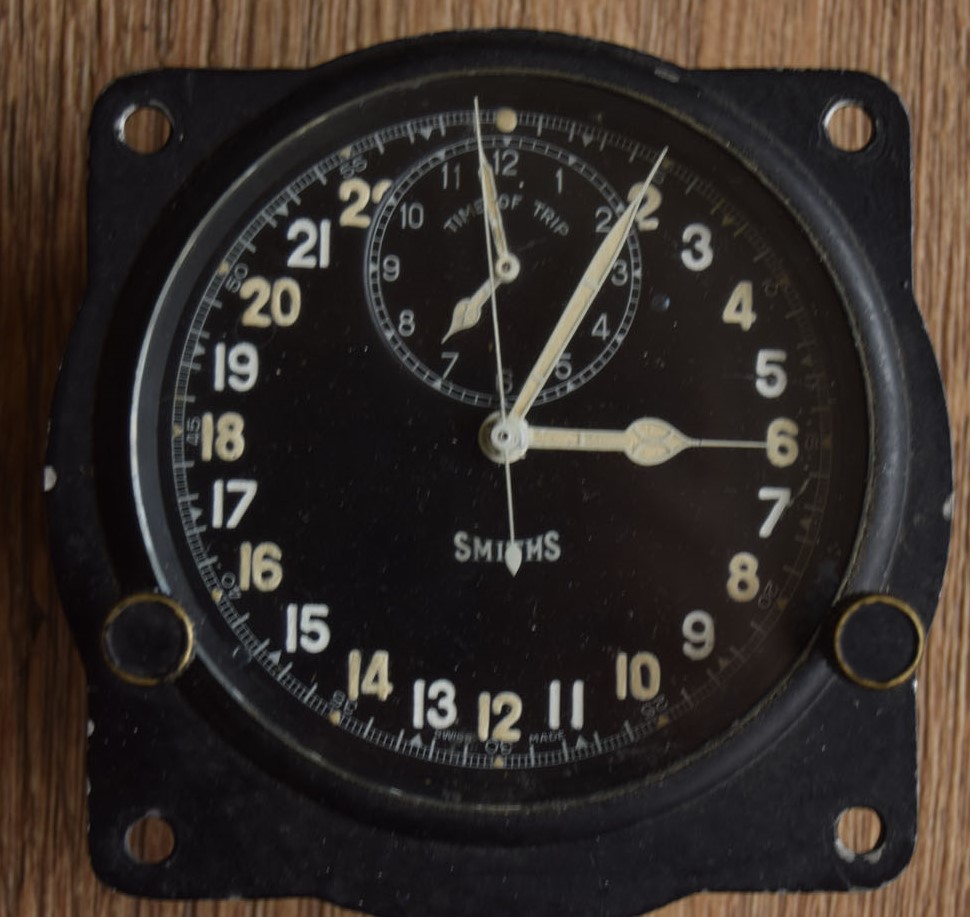
Click on
the pictures to enlarge them
|
Smiths 8 day clock (Pg 5 Compasses and Clocks 62B)
This is the classic
early 8 day clock fitted in early
Spitfire and Hurricanes along with other wartime and pre war
RAF aircraft. Runs nicely but the second does not move.
Unusually it does not have any
Airministry markings and may have been used in a civilian aircraft
Serial number B 169720
£795


|
|
Click on
the pictures to enlarge them
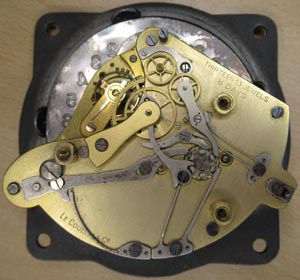
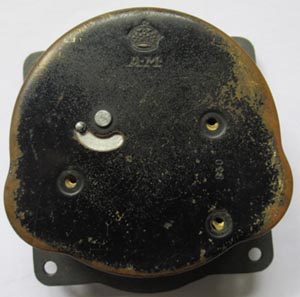
|
Smiths 8 day clock (Pg 5 Compasses and Clocks 62C)
This is the classic
early 8 day clock fitted in early
Spitfire and Hurricanes along with other wartime and pre war
RAF aircraft.
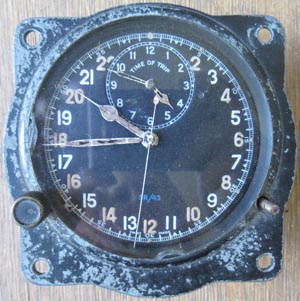
Dated 1939 with a
service date of 1942
6A/839
Unfortunately this clock
is in poor condition mechanically and only
for
display, it has two small chips on the edge of the glass but these are not
visible unless you look closely. it also has the small bolts that hold the case
on missing . However this is a rare peace and excellent for use in a panel or as
a display item.
£395


|
|
Click on
the pictures to enlarge them
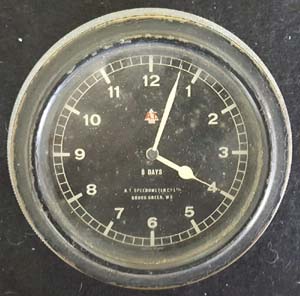
A picture of
the original advert from the 1933 catalogue.
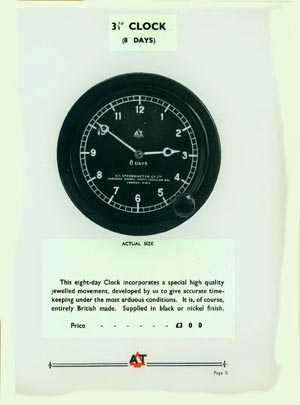
Click on
the pictures to enlarge them
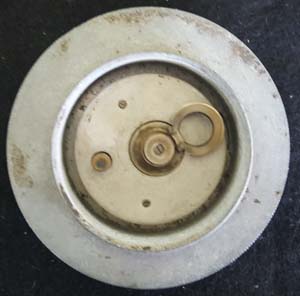
£795


|
1933 A T Speedometer Co Ltd 8 day
clock fitted to 1930s Bentley' Blowers (Pg 5 Compasses and Clocks 63)
Here is an 8 day
clock made by A T Speedometer co ltd of W6 London it is
mounted in a an alloy ring about 16mm thick .
The clock is 100 mm in diameter. Sadly
it no longer works although the hands still turn when the knob on the back is
twisted. This was an extremely high quality piece costing £3 in 1933.
The A.T Speedometer
Company Ltd of 140 Long Acre, London WC was advertising in "Flight" magazine in
July 1915 so they are one of the originals in automotive, motorcycle and
aviation instrumentation.
From
the early 1920s AT instruments were fitted to many prestige vintage cars,
including Rolls Royce, Bentley and Frazer Nash. By then, manufacture of AT
instruments had moved to West London and from October 1924 to 20 Avonmore Rd,
London W14 (pg. 36, Motorsport, October 1924)

Shown above the Supercharged Bentley
Blower
AT
had German parentage (instrument manufacturers Deuta-Werke GmbH, Berlin) and
under the newly formed Trading with the Enemy Act of 1914 company assets were
confiscated at the outbreak of war.
Ownership
passed to Smiths, then to S.D Mckellen in 1920, and to Jaeger in December 1928
who in October the previous year had been bought by Smiths.
In
1930 manufacture of AT instruments moved to the newly built Chronos Works. (pg.
82, James Nye's new book 'A Long Time in Making; History of Smiths' and pg.
42-44, 'Roadcraft' magazine published by Smiths for the 1937 London Olympia
Motor Show).
In
1931 Bentley Motors went into liquidation and was acquired by Rolls Royce. Two
years later the first Rolls Royce made Bentley car (3 1/2 Litre saloon) went on
sale. So in 1933 it is the model of car that is new not the fitting of AT
instruments to Bentley cars; this had happened ten years earlier.
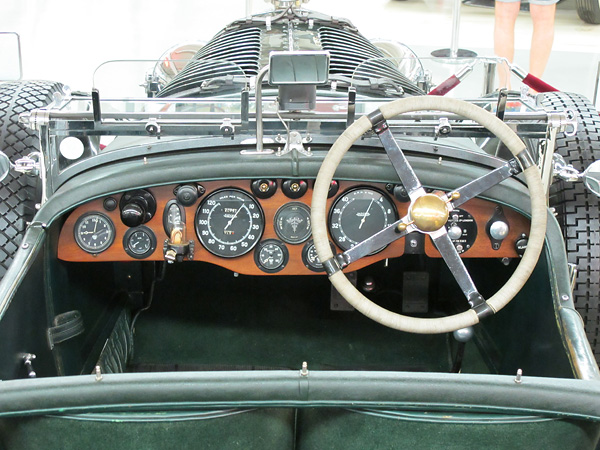
Seen above fitted in the
famous Supercharged Bentley Blower |
|
Click on
the pictures to enlarge them
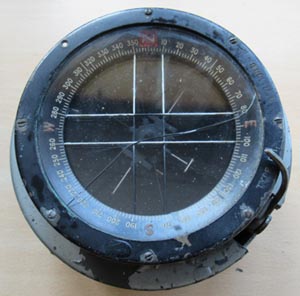
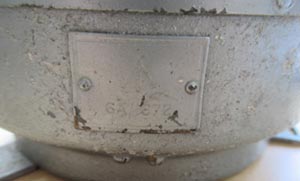 |
Type P8 Compass
(Pg 5 Compasses and Clocks 64)
Here we have a Type P8
Compass. Used in fighters most commonly found in the
Spitfire
6A/1672
It has been heavily used and
the case has been repainted silver at some time. It no longer has fluid and has
a hairline crack in the glass
£85


|
|
Click on
the picture's to enlarge them.
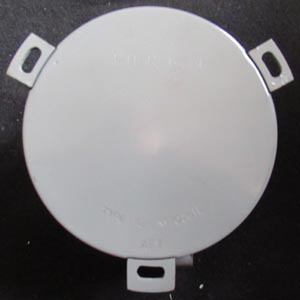
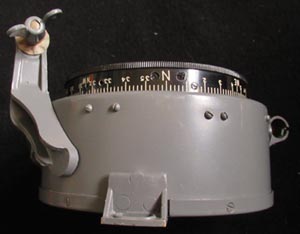
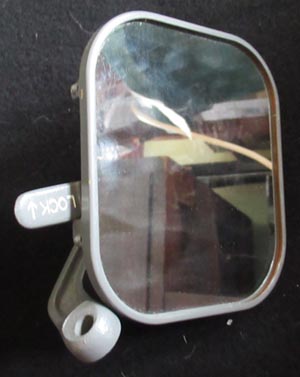
|
Type P12 compass
(Pg 5 Compasses and Clocks 67) Here
is a
almost as
new
example of the Type P12 Compass .
The P12
was unique as it was designed as an inverted compass mounted
on the roof of the cockpit , a number of aircraft used them
both RAF and RN including the Auster, Swordfish, Shakleton
and I believe the now extinct Barracuda .
It is
complete with its original box and mirror. The fact that it
was mounted inverted a mirror was used to protect the image
at almost eye lever making it less likely to incur parallax
errors..
This
example still has its original fluid and works as it should.
Click on
the picture's to enlarge them.
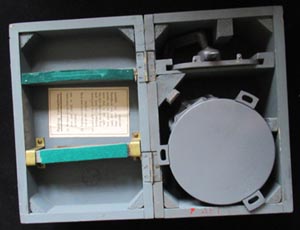 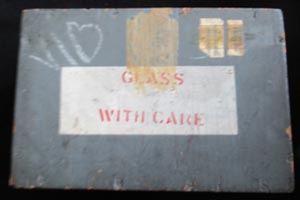 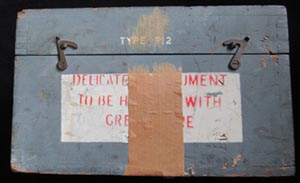 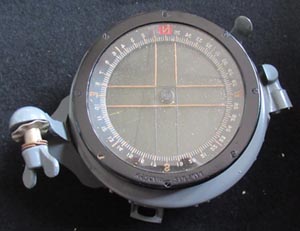
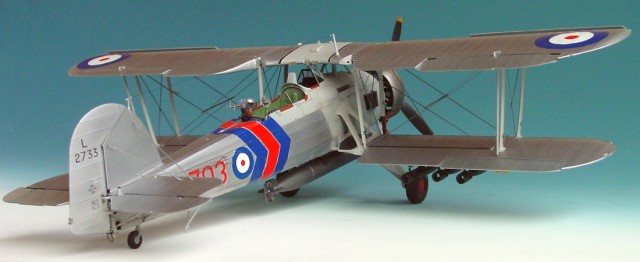 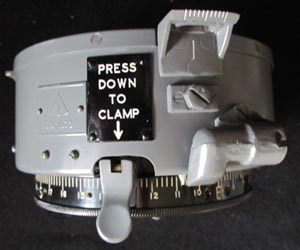 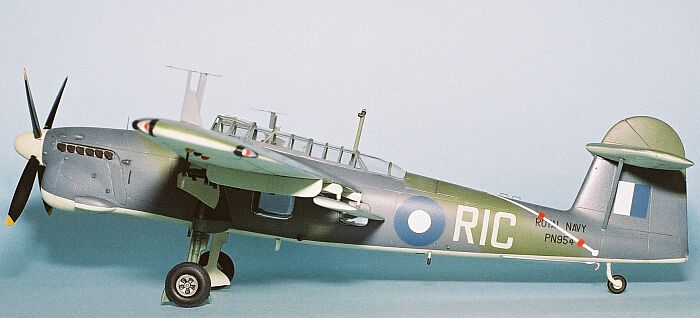
Top left the
Fairey Swordfish top right the Fairey Barracuda Here
is a
almost as
new
example of the Type P12 Compass . The P12 was unique as it
was designed as an inverted compass mounted on the roof of
the cockpit , a number of aircraft used them both RAF and RN
including the Auster, Swordfish, Shakleton and I believe the
now extinct Barracuda .
Out of
stock


|
|
|
Use the links under to navigate the
instrument pages
Page 1 Instruments home.
Page 2
Airspeed indicators.
Page
3 Altimeters.
Page four Boost gauges.
Page five Clocks and compasses.
Page Six Climb and descend.
Page 7 Directional indicators
Page 8 Fuel
gauges
Page 9 Flap Indicators
Page 10 Brake Gauges
Page 11 Oxygen gauges
Page 12 Pressure gauges
Page13 Revolution Counters
Page 14 temperature gauges
Page 15 Turn and slip and artificial
Horizon
Page
16 Undercarriage indicators
Page 17 Trim gauges
Page 18 Volt and Ammeter
|
